Going Places

Transition Guidelines for
Community-Based Physical Activities
for Students Who Have Visual Impairments,
Blindness, or Deafblindness
Lauren J. Lieberman, Ph.D.
SUNY Brockport
Scott J. Modell, Ph.D.
California State University, Sacramento
Paul Ponchillia, Ph.D.
Western Michigan University
Ileah Jackson, B.S.
California State University, Sacramento

Lieberman, Lauren J., 1965-
Going Places: Transition guidelines for community-based physical activities for students who have visual impairments, blindness, or deafblindness/Lauren J. Lieberman, Scott J. Modell.
Copyright © 2006, American Printing House for the Blind, Inc. Louisville, KY 40206-0085
All rights reserved.
Printed in the United States of America
This publication is protected by Copyright and permission should be obtained from the publisher prior to any reproduction, storage in a retrieval system, or transmission in any form or by any means, electronic, mechanical, photocopying, recording, or otherwise.
For information regarding permissions, write to:
American Printing House for the Blind, Inc.
Resource Services
1839 Frankfort Avenue
Louisville, KY 40206-0085
Catalog Number 7-13090-00
Going Places Meets National Standards
The six national content standards on physical education established by the National Association for Sport & Physical Education (NASPE) have been addressed in this fun to read resource on community-based, independent physical activities for individuals who have visual impairments, blindness, or deafblindness.
1. Competency in motor skills and movement patterns are further developed during the learning phase of a new activity and will continue to improve as specific sport tasks skills are acquired.
2. The finer understanding of movement concepts, principles, strategies, and tactics as they apply to the learning and performance of preferred physical activities will be acquired by the reader and is demonstrated in the many examples presented by the authors.
3. The authors explain clearly key elements that are needed to acquire the desire to participate regularly in physical activity.
4. Through excellent appendices on home fitness activities and nutrition, the reader learns about achieving and maintaining a health-enhancing level of physical fitness.
5. The unit on safety and self-advocacy exhibits responsible personal and social behavior that respects self and others in physical activity settings.
6. The athletes' vignettes (shared stories) demonstrate how these role models value physical activity for health, enjoyment, challenge, self-expressions, and/or social interaction.
Going Places provides individuals with visual impairments a foundation for healthy, active lifestyles that support learning, promote independence, and ensure future success.
Going Places is based on health, physical education, recreation, and social research, as is demonstrated by the citations and personally related stories. For validity it was field tested with the population for which it was intended, teenaged students and young adults with visual impairments. Sports professionals, professors teaching university vision programs, adapted physical education teachers, and itinerant and classroom teachers of the visually impaired reviewed the product as well.
"Many of our students do not participate in physical activities, even on just a social level. I believe that many are not aware what is available and how to make it happen for them. Going Places wonderfully addresses this need."
Field Test Site Coordinator
"I believe that students in early middle school and TVIs should complete this book as part of their expanded core learning. Early awareness would allow the students and TVIs time and longitudinal opportunities to explore, develop, and become engaged in the aspects covered in this book."
Field Test Site Coordinator
"I think this will be a very useful resource for teens and their parents--helping them "think outside the box" that the rest of society may want to regulate them to. There are a number of systematically applied strategies that are used by teachers, but are not readily apparent to the lay-person and definitely not the consumer (the student). Tools like the Variable Preference Table and the Activity Rating Chart will help the reader go about the business of identifying and selecting activities of interest systematically. The layout of the book seems appropriate with lots of white space, few but clear graphics, and a good font size for readers with visual impairments."
Professional Reviewer
A pre test was used to measure the students' knowledge in physical fitness, recreational activities, nutrition, safety, and self-advocacy prior to reading the book. Chapter post quizzes were administered throughout the field test period. The average pre test score was 65% and the average post test score was 87%. All students showed improvement.
"Many blind people feel participating in physical activities would be too challenging and many adults feel these activities are too risky or out of the question, but this book teaches that participation is possible. It talks a lot about transportation and methods of getting things you need rather than relying on your parents. I loved doing this project."
Student, Massachusetts
"It [Going Places] taught me that I need to know where documentation concerning my impairment is located. I also learned how to become involved in the community. I want to try golf. I really liked reading the stories about all the blind people who do the sports."
Student, West Virginia
"I am moving to a different city and love to play sports. This book gives me more ideas and shows support that people who are deafblind can do it."
Student, Wisconsin
Dedication
The authors dedicate this book to all the children who have attended Camp Abilities (NY), WAVE Camp and Camp COOL (CA), and the National Sports Education Camps, started in Michigan and now located in many states. These campers have taught us the value of physical activity and socialization. Furthermore, we would like to thank organizations and people that promote physical activity for youths with visual impairments, such as the State Commissions for the Blind, the Associations for the Blind and Visually Impaired, the National Federation of the Blind, and the United States Association of Blind Athletes (USABA).
Foreword
This book has been long over due. Physical education has often been an area neglected when it comes to children who are blind or visually impaired or who have dual sensory impairment. With obesity on the rise in the United States, it is more important than ever to promote an active lifestyle. This book outlines a step-by-step process to promote physical activity and does so in an enjoyable manner. Students, teachers, and parents will find this book as a helpful resource for getting started in sport and recreation.
The easy to use worksheets allow the individual to go through the process and figure out what activities will suit her best and what avenues to pursue. Also it highlights the barriers faced by individuals who have a sensory impairment and gives ideas on how to overcome them. In addition, there is a systematic approach on how to adapt different sports and ideas on different teaching and learning styles.
Furthermore the book promotes self-advocacy which is key for an individual to grasp so that she can relate it to other aspects of her life. All of the advantages that individuals gain from sport and recreation are finally illustrated in an easy-to-use text. The advantages of an active lifestyle that include good health, building social interactions, and self esteem, as well as learning how to be a part of a team, setting goals, and working to achieve them are captured in the athlete profiles. The authors also provide examples of this throughout the book. This book is a must have for physical educators, parents, and other teachers of students with sensory impairments. It can also be used with adults who have been sitting on the sidelines or who became blind or deaf later in life and thought that sports and recreation were no longer an option for them. The concepts in the book can be used with students who have no sensory impairment. The concepts of figuring out what activities you would enjoy and what best fits you are often overlooked in today's society. There are a vast variety of activities offered in the world today, and not everyone is aware of them. This book offers a glimpse into this vastness, and hopefully all individuals will explore the world of sport and recreation and become more active.
Jeni Armbruster
Adjunct Professor, Western Michigan University
Project Director, National Sports Education Camps
Paralympian ('92, '96, '00, '04)
About the Authors
Lauren J. Lieberman, Ph.D.

Dr. Lieberman is currently an associate professor in Adapted Physical Education at SUNY Brockport in Brockport, New York. She is the advisor of the undergraduate concentration in Adapted Physical Education and teaches both undergraduate and graduate classes. She taught and coached at the Perkins School for the Blind in Watertown, Massachusetts. She received her Ph.D. in Movement Studies in Disability from Oregon State University. At SUNY Brockport she founded and implemented Camp Abilities: A developmental sports camp for children with visual impairments and deafblindness. She has co-authored two other books: Games for People with Sensory Impairments: Strategies for Inclusion and Case Studies in Adapted Physical Education. Dr. Lieberman continues to run programs and conduct research in the area of physical activity and children with sensory impairments.
Scott J. Modell, Ph.D.
 Dr. Modell is an associate professor at California State University, Sacramento. He is nationally recognized for his work in developing and providing community-based sport, recreation, and leisure programs for persons with disabilities. Over the past 10 years, Dr. Modell has been publishing and presenting his work in professional journals and at international, national, and state conferences. He has received numerous awards and citations at the state and national level for his service contributions to the community.
Dr. Modell is an associate professor at California State University, Sacramento. He is nationally recognized for his work in developing and providing community-based sport, recreation, and leisure programs for persons with disabilities. Over the past 10 years, Dr. Modell has been publishing and presenting his work in professional journals and at international, national, and state conferences. He has received numerous awards and citations at the state and national level for his service contributions to the community.
In the summer of 2000, he founded and currently directs WAVE Camp: A water adventures camp for young adults with physical disabilities. In the winter of 2002, Dr. Modell also founded and currently directs Camp COOL: A winter sports camp for young adults with physical disabilities.
Paul Ponchillia, Ph.D.
 Dr. Ponchillia is Chairperson of and a professor in the Department of Blindness and Low Vision Studies at Western Michigan University (WMU). He grew up in the YMCA sports programs and became an avid athlete, participating in football, basketball, baseball, and track and field. He lost his vision at the age of 30. Dr. Ponchillia played over 2,000 games of goalball from 1982 through 1998 and continues to coach the Michigan youth team. Dr. Ponchillia became aware of how students with visual impairments received poor physical and sports education in public schools, and founded the Michigan Sports Education Camp in 1988. He and his WMU and USABA colleagues won a $500,000 grant from the U.S. Department of Education that helped them establish sports camps in 11 other states, and they plan to increase this number in the next 5 years.
Dr. Ponchillia is Chairperson of and a professor in the Department of Blindness and Low Vision Studies at Western Michigan University (WMU). He grew up in the YMCA sports programs and became an avid athlete, participating in football, basketball, baseball, and track and field. He lost his vision at the age of 30. Dr. Ponchillia played over 2,000 games of goalball from 1982 through 1998 and continues to coach the Michigan youth team. Dr. Ponchillia became aware of how students with visual impairments received poor physical and sports education in public schools, and founded the Michigan Sports Education Camp in 1988. He and his WMU and USABA colleagues won a $500,000 grant from the U.S. Department of Education that helped them establish sports camps in 11 other states, and they plan to increase this number in the next 5 years.
Ileah M. Jackson, B.S.
 Ms. Jackson is an adapted physical education teacher in Sacramento, California. She is actively involved in the provision of sport, recreation, and leisure activities for children and young adults with disabilities. Ms. Jackson has presented at numerous international and national conferences on topics related to increasing the quality of life for persons with disabilities through involvement in community-based sport and recreation. She has also been recognized by California State University, Sacramento, as an outstanding contributor to the betterment of the lives of persons with disabilities in the community.
Ms. Jackson is an adapted physical education teacher in Sacramento, California. She is actively involved in the provision of sport, recreation, and leisure activities for children and young adults with disabilities. Ms. Jackson has presented at numerous international and national conferences on topics related to increasing the quality of life for persons with disabilities through involvement in community-based sport and recreation. She has also been recognized by California State University, Sacramento, as an outstanding contributor to the betterment of the lives of persons with disabilities in the community.
Project Contributors
Professional Reviewers:
Jennifer Armbruster, Western Michigan University, National Education Sports Camps, Paralympian
Janet Seaman, PED, MBA, CAPE American Association for Active Lifestyles and Fitness, American Alliance for Health, Physical Education, Recreation & Dance.
Field Test Site Coordinators
Cynthia Essex, Perkins School for the Blind, Massachusetts
Roy Martz, Texas School for the Blind and Visually Impaired
Patricia Meyers, Jackson County Schools, West Virginia
Dan Wenzel, Wisconsin School for the Visually Handicapped/Wisconsin Center for the Blind and Visually Impaired
Students from Massachusetts, Texas, West Virginia, and Wisconsin
American Printing House for the Blind, Inc.
Project Leader/Research Associate:
Tristan Pierce
Project Assistant/Research Assistant:
Ann Travis
Research Assistants:
Monica Vaught
Tessa Wright
Graphic Design:
APH Research Graphic Design Services
Preface
This book is designed and written for young teens with visual impairments (VI teens) but can be enjoyed by persons of any age, sighted or visually impaired.
The premise of this project is that most VI teens get little or no physical activity, which develops into a pattern of no activity in adulthood and leads to future obesity and health problems. Many VI students attending public schools are not afforded the many opportunities to participate in games and organized sports that sighted peers are afforded. Perhaps you have found yourself in this situation. This may be due to the lack of physical education teachers who are trained in Adapted Physical Education, liability fears on the part of the school or school district, or misperceptions by parents that their child can not rock climb, ice skate, or participate in team sports. If you are a VI teen attending a residential school for the blind and visually impaired, you are provided with coaches and athletic facilities on campus. Most residential schools have wrestling, track and field, swimming, cheerleading, and sometimes goalball. Upon graduation from the school, the swimming pool and track are no longer just down the sidewalk from your dorm room, nor is the wrestling coach waiting in the gym for you each afternoon. While the support system remains for students still on campus, you have moved on to college or you have joined the work force. Where do you go now to learn new activities; activities where you can meet new friends, have fun, stay fit, and continue to learn about life?
The purpose of this book is to introduce you to community-based, independent physical fitness activities. Independent is the key word. It refers to you taking the initiative, you doing the research to learn about an activity, you going on-site to visit a community or private facility, you talking to people who already participate in your selected activity, you finding solutions to logistics (cost, transportation, and equipment), and eventually you learning the activity through personal experience.
The second unit of the book is designed to help you learn about safety and self-advocacy. You will learn the importance of educating the general population who may have the misconception that persons with visual impairments can not live fun, exciting, and adventurous lives. We recommend that you share this section with your parents, coaches, teachers, and friends.
Interspersed in chapter 3 are vignettes (short personal stories) of individuals who are blind, deafblind, low vision, and/or have multiple disabilities, who participate in sports as part of their lifestyle. The storytellers range from teenagers to senior citizens, demonstrating that physical activity is important throughout life; not just for teens and young adults. Each and every one of our storytellers is an excellent role model. They are not superstars or Olympic gold medal winners. But neither are most sighted athletes. Whether sighted or blind, persons who have an active lifestyle are healthier and feel better about themselves and the world in which they live.
Tristan G. Pierce
Research Associate
American Printing House for the Blind

Unit One
Be Physically Active
Chapter 1:
Introduction
This guidebook is designed to assist teens and young adults with visual impairments to become physically active and stay physically active throughout their lives. Physical activity is an umbrella term that includes physical fitness, aquatics, sports, recreation, and physical education. The steps to becoming and staying physically active are in the title PLACES.
P stands for Preferences. It is important to determine the activities that you enjoy or you might enjoy doing, and have access to in order to set up your physical activity program. This chapter helps you identify variables that you like in order to help you determine if you are best suited for outdoor recreation, competitive sports, or structured physical routines.
L stands for Leisure, Sport, and Fitness. Leisure time is the time that you have free from school, work, or chores. This is the time that you can fill with your preferred physical activity. This chapter describes many community-based activities that may interest you.
A stands for Awareness. Awareness means that you have researched and learned about available activities and sports that you think you might enjoy the most.
C stands for Choices. After you decide what activities you enjoy that are available to you in your community, you can make informed choices about which activities and sports to pursue in your free time.
E is for Exploration. This is when you have the opportunity to focus on the few activities you will participate in during your leisure time. Determine which ones are most enjoyable, accessible, and meet your physical and social needs.
S is for Skill Development. Once you have determined the activities that you enjoy doing and have joined a program, team, or club, you can then continue to improve on the skills it takes to feel good about your future participation in those activities.
Importance of Physical Activity
Physical activity is extremely important for everyone, and especially for individuals who are visually impaired, blind, or deafblind. Fitness is one component of physical activity that includes activities that increase your heart rate for a long period of time (15-30 minutes). Examples of fitness activities are walking, running, bicycling, swimming, aerobics, cross-country skiing, and hiking. Fitness activities can also include activities where you work on your flexibility (such as stretching) or muscle strength (such as weight training, push-ups, or sit-ups). Physical activity that involves fitness can help you maintain your weight, decrease your chances of having a heart attack or getting diabetes, and increase your ability to perform activities of daily living. Studies have shown that individuals with visual impairments are behind their sighted peers in health-related fitness (Lieberman & McHugh, 2001). Some people can not comfortably do activities of daily living. Furthermore, people with visual impairments often use more energy to function each day. Using your cane, looking for light switches, locating a chair, or walking from place to place takes energy. The truth is that you probably need more energy or a higher level of fitness to conduct your every day needs. You should have 30-60 minutes of accumulated activity everyday. As you can see, being involved in physical activity that includes a fitness component is important.
 Physical activity that involves teams, pairs, or socialization is important, too. Many studies have shown that individuals who are visually impaired or blind are not satisfied with their level of friendships (Kef, 1997; MacCuspie, 1996). Often people who are visually impaired have limited socialization with peers, and may feel lonely or isolated (Blinde & McCallister, 1998; Goodwin, 2001; Taub & Greer, 2000).
Physical activity that involves teams, pairs, or socialization is important, too. Many studies have shown that individuals who are visually impaired or blind are not satisfied with their level of friendships (Kef, 1997; MacCuspie, 1996). Often people who are visually impaired have limited socialization with peers, and may feel lonely or isolated (Blinde & McCallister, 1998; Goodwin, 2001; Taub & Greer, 2000).
Participating in physical activity that includes socialization helps you develop and maintain lasting friendships with peers who have similar interests.
In addition to increasing your socialization, involvement in physical activity can assist you with academics as well. Being involved in physical activity can assist with academics for two reasons. Current research has shown that the more active students are the better their scores on academic tests (Kun, Vigil, & Wilson-Graham, 2002). So, if you are more involved in physical activity, you may get better grades in school and on exams. Being physically active often assists students in staying focused and paying attention. Being able to focus and pay attention can also help improve your knowledge and success in your academic setting!
Physical activity can help you with your future employment in many ways. First, some jobs are physical jobs. These jobs may include lifting objects, delivering items, or working on an assembly line. If you are physically fit, you will be able to endure a full day of physical work as opposed to a worker who is not fit. Second, physical activity can assist with employment perception. If an employer sees a person who is unfit, becomes tired with little effort, or is extremely overweight, they may perceive that the person can not perform the job at hand. If an employer sees a potential employee who can ride a bike 20 miles, walk 10 miles, or who is involved on a sports team, they are more likely to believe that the potential employee is fit enough for the job and is a team player who can work well with co-workers. Third, time management is important for employment (and academics). You demonstrate good organizational skills when you successfully juggle sports and work (or school). Last, a potential employee who is involved in physical activity is likely to be a person who feels good and has a high level of self-confidence. This feeling of self-confidence can generalize to an interview and to a potential job. An employer would prefer to have an employee who feels good about himself rather than one who is depressed or who has poor self-confidence.
Physical activity is essential for the best possible quality of life. As you can see from this chapter, being involved in physical fitness can assist with improvements in health, socialization, academics, and future employment.
This guidebook will help you access the physical activities that are most interesting and enjoyable to you. It is the authors' hope that your involvement in physical activities will improve the perceptions of individuals who are visually impaired toward physical activity and help you improve your own perception of your potential.

 Participants Who Are Deafblind
Participants Who Are Deafblind
If you have a visual impairment and are hard-of- hearing or deaf, this guidebook also applies to you. The suggestions and ideas for individuals who are visually impaired are relevant for those who are deafblind. In instances where an individual who is deafblind may need additional information or assistance, it is noted in a box titled, "Participants Who Are Deafblind."

References
Blinde, E.M., & McCallister, S.G. (1998). Listening to the voices of students with physical disabilities. Journal of Physical Education, Recreation, and Dance, 69(6), 64-68.
Goodwin, D.L. (2001). The meaning of help in PE: Perceptions of students with disabilities. Adapted Physical Activity Quarterly, 18(3), 289-303.
Kef, S. (1997). The personal networks and social supports of blind and visually impaired adolescents. Journal of Visual Impairment & Blindness, 91(3), 236-245.
Kun, P.K., Vigil, D., & Wilson-Graham, D. (2002, December 10). New study proves physically fit kids perform better academically. Retrieved March 17, 2004, from http://www.actionbasedlearning.com/cgi-bin/article02.pl
Lieberman, L.J., & McHugh, B.E. (2001). Health related fitness of children with visual impairments and blindness. Journal of Visual Impairments & Blindness, 95(5), 272-286.
MacCuspie, P.A. (1996). Promoting acceptance of children with disabilities: From tolerance to inclusion. Halifax, Nova Scotia: Atlantic Provinces Special Education Authority.
Taub, D.E., & Greer, K.R. (2000). Physical activity as a normalizing experience for school-age children with disabilities: Implications for legitimation of social identity and enhancement of social ties. Journal of Sport and Social Issues, 24, 395-414.
Chapter 2:
Preferences
The word preference comes from the word prefer. Prefer means what you like. There are many variables that are involved in what we like such as how social an activity is, how physical, how competitive, or how far we have to travel to engage in it. In order to find the physical activities most appropriate for you, it is important to address these preferences. If you have engaged in physical activities before, you may know which ones you like and do not like. This will help you in your pursuit of your future activities. With your previous experience in mind and focusing on what you might like, fill out the Variable Preference Table in this chapter to help you determine what variables in physical activities are most appropriate for you.
If you have not engaged in physical activity before, please go to the Leisure chapter to find out which physical activities are most appropriate and enjoyable for you. Then come back to this chapter and fill out the form.
You may wish to photocopy the table so you can use it again or share it with teachers, family, and friends. Braille readers may want to use APH Feel 'n Peel Stickers (#1-08846-00) to fill out the form.

 Participants Who Are Deafblind
Participants Who Are Deafblind
 You may require a support service provider (SSP), intervener, or interpreter to successfully participate in these activities. From now on we will refer to the communication support person as the interpreter.
You may require a support service provider (SSP), intervener, or interpreter to successfully participate in these activities. From now on we will refer to the communication support person as the interpreter.
When filling out the Variable Preference Table, assume that you will have all the supports necessary. Finding the supports will be covered in chapter 4, Awareness.

Variable Preference Table
To complete the Variable Preference Table place a 0, 5, or 10 in the box next to each question.
0 = None/Not at all; I am not interested.
5 = Somewhat; I want to learn more.
10 = A lot/very much so; I definitely want that variable.
Variable Preference Table
(Photocopy as needed or use the CD version.)
| Variable | Level of Preference |
|---|---|
| Socialization - How social would you like the activity? | |
| Fitness activities - How strenuous would you like the activity? | |
| Competitive level - How competitive would you like the activity? | |
| Distance traveled - How far are you willing to travel for this activity? | |
| Team sport/activity - Would you like the activity to be a team sport? | |
| Dual sport/activity - Would you like the activity to be competing against just one other person? | |
| Individual sport/activity - Would you like an activity that is done predominantly by yourself? | |
| Outdoor recreation - Do you like activities that are done predominantly outdoors? | |
| Inside activities - Do you like activities that are done predominantly indoors? |
When thinking about your preferred activities, it is important to consider how you would like to be taught the skills for the activity. For individuals with visual impairments, skills can be taught in one of four teaching methods or a combination of several ways:
Verbal instruction
Modeling - The instructor shows you how to perform a skill.
Tactile modeling - You feel the instructor or a peer executing the activity to better understand the activity.
Physical guidance - The instructor moves your body parts through the skill to teach you the skill.
As you choose your most preferred activities, it is important to think about how you want to be taught so you can share your preference with the instructor.

 Participants Who Are Deafblind
Participants Who Are Deafblind
If you are deafblind you must think about how you want to be taught, but you also need to think about how you will communicate during your chosen activities. It is usually more comfortable for you, your instructor, and the interpreter if this is discussed before the start of activities.
Variables to consider:
|
 |
 |
If you are nervous, uncomfortable, or do not understand the purpose or objective of the activity, it is fine to express that and to ask questions.

Please remember that physical activity is a continuous process. Although you are now working with the above variables within activities, you can always add more variables that you discover or discontinue those with which you have lost interest. The important thing is that you find the physical activities that you love and continue to be active throughout your life.
Keep your preferences in mind because you will be choosing the activities you want to try at the end of the next chapter.
Chapter 3:
Leisure, Sport, and Fitness Activities
In the previous chapter you identified your preferred activity variables. Now it is time to learn about the many community-based activities available to you that match your variables. This chapter is designed to provide you with more details about each of these activities. Some of the activities are described in detail to give you
- a better understanding of the activity,
- the physical characteristics required to participate successfully in that activity,
- how and where you might develop the skills needed to participate (this includes similar activities that may be offered in your physical education classes),
- the different types of participation (recreational, competitive), and
- the social component of each activity.
The activities described in detail were randomly chosen and are just a starting point. All of the activities have equal value and those not described in detail are there for you to learn more about. Do the research. Go online, read books and sport journals, talk to people, or attend an athletic event.
As you read this chapter, you need to keep in mind several things. First, you will see references to Appendix A. Appendix A contains a list of fitness and performance activities that you can do at home to develop the physical skills listed under each activity.
Second, we would like you to be familiar with the highest level of sports participation: The Paralympics. The Paralympics is a sporting event that is held every 2 years, alternating summer and winter games. The event takes place 2 weeks after the Olympic Games at the same site. To compete in the Paralympics, athletes must qualify by meeting a certain standard in national competitions. At the Paralympics, athletes compete against athletes from all over the world. The Paralympic summer and winter games offer a multitude of events for persons who are blind or visually impaired. The sports are athletics (track and field), cycling, equestrian, goalball, judo, swimming, alpine skiing, and nordic skiing.
To compete in any blind sport, you will be assessed to determine your visual classification. The International Blind Sports Federation (ISBA) uses the following classifications:
B1 No light perception in either eye up to light perception, but inability to recognize the shape of a hand at any distance or in any direction.
B2 From ability to recognize the shape of a hand up to visual acuity of 20/600 and/or visual field of less than five degrees.
B3 From visual acuity above 20/600 up to visual acuity of 20/200 and/or a visual field of more than 5 degrees and less than 20 degrees.
The United States Association of Blind Athletes (USABA) has an additional classification.
B4 From visual acuity above 20/200 and up to visual acuity of 20/70 and a visual field larger than 20 degrees.
Third, the American College of Sports Medicine (ACSM) identifies four fitness components that we refer to for activity benefits and desired characteristics.
Cardiovascular Fitness is the ability of the heart and lungs to deliver oxygen to the cells to meet the demands of prolonged physical activity.
Muscular Strength and Endurance refers to the abilities of your muscles to produce force over a period of time. This includes lifting weights and/or moving your body parts with some resistance.
Flexibility refers to your ability to bring a limb through its full range of motion in the joints.
Body Composition is your ratio or percentage of muscle weight and body fat.
Understanding the basic components of fitness will help you determine which activities will best meet your needs and preferences.
All activities in this chapter have a basic description, an explanation of needed physical characteristics, and where to develop skills for that particular activity. Some activities have suggested modifications and have been rated on socialization, physical activity exertion, level of inclusiveness, and level of participation. By reviewing the already rated activities, you should be able to learn to rate your chosen activities yourself. Use the Rating Key to rate your preferred activities.
Rating Key
(Photocopy as needed or use the CD version.)
- Social: 1-5 (5 being the most social)
- Physical Activity Exertion: 1-5 (5 being the highest)
- Level of Inclusiveness: 1-5 (5 being most inclusive of all types of disabilities and nondisabled)
- Level of Participation Opportunities: 1-51 - Competitive, ex. USABA
2 - Interscholastic/Intercollegiate
3 - Intramural
4 - Community-Based
5 - Everyday/Home
Activity Rating Chart for___________________________________________________
| 1 | 2 | 3 | 4 | 5 | |
| Social | |||||
| Exertion | |||||
| Inclusiveness | |||||
| Participation |
Remember that the descriptions are only the beginning. In the next chapter, once you have decided which activities you will pursue, it will be up to you to find out more about your activity choices by researching the availability in your area, transportation needs, costs, equipment needs, and any modifications that you personally might need to be successful. Keep in mind, some activities will require no modifications while others may require many. The number and type of modifications you need will depend on your individual needs, mode of communication, and the activity. At the end of this chapter, you will be asked to fill out the Preferred Activities Chart. This table will be your list of the activities that are most appealing to you. You will have several opportunities to revise this list as you go through the book. Are you ready? Let's begin!

 Participants Who Are Deafblind
Participants Who Are Deafblind
The social level of an activity is determined by the potential opportunity for socialization during that activity. In some cases you may need to make an extra effort to gain the highest social benefit from an activity. Advocating for an interpreter (See chapter 2 on awareness and unit 2 on advocacy), recruiting friends and family who sign, and teaching active participants sign are just a few ways to ensure all the intended social benefits of an activity.

Fitness Activities
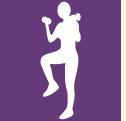
Aerobics
Description
Aerobics incorporates stepping, jumping, and turning movements to the beat of music. Both your arms and legs are in continuous motion. Aerobics is a great way to develop cardiovascular endurance and muscular strength. Most communities offer aerobic classes at community centers, fitness centers, universities, and community colleges. Aerobic classes can be identified as low impact (slower, less jumping, one foot remains on the floor) or high impact.
Modifications/Suggestions
- clear, precise descriptions
- carpet square taped to the floor for continuous orientation
- Both Ann Morris Enterprises and the American Council for the Blind sell aerobic tapes.
Activity Rating Chart for Aerobics
(If needed, refer back to the Rating Key.)
| 1 | 2 | 3 | 4 | 5 | |
| Social | X Home |
X Community Class |
|||
| Exertion | X | ||||
| Inclusiveness | X | ||||
| Participation | X | X |
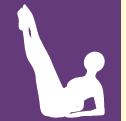
Pilates
Description
Pilates is a full body-conditioning program comprised of a series of designed movements. Pilates strengthens the muscles that support the core muscles (neck, shoulders, abdominals, hips, and thighs). This helps to realign the spine to increase strength and flexibility in the core muscles and decrease tension. Pilates focuses on improving flexibility and strength for the total body without building bulk.
Pilates is typically done on a mat. Some people are not strong enough to do the mat exercises, so several machines were developed to supplement the mat work. Pilates is designed for persons of all fitness levels.
Modifications/Suggestions
- clear, precise descriptions
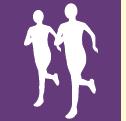
Running
Description
Many people participate in running for pure enjoyment. Others participate for competition. Most often competition is available in "road races" that are usually between 3 and 10 kilometers in distance. Running allows you to enjoy the outdoors while developing cardiovascular endurance. You run at your own pace making it available to people of all fitness levels. As you become more physically fit, you can run at faster paces and further distances to increase your cardiovascular level. Some runners will need a guide. For more information on guides, visit: www.campabilities.org/powerpoint/blindrunner/index.htm
Modifications/Suggestions
B1
Use a guide runner. Guide and blind runner hold opposite knotted ends of a one-foot length of rope loosely between second and third fingers. Do not wrap around fingers or wrist, since a fall could dislocate a joint. Start by walking and then running on a smooth running surface. The guide runs a half-step ahead in lane one and with the runner behind the right shoulder. Guide should give runner only minimal information about conditions, such as need to pass slower runners, etc. Lengthen rope as runner gains confidence, since longer rope allows a more natural arm swing.
B2 and B3
Runner follows guide who is wearing an easily visible color shirt. Guide places self in the "good visual spot" of the runner. Use smooth, safe surfaces underfoot in the beginning to avoid tripping; gradually move to sidewalks, etc. Guide gives feedback about conditions underfoot.
If runner has enough vision to run safely without a guide, use inside lane to make it easy to visually follow the curb/grass line. Practice moving from lane to lane, with the head down, watching the lane lines.
- tether
- guide wire
- treadmill for indoor running
Physical Characteristics Needed
Minimal cardiovascular endurance is needed for running.
Running will increase endurance and reduce body fat. See Appendix A.
Where To Develop Skills for Running
School
Aerobics, fitness walking, cycling, swimming, track and field, cross-country skiing
Home
Roads, trails, track, backyard circular running
Community
Running clubs, running tracks at community centers, YMCAs, YWCAs
Activity Rating Chart for Running
| 1 | 2 | 3 | 4 | 5 | |
| Social | X Individual |
X Running Club |
|||
| Exertion | X | X | X | X | |
| Inclusiveness | X | ||||
| Participation | X | X | X |
VIGNETTE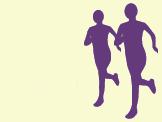
Running: Jamie Weedman

Retinopathy of prematurity caused my blindness when I was very young. At age 20, I still have light perception in one eye.
Prior to starting kindergarten at the Kentucky School for the Blind (KSB), I attended two different Montessori preschools. From elementary school through high school, I spent half my day at KSB and the other half attending a public school. I especially liked Central High School's Law Magnate Program during my junior and senior years. The summer before my senior year I attended the University of Evansville for a summer college program--living away from home for the first time.
I currently attend Jefferson Community College and plan to major in psychology. I enjoy being a DJ as a hobby.
I ran on the KSB track team for 5 years, but before that I ran with my father, who introduced me to running. While on KSB's track team I had it easy. Running partners were provided, and the track was equipped with guide wires.
Now I run on a treadmill and outside, depending on the availability of a running partner. I am currently running with a partner, Dave Gassman, who is involved with the Iroquois Hill Runners Club. I have been invited to join the club. I anticipate participating in many races with club members and in a variety of social situations. For 2 years now I have been running in a 5-mile race to raise money for Visually Impaired Preschool Services (VIPS), the organization that helped me when I was 2 years old.
My goal is to run faster and eventually compete in a marathon. I would like to compete in the running events sponsored by the United States Association of Blind Athletes (USABA).
My advice to beginning runners is to start slowly and make sure you set a reasonable goal. Find a partner who is as serious as you about running. Contact local running clubs or the USABA.

Swimming
Description

Do you enjoy the water? Then swimming may be for you. Millions of people each year participate in swimming activities. From playing in a backyard pool to competing in the Olympic Games, swimming offers all individuals the opportunity to develop increased fitness. There are many ways to develop swimming skills including your physical education class, YMCA/YWCA, church groups, community colleges and 4-year universities, or other community-based classes. Competition can range from community-based to interscholastic to blind sport.
In competition, swimmers compete in the sight classifications as defined by the USABA. In B1 competition, swimmers must wear darkened goggles. A team coach directs the takeover for relays, as the swimmers may not be able to see their teammate approaching. Allowances are made in the rules for B1 swimmers who may be too close to a lane line to execute technically correct arm strokes or touches in butterfly or breast stroke. For more information on Blind Swimming, visit: http://www.usaba.org/Pages/sportsinformation/adaptations/swimadapt.html or http://www.ibsa.es/eng/deportes/swimming/presentacion.htm.
Modifications/Suggestions
- sound source at each end of pool
- tapper for relays or lap swim
- garden sprinkler to spray swimmer nearing the end of the pool

Tai Chi
Description
Tai Chi is regarded as a complete martial art. It is taught in many different ways. Tai Chi is a relaxing form of gentle exercise consisting of a series of slow rhythmic movements. It is practiced by tens of thousands of people throughout the world. Tai Chi is designed for learners of all fitness levels and abilities. Tai Chi promotes natural posture by aligning the head, spine, and pelvic girdle. It can be done at home or at a fitness club or community center. The International Taoist Tai Chi Society publishes a book on wheelchair movements. http://www.taoist.org
For detailed verbal descriptions of Wu style Tai Chi Chuan movements visit: http://www.5medicines.com/wu4youLN1.htm.
Modifications/Suggestions
- clear, precise descriptions
VIGNETTE
Tai Chi: Michelle J. Smithdas
 My name is Dr. Michelle J. Smithdas. I am the eldest of eight siblings. All siblings could see and hear except one brother who was deaf and gradually lost vision due to Usher syndrome, and another brother who is hard-of-hearing. I was also hard-of-hearing until the age of 16, when I became deaf.
My name is Dr. Michelle J. Smithdas. I am the eldest of eight siblings. All siblings could see and hear except one brother who was deaf and gradually lost vision due to Usher syndrome, and another brother who is hard-of-hearing. I was also hard-of-hearing until the age of 16, when I became deaf.
In 1972, I was diagnosed with optic atrophy following a severe concussion sustained in a snowmobile accident the previous year (my senior year of college). I am now deafblind.
Because of my hearing impairment, I attended special classes, using a school bus, whereas my siblings rode bicycles to regular school classes. They played games going to and from school, and I was jealous because I did not understand why I couldn't go to the same school with them. My parents said that if I wanted to try, I could go to the regular school classes, and change back to special classes if it did not work out.
So I decided to try regular school. I went to special classes in the morning, then mainstreamed in regular classes in the afternoons. I loved transferring between the two schools. When my hearing became worse, I had to squirm at my desk to follow teachers who walked around the room while talking, which made it hard for me to read their lips. Ultimately, I was transferred to the California School for the Deaf at Riverside.
At Riverside I started to integrate into life as a deaf person. I learned the one-hand manual alphabet--also called finger-spelling--and American Sign Language (ASL). After finishing high school, I went on to Gallaudet University for the deaf, majoring in mathematics.
While recovering from the snowmobile accident at home, I realized I must go on with life--that I couldn't stay at home and be dependent on others. I was encouraged to attend the Helen Keller National Center (HKNC) for Deaf-Blind Youths and Adults, located in Sands Point, New York. At that time, with so little known about the potential of people with deafblindness, it was difficult for a deafblind person to find a job and be a real part of community life. Later, after completion of my training, the HKNC hired me to work as an instructor in its Communication Learning Center. The concentration of my work is on teaching reading and writing.
I must add that when I attended my training at HKNC, I was nervous and a bit scared because it was the first time that I went to New York as a deafblind person. When I arrived at the HKNC, the lighting was not very bright; and the hallway was almost dark. I walked slowly, feeling unsure of myself. Not being able to see well in the dim area, I bumped into a person who certainly seemed sure of where he was going. It turned out to be my future husband, Dr. Robert V. Smithdas. Instead of love at first sight, you could say it was love at first bump.
While working at HKNC, I became friends with a volunteer braillist, Linda Stillman. I told her of my desire to go back to school for a master's degree in special education so I could be of greater help to my deafblind students. Amazingly, she was intrigued with the idea, and she offered to be my helper at Teachers College, Columbia University. She was my special friend who went to classes with me and interpreted discussions for 5 years of evening classes. Learning about working with students in special education, with emphasis on blindness, braille, and resources for helping such people, was invaluable, and I use what I learned constantly in my own teaching. I have since received an honorary doctorate degree from Mt. Aloysius College.
I learned about Taoist Tai Chi from HKNC's in-house weekly paper IN-TOUCH, which is available in braille and large type. Since I love any exercise that strengthens and helps to improve my muscles and bones, I went to inquire about the program. Since I am deafblind and have a balance problem, it was decided that the best way for me to benefit from the Tai Chi classes was to be taught individually. Thus, the instructor could fully concentrate on me and help me as much as she could. The instructor was working full-time at the HKNC as a case manager for students, so we agreed on having one lesson each week.
When I first began learning Tai Chi, I had no idea what it was, or what the activity involved. I was concerned about my balance, but I was not going to let that interfere, as I had taken yoga workshops in England; and I was determined to learn and succeed. Diane Lisanti, my instructor, did not show me more steps and movements until I had mastered the present ones she was teaching me. This helped me to remember each step without being able to see them. Ms. Lisanti allowed me to tactually feel her arms and feet when moving and would communicate the steps to me by finger-spelling or using ASL. Later she got the idea of using empty shoes to help make it easier to feel and follow through. Soon we noticed that the exercises were improving my balance. Today, the problem I face is how to continue the program without Ms. Lisanti's guidance. She no longer works at the HKNC, but I try to practice on my own.
I am hoping to find another Taoist Tai Chi instructor so I can continue. However, my recreational activities are not limited to Tai Chi--I also love swimming and using the exercise bike and the rowing machine. I may start using a treadmill soon.
My advice to anyone interested in learning Tai Chi is that they should be optimistic and not give up the pursuit after just one or two tries. As with any recreational activity, it helps if you can find a small group for practice. Even better, it is helpful if you can work one-on-one with someone who has a similar interest.
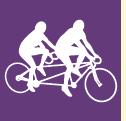
Tandem Cycling
Description
 Want to enjoy the great outdoors? Then bicycling may be for you. Cycling is a great way to build cardiovascular endurance and lower leg strength. Depending on your vision, there are tandem bikes that allow for a sighted Captain and a Stoker. However, both participants pedal. You can challenge yourself at any level from long, slow rides to fast-paced bicycling up and down hills or through the mountains. The most efficient way to pedal a tandem racing bike is by pushing the pedals forward with your leg thrust, rather than downward. Downward pedaling is termed "pedaling squares" and causes the bicycle to wobble left to right and waste the rider's energy. For more information on Tandem Cycling, visit: http://www.usaba.org or http://www.ibsa.es/eng/deportes/tandemcycling/presentacion.htm. For solo riding using echolocation, see http://www.teambat.org/index.html.
Want to enjoy the great outdoors? Then bicycling may be for you. Cycling is a great way to build cardiovascular endurance and lower leg strength. Depending on your vision, there are tandem bikes that allow for a sighted Captain and a Stoker. However, both participants pedal. You can challenge yourself at any level from long, slow rides to fast-paced bicycling up and down hills or through the mountains. The most efficient way to pedal a tandem racing bike is by pushing the pedals forward with your leg thrust, rather than downward. Downward pedaling is termed "pedaling squares" and causes the bicycle to wobble left to right and waste the rider's energy. For more information on Tandem Cycling, visit: http://www.usaba.org or http://www.ibsa.es/eng/deportes/tandemcycling/presentacion.htm. For solo riding using echolocation, see http://www.teambat.org/index.html.
Modifications/Suggestions
- Have a sighted Captain.
- Have a coordinated push-off, mounting, and glide before beginning to pedal. Corresponding pedals should not be in the same position to avoid tipping over.
- Both Captain and Stoker should lean into the turn rather than away from the turn.
- Captain verbally describes the slow down and exact stopping point, so the Stoker can jump from the pedals to the ground without getting hit in the back of the calves with his own pedals.
VIGNETTE
Tandem Cycling: Benjamin Small
 Hello, my family and friends call me Ben, and I am 14 years old. I have been blind since birth due to retinopathy of prematurity.
Hello, my family and friends call me Ben, and I am 14 years old. I have been blind since birth due to retinopathy of prematurity.
I became interested in cycling because my dad is a big bike rider. He and my mom go bike riding (sometimes pretty far). We used to have an Adams Trail-A-BikeTM for me, but now I'm too big for it so we bought a Rans ScreamerTM recumbent tandem.
When we first started to ride it, it was hard to get uphill, so I didn't pedal too much. My dad would tell me I HAD to pedal, otherwise it was too hard for him to get both of us up the hill. Now I just have to work harder. We both need to ride more and get stronger.
The only barrier we have to riding a recumbent tandem is that sometimes if the turns are too tight, we fall down. We need to work on our turns. I have to pedal while Dad stops pedaling and turns. Otherwise the front tire hits his foot and we fall. Also when we are going uphill, I pedal on the back while he stops for a moment to shift. Otherwise there is too much pressure on the gears to shift. We just need to practice our teamwork and get better.
 When riding, I call my dad Captain and he calls me Stokerman. Riding to get ice cream is one of my favorite things to do.
When riding, I call my dad Captain and he calls me Stokerman. Riding to get ice cream is one of my favorite things to do.
My goal is to someday ride in the Old Kentucky Home Tour, an annual event where cyclists ride from Louisville to Bardstown.
If you think you are interested in tandem bike riding, try it out and see if you like it before you buy a bicycle. Then just pedal, pedal, pedal! It is great exercise and lots of fun when the Captain tells you about your surroundings, and you feel the wind in your face.
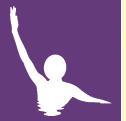
Water Exercises
Description
Still thinking about water activities? Water aerobics is a great way to develop cardiovascular endurance and muscular strength. Classes are offered by most community pools, as well as community colleges and universities. Water aerobics uses rhythmic movements performed in the water to music. Many of the movements are similar to dancing and simulated weightlifting.
Modifications/Suggestions
- clear, precise descriptions
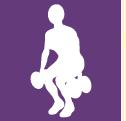
Weight Training
Description
An excellent activity that can be performed at home or in a fitness center, weight training serves to develop muscular strength and flexibility in all body parts. Also called "resistance training," weight training is a series of exercises that involve lifting weights or body parts in a variety of different ways to gain muscular strength and flexibility. By participating in weight training activities, you can increase strength and flexibility in your legs, back, chest, arms, abdominals, and shoulders.
Modifications/Suggestions
- high marks (liquid plastic, raised markings) or braille on weights
- display weights in a consistent order
Physical Characteristics Needed
None. Weight training activities develop muscular strength and endurance as well as flexibility. See Appendix A. Weight training also can reduce body fat and increase metabolism.
Where To Develop Skills for Weight Training
School
Body/Strength conditioning, weight training, circuit conditioning, wrestling, aerobics, gymnastics, crew
Home
See Appendix A under muscular strength and endurance.
Community
Fitness center, YMCA, YWCA, community center
| Activity Rating Chart for Weight Training | |||||
|---|---|---|---|---|---|
| 1 | 2 | 3 | 4 | 5 | |
| Social | X Home | X Fitness Center | |||
| Exertion | X | X | X | ||
| Inclusiveness | X | ||||
| Participation | X | X | |||
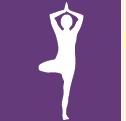
Yoga
Description
Developed in India, yoga combines mental and physical exercises. The original practices were to allow the individual to experience some form of a higher mental, emotional, or spiritual state. Most people participate in yoga to increase flexibility, strength, balance, and to reduce stress. There are many different styles with many different goals. It is up to you to decide which style will meet your needs. For more information, visit: http://www.yogajournal.com or www.deafblindinternational.org/standard/review1_l.html.
Modifications/Suggestions
- Clear, precise descriptions
- Wheelchair adaptations are available.
Physical Characteristics Needed
None. Yoga activities will increase flexibility, balance, muscular strength, and endurance. See Appendix A.
Where To Develop Skills for Yoga
School
Gymnastics, stretching class, swimming, kickboxing, Tai Chi
Home
Practice using store bought video tapes. See Appendix A under flexibility, balance, and muscular strength.
Community
Community classes, health club classes
| Activity Rating Chart for Yoga | |||||
|---|---|---|---|---|---|
| 1 | 2 | 3 | 4 | 5 | |
| Social | X Home | X Community Class | |||
| Exertion | X | X | |||
| Inclusiveness | X | ||||
| Participation | X | X | |||
VIGNETTE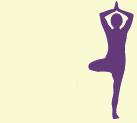
Yoga: Connie O'Bryan
Although I had some eye complications as a child, I was not diagnosed with myasthenia gravis until I was 22 years old. Currently, I have no depth perception or peripheral vision, and I see double. I can see better in the morning than in the afternoon or evening. Coming from a large family, seven sisters and one brother, I have always had great family support. I work with one sister in her event planning business and another sister teaches me yoga at her yoga studio.
 Because myasthenia gravis leads to excessive muscle fatigue, my sister suggested that I try yoga to help with my loss of balance and flexibility, and to enhance my endurance, which had fallen drastically. Upon my diagnosis, I became very depressed. My sister was convinced yoga would help me beat depression.
Because myasthenia gravis leads to excessive muscle fatigue, my sister suggested that I try yoga to help with my loss of balance and flexibility, and to enhance my endurance, which had fallen drastically. Upon my diagnosis, I became very depressed. My sister was convinced yoga would help me beat depression.
At first yoga was very hard due to my lack of balance and depth perception. The expression, "practice makes perfect," kept me going. And my sister was right; yoga does help alleviate depression. I know it is still there, and may always be there, but yoga has helped me maintain a more positive attitude about my condition and life in general than anything else.
My goal in yoga is to build up my endurance enough to be able to spend an entire hour practicing yoga. I hope to maintain the practice of yoga throughout my life for enjoyment and for the healthful benefits it provides.
If you think you might be interested in studying yoga, my advice is to run to the nearest yoga center and start today. Start off doing "gentle yoga" and work your way up to more vigorous styles. Be patient. Yoga will help you relax while at the same time energize you. It has improved my breathing and helps me maintain focus on the task at hand. I love that my golf game has improved greatly since I began practicing yoga.
Team Sports/Activities
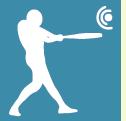
Beep Baseball
Description
One of the most exciting and popular team sports among blind athletes is Beep Baseball. The game, although similar to traditional baseball, has several different aspects. There are six innings (more if the score is tied after six innings). There are three outs per team. There is no second base. First and third bases are placed 100 feet down their respective lines and 10 feet off the foul line. The bases are padded, 4-foot high cylinders that give off a buzzing sound when activated. Balls hit over 40 feet are considered fair. Under 40 feet is a foul. A ball hit over 180 feet in the air is a home run. When a ball is hit, the batter must reach the appropriate base. If they get to the base before the ball is fielded, then they are safe and score a run. There is no running between bases. The pitcher and catcher are the only sighted players. For more information, visit: http://www.nbba.org.
Physical Characteristics Needed
Auditory tracking
Speed
Upper body strength
Where To Develop Skills for Beep Baseball
School
Softball, baseball, cricket, running, weight training, wrestling
Home
Baseball skills (throwing, batting, fielding, catching)
Community
Beep baseball teams
| Activity Rating Chart for Beep Baseball | |||||
|---|---|---|---|---|---|
| 1 | 2 | 3 | 4 | 5 | |
| Social | X | ||||
| Exertion | X | ||||
| Inclusiveness | X | ||||
| Participation | X | X | X | ||
VIGNETTE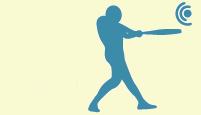
Beep Baseball: Jeff Dell
My visual disability is caused by retinitis pigmentosa. It is a genetic condition that, when active, causes the gradual deterioration of the retina. My brother and I both have this condition. I was diagnosed when I was in fourth grade. My parents and the school I attended were grasping at straws to find the root of our problem. We were both smart kids that, when given time, excelled at our schoolwork but were considered to be slow learners.
 My parents have encouraged all of our endeavors. They have never tried to coddle us and have always let us take our lumps. We were raised to believe that we could accomplish anything we wanted to with hard work.
My parents have encouraged all of our endeavors. They have never tried to coddle us and have always let us take our lumps. We were raised to believe that we could accomplish anything we wanted to with hard work.
When I was younger, I was an avid soccer player and enjoyed playing baseball in my neighborhood. As I got older, I could never understand why I was so poor at catching balls.
After high school, I attended Hocking Technical College to learn the trade of Audio Engineering and then attended the Recording Workshop at Chilocothe, Ohio. After 3 depressing years of internships and job searching, I decided to give it up and go back for my bachelor's degree in Information Technology. The choice had less to do with my disability than it had to do with the lack of job prospects in the Cleveland area for my field.
Currently while going to school, I work in the Cleveland State Library's Adaptive Technology Lab assisting students in computer usage. I do anything from answering basic questions to teaching students how to use a computer.
I learned about Beep Baseball from Jo Kozac, a worker at the Cleveland Sight Center. The World Series was in Cleveland in 2001, and she asked me if I was interested in sponsoring a ball. She also tried talking me into going out to Strongsville to see a game. I was fairly interested in the idea of it because I played baseball growing up and needed some kind of physical activity so that I would get into shape.
A month later I was in Strongsville to see some games and meet the team. When Jo took me over to meet the Cleveland Scrappers, the team was in the field on defense. When they came in, Jo introduced me to each of the players. When she got to Leonard Williams, he threw open his arms, grabbed me into a bear hug, and shouted "Young blood." This initially scared me. After talking with the guys on the team for a while, I knew playing was something I would have to try.
The next season my brother and I started practicing with the team. We figured our first season we would be on the bench watching everybody play. Neither of us would have even pretended that we were athletes. It didn't take very long before we found out that we were quite good ball players. That season, by the second tournament, we were both on the all-tournament offensive team. By then we had fallen in love with the sport and would be playing it for a long time to come. Our team's 20th anniversary was in 2003, and we intend to keep a team in Cleveland for another 20 years.
The only barrier I faced when I started playing the sport was learning the skill set needed to play. I really had to learn how to hear the devices (like the ball and bases) and the people around me. At first I missed a lot of bases (and still occasionally do). I would frequently overrun balls on defense. These things you overcome, and it is part of the learning curve. There is no one that will walk onto a field and play like a pro having never played before. We all take our lumps.
Transportation is sometimes a barrier. If I can't get a ride home from practice, it takes me anywhere from an hour and a half to 2 hours to get home. This sounds like a real pain but when you enjoy something so much the time is insignificant.
Another barrier is available time. I am a student at Cleveland State, and both beep baseball and studying are very time consuming. I just have to plan my time well and set my priorities. My team understands if I miss practice, a game, or a fundraiser, because I am busy with schoolwork. A barrier that I commonly see in people that I try to recruit to play is their confidence. They say, "I'm in no shape to play baseball," or "I'll probably break my neck." I won't tell someone that what I do is easy, but often people just don't understand the natural abilities they possess. Plus, some people are scared to make a fool of themselves. People are often so worried about how they will be perceived that they are not willing to put themselves out there and have fun. It takes falling on your face a couple times to find out what you can do. It's this lack of confidence that visually impaired people have to overcome to enjoy society.
For any competitor in the National Beep Baseball Association there is only one goal, to win the NBBA World Series Championship. In the 2 years I have played, I have won four medals (one offensive and three defensive) and was on the cover of a local newspaper in Denver for the 2003 World Series. None of that would come close to winning the championship.
My other goal is to promote the sport and recruit new players. The players in our sport are aging, and we need to recruit the younger generations to sustain our league. This is why I ran for and was elected to the NBBA Board of Directors.
Just do it (like the Nike slogan). Don't think about why you shouldn't or if you can. You will never know if you don't try. I can safely say that I would have missed out on one heck of a lot if I hadn't tried beep baseball. Because of this sport I travel across the country, have fun competing in a highly competitive sport, and have made a large number of friends locally and across the country.
There are many activities and sports that are available to people with disabilities. However, for an individual there is no greater tool to expand your awareness of the world around you like a team sport. Be it beep baseball, goalball, crewing, or soccer; try to play a team sport at least once. You will walk away with much more than a win or loss.
Visit the Cleveland Scrappers at http://clevelandscrappers.org.

Bobsled
Description
Bobsled is a sport for ice and snow enthusiasts. It requires fast running and upper and lower body strength. It was started in the late 1880s, and the first sleds had rope steering and no brakes. They were stopped by using a garden rake. Modern sleds reach speeds of 80-90 mph, with 4 G-forces in the curves, depending on the track.
Bobsled is performed by two-man and four-man teams racing down 1,300-meter long tracks. The tracks are ice-packed chutes with high sides to support the sled as it goes around curves. There are two types of athletes in bobsled: drivers and pushers. Drivers steer the sled and are the leaders of their team. Pushers push the sled fast at the start. The athlete in the back of the sled is called the brakeman. He engages a brake (a metal claw which digs into the ice) after the sled crosses the finish line. At the start, the athletes run on ice using special shoes with 500 tiny spikes under the ball of the foot. They then jump into the sled and go down the track.
There are 16 bobruns in the world; two are in the United States and one is in Canada. All three are former Olympic sites.
The United States Bobsled and Skeleton Federation (USBSF) was formed to advance, encourage, improve, and promote amateur bobsledding and skeleton competition in the United States. The USBF has a Junior Program for boys and girls ages 12-18. This program uses a three-quarter scale model sled racing from the half mile mark on the bobsled/skeleton track. Passenger rides are offered for people interested in learning more about bobsled. For more information, visit: http://www.usbsf.com/index3.htm.
VIGNETTE
Bobsled: Blaise Bryant
I have been blind since birth due to bilateral microphthalmia but that doesn't stop me from going 40 miles per hour down a bobsled chute.
My Dad has been a member of the United States Bobsled and Skeleton Federation for over 20 years, so it was natural that he introduced my sister, Joy, and me to bobsledding. We participated in the peewee program for 9 year olds and up that is run by the Olympic Regional Development Authority. I am now 13 years old.
 I like to bobsled because of the speed, vibration, and noise. I just can't resist the fun of it. Joy and I ride in a two-man bobsled and take turns driving. At first I didn't know how to drive, so that was a barrier. But now I drive by the feel of it, and if Joy sees I need some correction, she tells me to go left or right.
I like to bobsled because of the speed, vibration, and noise. I just can't resist the fun of it. Joy and I ride in a two-man bobsled and take turns driving. At first I didn't know how to drive, so that was a barrier. But now I drive by the feel of it, and if Joy sees I need some correction, she tells me to go left or right.
Joy and I hope to be in the Olympics one day.
My advice to anyone who wants to bobsled is to sit there, relax, and have fun. Remember, don't over steer the sled--you will go faster.

Crew (Rowing)
Description
Those who participate in rowing have been called the world's greatest athletes. Rowing began in 1872. Rowing is a total body workout that requires both a strong upper and lower body. Rowers are categorized by sex, age, and weight. There are junior events for those under 18 and masters events for rowers 27 and over. There are men's and women's competitions as well as mixed. The weight categories are lightweight and open weight. Boats range in size from 27 feet (the smallest) to 200 feet. Although individual effort (rowing) is needed, rowing is very much a team sport with each member of the "crew" working together to propel the boat through the water. Crew is also recognized as one of the easiest sports to join at any time in one's life with little or no modifications. For more information, visit: www.fisa.org.
Physical Characteristics Needed
Cardiovascular endurance
Upper body strength and endurance
Lower body strength and endurance
See Appendix A.
Where To Develop Skills for Crew
School
Weight training, kayaking, canoeing, running
Home
Cardiovascular exercises, upper body strength (See Appendix A.)
Community
Crew teams, health clubs with rowing machines
| Activity Rating Chart for Crew | |||||
|---|---|---|---|---|---|
| 1 | 2 | 3 | 4 | 5 | |
| Social | X | ||||
| Exertion | X | ||||
| Inclusiveness | X | ||||
| Participation | X | X | X | ||
VIGNETTE
Crew (Rowing): Kristina L. Ament
I have been blind since birth due to Leber's Congenital Amaurosis. My parents were adamant that I should attend public schools, excel in academics, and participate in sports. As a child, I rode horseback, skied, and swam competitively. Because my father was an army officer, our family moved frequently. I grew up in Virginia, Colorado, and California. The frequent moves forced me to learn how to meet new people and adapt to new situations quickly. For my final 3 years of high school, I attended Interlochen Arts Academy in northern Michigan.  Interlochen is an arts-focused boarding school where I studied fiction writing and sang in the school's choir. While in the north woods, I cross-country skied, canoed, ran, and camped. In a school full of artists, however, there were not too many organized athletics. Following high school, I attended Yale in New Haven, Connecticut, where I graduated with a Bachelor of Arts in Psychology. It was at Yale where I first started rowing. After Yale, I studied law at Stanford University in Palo Alto, California, receiving a J.D. Following law school, I served as a judicial clerk for a United States District Judge in Little Rock, Arkansas. I then worked as a Litigation Associate for a law firm in Washington, D.C. Staying in the D.C. area; I worked 7 years as a trial attorney with the U.S. Department of Justice, Criminal Division. Since 1998, I have been serving as an Assistant United States Attorney in the District of Columbia. Currently, I prosecute sex offenses and domestic violence cases.
Interlochen is an arts-focused boarding school where I studied fiction writing and sang in the school's choir. While in the north woods, I cross-country skied, canoed, ran, and camped. In a school full of artists, however, there were not too many organized athletics. Following high school, I attended Yale in New Haven, Connecticut, where I graduated with a Bachelor of Arts in Psychology. It was at Yale where I first started rowing. After Yale, I studied law at Stanford University in Palo Alto, California, receiving a J.D. Following law school, I served as a judicial clerk for a United States District Judge in Little Rock, Arkansas. I then worked as a Litigation Associate for a law firm in Washington, D.C. Staying in the D.C. area; I worked 7 years as a trial attorney with the U.S. Department of Justice, Criminal Division. Since 1998, I have been serving as an Assistant United States Attorney in the District of Columbia. Currently, I prosecute sex offenses and domestic violence cases.
While a freshman at Yale, I looked for a sport where demonstrated proficiency was not a requirement. Rowing clearly fit the bill. Particularly at that time, only a few elite prep schools and even fewer public schools offered crew to students. Thus, most collegiate rowers came to the sport as complete novices. I learned about the opportunity to row at Yale by speaking with a few upper-class rowers who lived in the same dormitory as me. The crew team also brought a shell (the boat we race in) to the freshman orientation with the hopes of attracting new rowers who may or may not have ever raced in a boat before. I rowed for most of freshman year, but quit to spend more time on academics. I never forgot the joy of rowing on the Housatonic River. In 1991, I attended a dinner party and met a person who rowed for Capital Rowing Club in Washington, D.C. Learning that I had rowing experience, he invited me to come down and rekindle my interest in the sport. The rest, as they say, is history. I now row for Alexandria Community Rowing on the Potomac River outside Washington, D.C. Our team practices every weekday morning at 5:30 a.m., from April to November and competes in regattas all over the United States.
I remember facing no barriers to actually joining the team at Yale. What makes crew unique is its complete emphasis on team building. My teammates were always supportive and helpful in demonstrating or explaining things and giving directions, if they were needed. I learned how to row initially in an indoor rowing tank, with teammates and coaches giving tips and pointers on technique. One disadvantage that I had was that we were encouraged to use mirrors while rowing in the indoor tank to perfect technique and uniformity; two things crucial to an effective rower and team. I overcame this by eliciting oral explanations from coaches and teammates to better my technique.
In the boat, it is often a hindrance to watch one's teammates and attempt to follow them. Once we were on the water in the boats, I was in virtually the same position as the rest of my teammates. In team boats, good rowing is often a matter of feel and rhythm, so your eyes are often your enemy. Rowers who try and visually match their teammates usually end up a microsecond behind. This may not sound like a big deal, but in an eight-person boat, this microsecond lapse of just one teammate can throw off the rhythm and ability of the entire team. My freshman coach, 1984 Olympic Gold Medalist Carol Bower, treated me like any other rower. She pulled no punches when I performed badly. This acceptance was possible because rowing is a sport that one simply doesn't have to see in order to compete. A coxswain steers and the rest of us just pull hard.
In my club-rowing career, I have usually faced the same level of acceptance. At one rowing club in Washington, however, I was told by the president that it might prove dangerous to have me on the dock. At the two clubs that did accept me, Capital Rowing Club and Alexandria Rowing Club, I have had the privilege of rowing in boats that beat this very club who thought I might be a liability or a danger. In short, the difficulties I face as a visually impaired rower have been overcome by my good fortune in having awesome teammates and coaches. Coaches like my current coach, Peter Stramese, have given me the same treatment as the rest of my teammates and been very supportive. Indeed, the biggest barrier I have faced as a rower, has not been being blind, but being short! Once I proved that my technique and strength were at the same level of my sighted teammates, I was accepted as an important part of our boat and team.
Due to the team nature of competitive rowing, my future goals are closely linked with my team's future competitions. Some of the races that are the most important for our team are Head of the Charles in Boston, Massachusetts, and the U.S. Rowing Masters National Championships. My personal goals are always to improve my technique and strength, to gel with my teammates to make the fastest boat possible, and to train at a high level both in practice and on the erg (indoor rowing machine used for endurance and speed training). Another important goal of mine is to enjoy myself, through staying in shape, being part of a great team, and sharing experiences with all of my teammates.
Don't be afraid to try something new. At first, rowing may seem very foreign and difficult. It is a sport that requires discipline, concentration, and a lot of hard work. Find a school team or a club and inquire about their novice programs. Finding a friend or acquaintance who is already rowing or wants to try something new might also be a good idea. Clubs and school programs will generally have a website or publicize their programs on campus. Don't be discouraged if training or rowing is difficult at first; just like anything else, it requires patience and a lot of practice before you can be good at it. The rewards are immense. The satisfaction of winning a race after a long and hard preparation is one of the more rewarding things I've ever done or felt. Sharing this experience with teammates makes it all the more worthwhile. In short, dive in headfirst, and with a little patience and effort, you will reap big rewards.
Rowing has given me a release from everyday stress and a busy work schedule. The opportunity to stay in great shape, bond with teammates, and experience the excitement of racing competition makes rowing one of the highlights of my life.
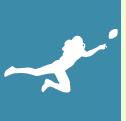
Football
Description
Football is a highly popular sport played mostly by males, but don't let that discourage any female from giving it a try. Similar to soccer, this sport is played with 11 players on each team. Football is played on a rectangular field that is 360 feet long and 160 feet wide. The object is to get the football into the other team's goal (or end zone) by running the ball in or having it passed to a teammate who catches the ball in the end zone. There are many different levels of football from pick-up games to youth leagues to high school teams to intercollegiate teams to professional teams. This sport requires strength, speed, power, agility, competitiveness, and teamwork. Football is a very physical sport that requires the use of protective pads and helmets. However, flag football is a variation of football that requires much less physical contact. Flag football is played very similar to football with some minor differences.
Modifications/Suggestions
- auditory ball
- auditory goals
- zone positioning
- sighted guide
- peer tutor (all positions)
- bright pinnies
- no defense
- smaller field
- less players
- larger or brighter flags (for flag football)
- more hand-offs vs. aerial passes
VIGNETTE
Football: Travis Freeman
I was an only child growing up in a Christian home with parents who supported me and encouraged me in every area of my life. Like most young boys, I loved sports, and football was my favorite. I began playing football at the age of 10 and enjoyed every minute. My dream was to be a Corbin (Kentucky) Redhound. But at the age of 12 things happened that would change my life forever.
 In the summer of 1993 I came down with cavernous sinus thrombosis, which is a severe sinus infection. Within 2 days I went from 20/20 vision to being completely blind. The doctors told my parents and me that 70% of people die from what I had, and the other 30% live as invalids. But I was the second case world wide in which only the eyes were affected.
In the summer of 1993 I came down with cavernous sinus thrombosis, which is a severe sinus infection. Within 2 days I went from 20/20 vision to being completely blind. The doctors told my parents and me that 70% of people die from what I had, and the other 30% live as invalids. But I was the second case world wide in which only the eyes were affected.
I knew my dream of football was over. That fall I entered the seventh grade, and it was a hard year learning how to live life all over again; going from a sighted world to being completely blind was not easy since I stayed in Corbin and was the first blind student to ever attend Corbin Public Schools.
The next summer my mom went to talk with the eighth grade football coach. I wanted to be a part of the team in someway such as a manager or something. But the Coach said no. He told my mom that he had been studying this and had figured out a way for me to play football. I was thrilled! I was to be the center. My teammates would help me to and from the huddle, line me up over the football, then I would snap the ball. That way I would know when the play had started and I would be like every other boy on the field blocking the boy in front of me.
When I first started practicing football, it was very difficult for me because for a year I had not done any exercise. But I soon caught up and started learning the plays. It was a learning experience for all of us. In August I stepped out on the football field as the first blind football player, and I loved it.
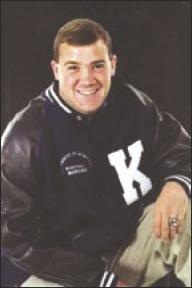 My playing football received national recognition. I made appearances on the Today Show and NBC Dateline. My story was in newspapers across the country, and that is how Coach Hal Mumme found out about me and offered me a position with the University of Kentucky football team. I served as equipment manager for five seasons.
My playing football received national recognition. I made appearances on the Today Show and NBC Dateline. My story was in newspapers across the country, and that is how Coach Hal Mumme found out about me and offered me a position with the University of Kentucky football team. I served as equipment manager for five seasons.
If you are interested in playing football, understand that it will be a lot of hard work, and you must practice many hours. You need self-determination. Talk to your school's coach. A supportive coach and enthusiastic teammates were key to my success on the football field.
Since graduating from college, football is no longer a possibility, so I have started taking golf lessons. I hope to improve my game as I play.
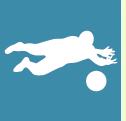
Goalball
Description
Goalball is played in a gymnasium using a playing area the size of a volleyball court. There are three members of each team at each end of the court protecting the goal line. A team consists of one center and two wings. The game is 20 minutes long, comprised of two10-minute halves. A rubber ball with bells inside for auditory tracking is used. Each player must wear a blindfold regardless of the degree of visual impairment. Each player usually wears elbow pads, kneepads, hip pads, and face protection. The object is to get the ball past the other team's goal line by underhand rolling the ball. The defending players use their entire bodies to block the ball from going over the goal line. This is a Paralympic event. For more information, visit: http://www.usaba.org or http://www.ibsa.es/eng/deportes/goalball/presentacion.htm.
Physical Characteristics Needed
(See Appendix A.)
Beginners
Flexibility
Auditory tracking
Underhand rolling
Minimal cardiovascular endurance
Competitiveness
Players
Power
Agility
Mobility skills
Upper body strength
Quickness
Competitiveness
Where To Develop Skills for Goalball
School
Bowling, bocce, body conditioning, gymnastics, softball/baseball, horseshoes, beep baseball, wrestling
Home
See Appendix A for fitness activities to develop physical characteristics needed to play.
Community
Goalball leagues, clinics, local goalball team
| Activity Rating Chart for Goalball | |||||
|---|---|---|---|---|---|
| 1 | 2 | 3 | 4 | 5 | |
| Social | X | ||||
| Exertion | X | X | |||
| Inclusiveness | X | ||||
| Participation | X | X | X | ||
VIGNETTE
Goalball: Charity Ryder
My visual impairment was the result of congenital cataracts and retinal problems. As a child, I attended public school. I started at the Florida School for the Deaf and Blind (FSDB) after the end of my eighth grade year. I enjoy playing goalball, riding my bike, swimming, skating, hanging out with my friends, and driving my coach nuts. I am 18 years old and upon graduation I plan to attend college in Florida and earn a degree in communication disorders. I hope to continue to play goalball.
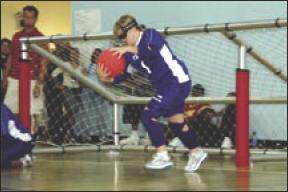 I learned about goalball at FSDB where we have an awesome program. I began playing 3 years ago, and this is my second year as a starter. This year, I am the starting center on my team. I have been named to the All-American team as well as various all-star teams; and I was selected for the USA Girls Goalball Team, which competes in the World Youth Championships. I got my first bike when I was young and have enjoyed riding for a long time. I started roller skating when I was young as well, and I continue to enjoy it today.
I learned about goalball at FSDB where we have an awesome program. I began playing 3 years ago, and this is my second year as a starter. This year, I am the starting center on my team. I have been named to the All-American team as well as various all-star teams; and I was selected for the USA Girls Goalball Team, which competes in the World Youth Championships. I got my first bike when I was young and have enjoyed riding for a long time. I started roller skating when I was young as well, and I continue to enjoy it today.
One of the biggest barriers for me was developing my confidence and belief that I could be a good goalball player. My coach constantly encourages me and pushes me to do my best and to believe in myself. He also makes sure we all do well in school. I sometimes doubt my abilities, but between my coach, teammates, and parents, there is usually someone who gets on me and straightens me out. I am a more confident and goal-oriented person thanks to participation in sports and physical fitness activities.
I hope to continue to have opportunities to play goalball and develop as a player, and my ultimate goal is to be able to make the U.S. Women's Paralympic Goalball team in the future. As far as my other activities, I will continue to be active as I believe it helps keep me healthy, happy, and productive.
If you are fortunate enough to have a goalball program in your area, then I would encourage you to play. I think it is a fun and challenging game that people who are visually impaired can call their own. One of the barriers for some people is that they don't have an athletics program or the coaches willing to spend the amount of time it takes to have a successful program and team. I am very lucky to have a coach and be at a school that gives all students a chance to play.
It is so much easier for those of us who are visually impaired or blind to sit around, do nothing, and feel bad about who we are and what is wrong with us. But the harder road--trying new things, being active, wanting to know more about the world in which you live, believing in yourself and being a confident person--while being slightly more difficult sometimes, is far more rewarding and helps make your life the best it can be. I would encourage all people, young and old, to find something they enjoy and run with it. If I can do it, anyone can.
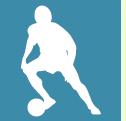
Soccer
Description
Soccer is a highly popular team sport that is played by people of all ages. It offers many different levels of play from pick-up games to youth leagues, from high school teams to intercollegiate teams, from professional teams to the Olympic Games. Soccer is played on a field commonly referred to as a "pitch." There are 11 players on each team. The skills of soccer include kicking and a high level of cardiovascular endurance. The object of the game is to kick the soccer ball into the other team's goal. In this sport, you are not allowed to use your hands to touch the ball, only the "goalie" who guards the goal can use his hands. For persons who are blind, there is adapted soccer available. Unlike traditional soccer, blind soccer is played with 5 players on each team instead of 11. When searching Internet sites on soccer, keep in mind that Americans say "soccer" while most of the world calls it "football." For more information, visit: http://www.ibsa.es/eng/deportes/football/presentacion.htm.
Modifications/Suggestions
- larger ball
- auditory ball
- auditory goals
- zone positioning
- sighted guide
- peer tutor (all positions)
- bright pinnies
- no defense
- smaller field
- less players
VIGNETTE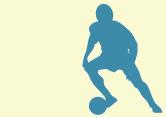
Power Wheelchair Soccer: Mark Christensen
I have cerebral palsy and that has caused me to be visually impaired. I also have some visual memory problems that have hindered my reading ability.
As a young child, I had great difficulty in visually focusing which impaired my ability to recognize people. I could not even recognize my parents. I didn't like watching TV. As I got older, I have been able to concentrate more, and I am able to focus better. I still have great trouble in recognizing people. I have learned to identify people by their voices.
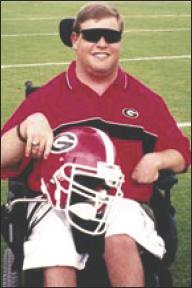 My family has been, and is still, very supportive of anything I want to try. I would not have gotten this far without them. They have instilled in me many great values that I use all the time. I have been very assertive in my life because they told me I had to go after what I wanted.
My family has been, and is still, very supportive of anything I want to try. I would not have gotten this far without them. They have instilled in me many great values that I use all the time. I have been very assertive in my life because they told me I had to go after what I wanted.
I attended special education classes along with regular classes. I did have an aide to help me in my regular classes. Since I could not read or write, I had to do all my learning auditorally. I graduated with a special education degree.
Four years ago, I wrote the athletic director of the University of Georgia (UGA). I told him I was a big fan, and wished to do something with the sports program. I didn't give my letter much of a chance, but one day the phone call came, and I was invited to interview with Coach Dooley's senior staff. They must have been impressed with me because Coach Dooley asked me to volunteer with the sports medicine program that focuses on rehabilitating injured athletes. The door was open, and I was moving closer to realizing my dream.
For the past two years, I have been an Americorps Personal Assistance Service Corps (PAS) member. I receive a living stipend. Twenty-five percent of the money comes from the sports program. My service will be completed at the end of September, and I have been told that the UGA sports program will then hire me full-time. This season, the coach of the football team asked if I would like to help coach the quarterbacks. Of course, I said yes. My determination has helped in making my dreams come true.
Since the age of 9, I have been involved with my dad in coaching baseball, basketball, and football. I have always wanted to play a sport. There are sports for people in manual chairs, but I didn't know of one for those of us in power chairs. Four years ago, I went to a reception for the send-off of some of the Paralympians in our area. I was talking to the recreational therapist for the Shepherd Center in Atlanta, and she told me about the power soccer team that they were starting in a couple of weeks. This was just what I was looking for, a sport that I could play. I have been on the team ever since. We have gone to four international tournaments and placed third in three. I am currently trying to start a team at UGA. This will not be a college team but rather a team for anyone in a power chair. UGA and Saint Mary's hospital will help sponsor us.
My main barrier to playing power wheelchair soccer is that we live 70 miles away from where we practice. My mom has been great in taking me. We also have had to travel to Phoenix, Arizona, 2 years in a row and once to Indianapolis, Indiana, for tournaments. This can be a challenge when you have about 15 people in power chairs and their attendants. We have managed. Our manager, David Realus, and our coaches, Jerry Frick and Roy Day, have been great in helping us raise the money to go and organizing all of it. We also have the Fernando Foundation which was established by one of our teammates and his family to help defray the cost. Without all of them, it would be impossible to do any of this.
Our biggest goal is to make power soccer a Paralympic sport. More teams need to be established around the country. Since the Fernando Foundation was started, there have been about six teams established on the East Coast. Prior to the Fernando Foundation, there were no teams near us. Much work still needs to be accomplished if we are to make it a Paralympic sport. Power soccer teams nationally and internationally must work on developing, adopting, and playing by the same set of rules and regulations. This work is continuing.
I believe if you are visually impaired and in a power chair, you can play this sport. On occasion, I do speaking engagements talking about my self-determination and where it has taken me. I encourage everyone with or without a disability to go for what they want. Everyone has some sort of barrier that may get in their way, but if they keep trying, they can make something good come out of it. I say that you need to keep knocking on the door, and eventually it will open. Never give up.
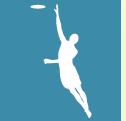
Ultimate Frisbee
Description
Ultimate Frisbee is a non-contact team sport that combines the best aspects of soccer, American football, basketball, and netball. Ultimate is played with two teams of seven players on a rectangular field (95 meters/87 yards by 37 meters/40 yards). A goal is scored when a team completes a pass to a player standing in the other team's end zone. Players can not run with the frisbee once they catch it. They must pass it to another team member. The defense tries to intercept the passes. Ultimate Frisbee requires speed, stamina, and agility. For more information, visit: www.whatisultimate.com.
Modifications/Suggestions
- softer Frisbee®
- auditory goals
- zone positioning
- sighted guide
- peer tutor (all positions)
- bright pinnies
- no defense
- smaller field
- less players
- more hand-offs vs. aerial passes
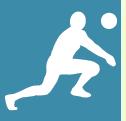
Volleyball
Description
Volleyball is one of the most popular sports played in high school physical education classes today. Volleyball is a team sport comprised of six players on each team with the goal of trying to get the volleyball over the net and to hit the floor on the other team's side. The court is 59 feet long and 29.5 feet wide. The skills required to play include jumping ability, strong upper body strength, agility, and competitiveness. Volleyball is offered competitively at the high school and collegiate levels as well as at the international level. Some community clubs host volleyball tournaments. With modifications, persons who are visually impaired can participate successfully.
Modifications/Suggestions
- beach ball (with rice or popcorn kernels)
- zones
- tie beach ball to net with string (eliminates need to chase ball)
- catch ball
- walk with ball
- ball can bounce once
- can hit ball more than once
- serve from anywhere
Individual Sports/Activities
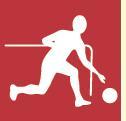
Bowling
Description
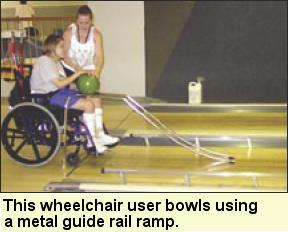 Bowling is generally held in community-based bowling alleys. The object of the game is to roll a ball down the lane knocking over as many pins as possible within a 10-frame game (20-21 balls). A point is earned for each pin knocked down with increased points earned for knocking all pins down on the first or second ball of each frame (strikes and spares). The maximum amount of points earned in one 10-frame game is 300. Bowling balls weigh between 8 and 16 pounds. Bowlers who are without sight or visually impaired may become members of American Blind Bowlers Association (ABBA). The USABA does not sponsor bowling competition for persons who are blind or visually impaired. For more information, visit: http://www.ibsa.es/eng/deportes/tenpinbowling/presentacion.htm and http://www.geocities.com/blindbowlers/whatisabba.html.
Bowling is generally held in community-based bowling alleys. The object of the game is to roll a ball down the lane knocking over as many pins as possible within a 10-frame game (20-21 balls). A point is earned for each pin knocked down with increased points earned for knocking all pins down on the first or second ball of each frame (strikes and spares). The maximum amount of points earned in one 10-frame game is 300. Bowling balls weigh between 8 and 16 pounds. Bowlers who are without sight or visually impaired may become members of American Blind Bowlers Association (ABBA). The USABA does not sponsor bowling competition for persons who are blind or visually impaired. For more information, visit: http://www.ibsa.es/eng/deportes/tenpinbowling/presentacion.htm and http://www.geocities.com/blindbowlers/whatisabba.html.
Modifications/Suggestions
- bumper guards
- commercial guide rails, makeshift guide rope, or carpet strip
- visual description of remaining pins (spotting)
- visual marking of lane lines
- scoring pad with tactile cues
- auditory sound source placed behind pins
VIGNETTE
Bowling: Mario Eiland
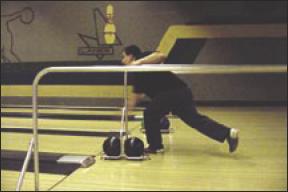 I went blind at the age of 7 in Colombia. The cause was a shotgun blast to my face. The gunpowder burnt my eyes, and it penetrated deep enough to where my optic nerve was damaged permanently. Because we lived deep in the jungle, my biological parents put me up for adoption in hope that someone could take better care of me. A family in Portland, Oregon, adopted me.
I went blind at the age of 7 in Colombia. The cause was a shotgun blast to my face. The gunpowder burnt my eyes, and it penetrated deep enough to where my optic nerve was damaged permanently. Because we lived deep in the jungle, my biological parents put me up for adoption in hope that someone could take better care of me. A family in Portland, Oregon, adopted me.
My new family gave me a lot of support and advocated independence. They enrolled me in a regular elementary school where I began to learn English and the social skills of a student. I started to meet friends, and these friends encouraged me to join them in extracurricular activities such as sports and band. I joined the wrestling team, the high school concert band, and participated in student government. I graduated with honors and continued on to college. I received a full scholarship to Oregon State University where I completed a BA in Business with minors in German and Spanish. While in college I got the opportunity to go on two exchange programs: one to Germany and the other to Costa Rica. Upon graduation, I was offered a job in Louisville, Kentucky, at the American Printing House for the Blind (APH) as a database specialist. I took the job, and I have been working there since. I currently hold the position of a computer programmer, which I really enjoy.
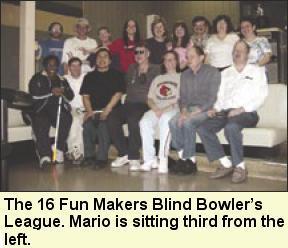 Not long after arriving in Louisville, my colleagues invited me to join the APH Bowling League. Even though I am not very good at the sport I enjoy the social aspect of the activity and after a long day of programming it is very important to relax and enjoy yourself.
Not long after arriving in Louisville, my colleagues invited me to join the APH Bowling League. Even though I am not very good at the sport I enjoy the social aspect of the activity and after a long day of programming it is very important to relax and enjoy yourself.
I would have to say that the only barrier I faced with the activity was my own insecurity of not being good at the sport. I have always been competitive, and my only thought was how could I be competitive if I was not good. When I realized that I was not there to win it all and just to have fun, I overcame that barrier. Currently I don't face any barriers when dealing with this particular activity. I have greater things to face such as raising my baby and providing for my family than worrying about how well I bowl.
My advice would be to go for it. You may not get 300 each time you bowl, and if you don't, just have fun!
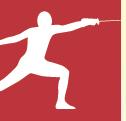
Fencing
Description
Fencing is a fast and athletic sport. Two participants compete on a 6-foot by 40-foot strip. Each participant's fencing clothes are attached to an electronic wire that scores "touches" electronically. There are three weapons used in fencing (foil, épée, and sabre). The main object of a fencing bout "game" is to score 15 points on your opponent before he scores that number on you. Each time a fencer scores a touch, he receives a point. Direct elimination matches consist of three 3-minute periods.
Modifications/Suggestions
- sighted opponent wears auditory signal for location
- tactile representation of boundaries
VIGNETTE
Fencing: Day Al-Mohamed
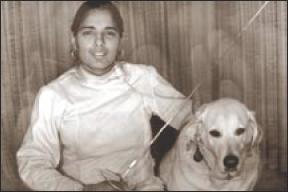 I was sighted until I was 19. I can tell light and dark, and if something is really close (up to my nose), I can tell the color and detect movement. For me the adjustment was very difficult at first. As an active person I had thought that my whole world was ending and that I would be incapable of continuing as I had been. I thought that I would be "limited," but I discovered that I COULD do most things. I might take a bit longer, but I could do things. I have friends who are supportive and encouraging, and I also happen to have a stubborn streak a mile wide.
I was sighted until I was 19. I can tell light and dark, and if something is really close (up to my nose), I can tell the color and detect movement. For me the adjustment was very difficult at first. As an active person I had thought that my whole world was ending and that I would be incapable of continuing as I had been. I thought that I would be "limited," but I discovered that I COULD do most things. I might take a bit longer, but I could do things. I have friends who are supportive and encouraging, and I also happen to have a stubborn streak a mile wide.
I am a 29-year-old college graduate with an undergraduate degree in Social Work and this last year received my Juris Doctor. It is my plan to sit for the Missouri Bar Exam this fall.
I have always been an active person, but more than that, I've always been a social person. I like getting out and meeting people. Sports and athletics are a great way to get to know people. It gives you common ground--a common goal.
Shortly after my vision loss I was in the gym one day with a friend. We were in the midst of a heated argument and she said, "You do realize that things are different now that you're blind, right? There are things that you will not be able to do anymore. You have limits." I snapped back at her, "Like exactly what?"
At the other end of the gym was the university fencing club, and my friend jumped on that as an example.
"There are people fencing. There is no way you could do that without seeing. It is a limitation," she added triumphantly.
Now before you go thinking about what a terrible friend she was, let me just say, she had my best interest at heart. She didn't want to see me slamming my head into a wall trying to do the impossible. Her theory was that I had not accepted the fact that I was visually impaired and was simply denying my limitations.
I really do hate that word, "Limitation."
I decided that I was going to prove her wrong. That next Monday when the fencing club met I was there waiting and ready to try it out.
I had no idea how to go about learning to fence. I'd never done it before. I'd never heard of anyone without sight having done it before. What made it even more difficult was that neither had anyone else.
But perhaps the biggest encouragement I had was the members of the club. At no point did they question my wish to take up the sport, nor did they question my ability to participate in fencing. Their first concern was: "Okay, how can we do this?" We approached it as a problem-solving exercise, almost like a game. "How can we teach Day to fence?"
It was tough. I had fencing books read to me and transcribed into alternative format so I could study the actions (in text format) at my leisure. They let me feel out the different stances and actions; we went through different attacks and parries over and over and over until I thought I couldn't take it any more. And bit by bit, I started to understand.
As we practiced, my own sense of where my body was and my own movement improved immensely. My balance, strength, and physical dexterity also increased. I was in college and studying for classes and putting in almost 20 hours a week at fencing, either with the club or doing footwork or handwork on my own. Suddenly, I wasn't just drilling and fencing with the club members, I was beating them.
There are no regular fencing events for the visually impaired and so I have always competed in regular events against nondisabled fencers, without any real accommodations. I still remember my first tournament. It was a local event for beginners. I was scared and nervous.
Initially, the organizers and a local coach approached a teammate to ask about my fencing and whether or not I "could really fence." I'm not sure what they answered, but the organizers decided to go ahead and let me fence. After that first tournament, they never questioned my fencing again. I had won first place.
The next difficulty lay with fencing's national governing body, the United States Fencing Association. My first large event (200 plus competitors) was the North American Cup. The organizing committee had a rather unsettling discussion as to whether or not I would be allowed to compete. It seemed they were concerned for my safety. At this point in time I was the highest ranked fencer at the university club and my teammates were more than happy to tell the committee that and insisted on letting me fence.
I have been fencing for years since then and never looked back. I have competed against fencers from Ireland, Great Britain, Romania, Hungary, Canada, and Mexico as well as the United States. I have been state champion in all three weapons--foil, épée, and sabre--and received commendations from both the state congress and the governor for my participation in the sport as a representative of Missouri. This last year I had the wonderful experience of spending a day training and fencing with the Chinese Olympic team in Beijing.
What has been most wonderful for me, is finding a sport that I truly love to do. I take pride in my skills and I enjoy the people with whom I fence.
For the last 3 years I have mostly given up competing in order to teach fencing. I teach children from age 10 and fencing for the disabled. I have had students compete locally and at the national level.
I have so many goals and ideas for the future:
- I hope to return to competition. Fencers are rated A, B, C, D, E and U (for unrated) with A's being the highest level of skill. With a C rating, I was one of the highest rated fencers in the region. It is my goal to be the first visually impaired fencer with an A rating.
- I hope to see more of my students compete successfully at the national and possibly international level.
- I hope to encourage more disabled individuals to take a chance and try this exciting and different sport.
It is rather amusing to consider that all of my fencing, everything that I've done, started with me having a "temper tantrum" because someone said I couldn't do something.
But it IS the sort of attitude to take. Decide you want to do something. THAT is all you have to do. Find something you think is neat or cool and just go for it. Like the Nike commercial says, "Just do it."
For fencing, find a local club, give them a phone call, and talk to the coach. Tell him or her that you want to fence. Schedule an appointment to discuss it if you need to or a private session to try things out. Remember the number one rule about vision loss--YOU are the one who knows the most about your blindness and about your skills and abilities, NOT someone else.
Over the years I have met many coaches and instructors. Some refused to have anything to do with me, some weren't sure, and some....some thought that it was a great challenge.
What I usually would say is something like, "You're the coach. You know about fencing. I'm the person with the disability. I know what I can and can't do. Between the two of us we just might be able to find a way to make this work."
Be stubborn. If you want to do this, push them. Make sure they know you are serious.
Be realistic. Like any sport or activity, realize that it is going to take a lot of time and effort on your part. Make sure you can commit to it.
Be patient. As I occasionally have to remind myself, I am not supergirl. I am not perfect. I make mistakes and I have bad days too. And sometimes things just take time. It is important to recognize that and not to give up because of it.
There is an old saying that "Fencing is chess, only at 90 miles per hour." To me, what that means is that this is not a sport about who is stronger or faster or physically more capable, but who is smarter; who has the strategy and the tactics; who can think two and three moves ahead. Your eyes may not work too well, but there is nothing wrong with your mind.
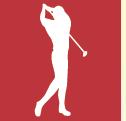
Golf
Description
Golf is a very popular sport that is played on a golf course. The object of the game is to hit the golf ball into the hole. Golf courses are very large and games can consist of 9 or 18 holes. The golfer hits the golf ball off of a 3-inch wooden tee in the direction of the hole. The hole can be anywhere from 100 yards to 500 yards away. The golfer hits the golf ball with a club. Different clubs are used for hitting the ball different distances. There are 11 basic clubs. One is for hitting the ball off the tee, nine different clubs for hitting the ball after the tee shot to try and make it to the green (where the hole is), and one club for hitting (putting) the ball once it is on the green into the hole. A typical game of golf (nine holes) can last anywhere from 2-3 hours. It is a very slow-paced game that requires much patience and practice for success. For articles on playing and coaching blind golf, visit: http://www.blindgolf.com/.
Modifications/Suggestions
- brighter ball
- verbal assistance with hole direction, club selection, ball placement
- caddie lays a club on the ground in the proper direction and golfer stands with toes along club for lining up to hit the ball
- Place a sound source at hole or tap with the flagstick on the hole's cup.
- distinct tactile or visual markings on clubs
Physical Characteristics Needed
None
Where To Develop Skills for Golf
School
Hockey (floor or ice), disc golf, field hockey, cricket, weight training
Home
Putting in back yard, club swinging
Community
Community golf course or driving range
| Activity Rating Chart for Golf | |||||
|---|---|---|---|---|---|
| 1 | 2 | 3 | 4 | 5 | |
| Social | X | ||||
| Exertion | X | ||||
| Inclusiveness | X | ||||
| Participation | X | X | X | X | X |
VIGNETTE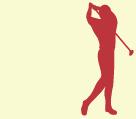
Golf: Sheila A. Drummond
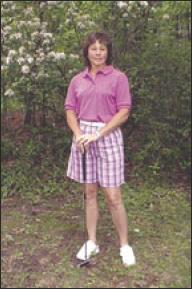 I went blind at the age of 27 from diabetic retinopathy. One day I was at a blind function, and some people asked me if I played golf. I told them that I did not, and one day there was a message on my answering machine telling me to attend a meeting about blind golf. I found a friend to coach me and took a crash course at a local golf course. This all started 12 years ago; I never played golf when I was sighted.
I went blind at the age of 27 from diabetic retinopathy. One day I was at a blind function, and some people asked me if I played golf. I told them that I did not, and one day there was a message on my answering machine telling me to attend a meeting about blind golf. I found a friend to coach me and took a crash course at a local golf course. This all started 12 years ago; I never played golf when I was sighted.
I am a member of the United States Blind Golf Association, and we play competitive golf. Because I am totally blind I compete in the B1 division. I play for fun and play in tournaments that my local club holds. I also do a lot of practicing there to prepare for my competitions. When I play golf, I walk so I get exercise.
It was very difficult to learn this sport since I never played golf when I was sighted. I would get very frustrated, but I kept on playing the game. When golf pros were going to work with me, they would have to show me what they wanted since I knew nothing about the game, and their explanation could be easily confused. I live in a small town with only a few blind people. Sighted people find the game very difficult and can't imagine blind people playing this sport. One of my biggest problems is finding coaches. Every blind golfer needs a sighted person to coach them. Coaches give you distances and correct alignment. They also describe the holes and the shots you need to make.
My best score so far is 106, and my goal is to break 100.
When learning to play golf, I think it is very important to stay calm and not to get stressed. The more upset you become the worse your game gets. I find walking on the course, rather than riding, helps eliminate the stress.
Golf is a great sport for people with blindness and visual impairments and is something that you can do for your lifetime.

Judo
Description
 Judo is a dynamic combat sport that requires physical strength and mental discipline. From a standing position, it involves techniques that allow you to lift and throw your opponents onto their backs. On the ground, it includes techniques that allow you to pin your opponents down to the ground, control them, and apply various choke holds or joint locks until submission. Judo is a variation of martial arts. Unlike many other martial arts, judo does not involve kicking, punching, or striking techniques. Judo is a Paralympic event. For more information, visit: http://www.ibsa.es/eng/deportes/judo/presentacion.htm or http://www.usaba.org.
Judo is a dynamic combat sport that requires physical strength and mental discipline. From a standing position, it involves techniques that allow you to lift and throw your opponents onto their backs. On the ground, it includes techniques that allow you to pin your opponents down to the ground, control them, and apply various choke holds or joint locks until submission. Judo is a variation of martial arts. Unlike many other martial arts, judo does not involve kicking, punching, or striking techniques. Judo is a Paralympic event. For more information, visit: http://www.ibsa.es/eng/deportes/judo/presentacion.htm or http://www.usaba.org.
Modifications/Suggestions
- clear, precise descriptions
- Choose appropriate instructional preference.
- Opponents start with a grip on each other's gui.
Physical Characteristics Needed
(See Appendix A.)
Upper body strength
Lower body strength
Flexibility
Agility
Where To Develop Skills for Judo
School
Tai Chi, kickboxing, gymnastics, weight training, strength/body conditioning
Home
Fitness exercises (See Appendix A under upper/lower body strength, flexibility, agility.)
Community
Judo clubs, developmental camps, USABA competition, Paralympics
| Activity Rating Chart for Judo | |||||
|---|---|---|---|---|---|
| 1 | 2 | 3 | 4 | 5 | |
| Social | X | ||||
| Exertion | X | ||||
| Inclusiveness | X | ||||
| Participation | X | X | X | ||
VIGNETTE
Judo: Jody W. Ianuzzi
I love judo! When I'm not sporting my black belt, I work with my husband in our own computer security business. I have "hand motion" vision in my right eye and no vision in my left eye caused by retinopathy of prematurity. Growing up, my family's expectations for me were the same as a sighted child.
 In the 1960's judo was more popular then karate is today. I was always curious to learn it. When I went to college, I found a club on campus, and I joined it. I have been doing judo ever since.
In the 1960's judo was more popular then karate is today. I was always curious to learn it. When I went to college, I found a club on campus, and I joined it. I have been doing judo ever since.
There are no barriers for a blind person learning judo. It is a full-contact activity. If you cannot see the instructor demonstrate a technique, then you can follow the motion of your partner to learn a technique. Talk to the instructor and explain your intention to learn judo. If they are hesitant, explain that many blind people have learned judo, and you see no reason why you shouldn't learn it too. Show them my story in this book.
I love to teach blind students judo. Judo changed my life in many ways, it can change your life, too. Most of all, have fun and be all you can be.
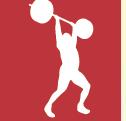
Powerlifting
Description
Powerlifting is for those individuals who are interested in lifting weights using several specific lifts in a competitive arena. Powerlifting events include squat, bench press, and deadlift. This activity requires overall muscular strength and flexibility. Age ranges vary with ISBA beginners starting at age 14 and the oldest competitor in the 2000 ISBA World Championships was 84 years old. For more information, visit: http://www.ibsa.es/eng/deportes/powerlifting/presentacion.htm.
Modifications/Suggestions
- high marks (liquid plastic, raised markings) or braille on weights
- weights put in a consistent order
VIGNETTE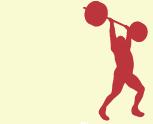
Powerlifting: Lisa Marie Garcia
My blindness was caused by retinopathy of prematurity, resulting in retinal detachment. I was born 16 weeks early and barely survived in the hospital. My parents hoped everyday that I would live. Miraculously, I did, and I am standing here today, a 17-year-old power lifter.
I went to mainstream school through grade six. While there, kids would take my cane and play "keep away" with it. Sometimes at lunch, they would swipe my food, or pick food up off of the floor and put it in my soup; I would eat it, unaware of what they had done. Through this all, I pursued what I wanted to do, never once saying that I couldn't do something because I am blind. My family encouraged this and that made me very happy. They are still supporting me today.
 In grade seven, I began going to the Washington State School for the Blind. There, I met Mr. Robb Peck, coach of the powerlifting team. On registration day, he told my parents and me about powerlifting. It sparked my interest right away. I wanted to do something that would make me feel like a sighted person. When the tryouts began in November, I went out for the team. Mr. Peck was proud of me because he told me that he thought that I would make a good asset to the team. He was right. After six seasons of powerlifting, I have become a stronger person, mentally and physically. Powerlifting has taught me many good things.
In grade seven, I began going to the Washington State School for the Blind. There, I met Mr. Robb Peck, coach of the powerlifting team. On registration day, he told my parents and me about powerlifting. It sparked my interest right away. I wanted to do something that would make me feel like a sighted person. When the tryouts began in November, I went out for the team. Mr. Peck was proud of me because he told me that he thought that I would make a good asset to the team. He was right. After six seasons of powerlifting, I have become a stronger person, mentally and physically. Powerlifting has taught me many good things.
I faced several barriers during my first season of powerlifting. The first huge barrier was strength. Normally a person starts out lifting a 45 pound weight bar. I tried lifting it, and I struggled with it greatly. Mr. Peck had me lifting a specialty bar, a 15 pound bar. I practiced with that bar for awhile and got stronger, to the point where I could lift that bar with great ease. Then he moved me to the 45 pound bar. Second on the list of barriers came nerves. My first meet was scary. I wasn't sure what people would think of me lifting up on the stage. They all had great respect for me though, and they were all proud. I managed to make a Washington State record of a 55 pound bench press. My family was proud.
I plan to do a lot with my career as a power lifter. I plan to go on to college and do lifting there, and if they have a powerlifting team, I plan on joining it. I plan to break the world record in the 16 to 19 age bracket in dead lift.
If another blind person were to want to do powerlifting, I would tell them to stay strong. Don't let people tell you that you can't do it because you'll hurt yourself or because you are blind. I have been injured in the weight room many times, but that can happen to anyone. It's natural with any sport. Another thing is listening to your coach. Don't try to do things until you're ready or when your coach says you're ready. Don't try to lift heavy weights when you can't. Remember, there is no "I can't." If you say that, you have already lost out on a great opportunity. Don't listen when your brain says that. Think to yourself, "I can. I will. I can lift this weight." If you think that, you can. Do endurance exercises. They build up your mental strength.
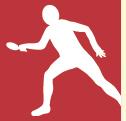
Table Tennis
Description
Also known as ping pong, table tennis is a dual sport that is played on a 9-foot by 5-foot table that is 2.5 feet high with a 6-inch net dividing the table in the center. The object of the game is to hit the ping pong ball onto the other player's side without them being able to return it over the net.
Modifications/Suggestions
- Use bright balloons.
- larger paddles
- larger ball
- no net
- Allow ball to roll.
- Add edge guard.
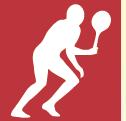
Tennis
Description
Similar to table tennis, tennis is played on a rectangular court 78 feet long (23.77m) and 27 feet wide (8.23m). There is a 3.5-foot net dividing the court in half. The object of this dual sport is to hit the tennis ball onto the other person's side without them returning it over the net. This sport is offered as a recreational sport that can be played in most communities. Tennis is also offered competitively at the high school, collegiate, and professional levels.
Modifications/Suggestions
- offense only
- Create a point system for landing area on opposite side of net.
- auditory cueing
- bright ball, use gator skin ball
- allow two bounces
- Use underarm serve from serve line instead of overarm serve from base line.
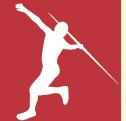
Track & Field
Description
Track and field is one of the oldest sports still played today. Track and field events allow for participation by almost all individuals. There are running events (both long distance and sprints), hurdle events, jumping events (long jump, triple jump, high jump, pole vault), and throwing events (shot put, hammer throw, discus, and javelin). Track and field is offered for both individuals with and without disabilities. For more information, visit: http://www.ibsa.es/eng/deportes/athletics/presentacion.htm or http://www.usaba.org.
Modifications/Suggestions
Running Events
- guide runner
- tether
- guide wire
Field Events
- auditory directional cues
- proper instructional technique (physical assistance, braille)
- tactile and visual markings for throw/boundaries
- emphasis on practice of consistency of approaches in jumping events
Physical Characteristics Needed
(See Appendix A.)
- depends on the event
- Running long distance requires a high level of cardiovascular endurance.
- Running sprints requires speed and power.
- Hurdle events require speed, lower leg strength, flexibility, and power.
- Jumping events require power, speed, and lower leg strength.
- Throwing events and pole vaulting require upper body power and strength.
Where To Develop Skills for Track and Field
School
Weight training, powerlifting, cross country running, gymnastics, cycling, aerobics, swimming, basketball, ultimate frisbee, soccer
Home
Use the street for long distance running events and the backyard for some jumping events. See Appendix A under power, speed, upper/lower body strength, agility, flexibility.
Community
Club teams, open track meets
| Activity Rating Chart for Track & Field | |||||
|---|---|---|---|---|---|
| 1 | 2 | 3 | 4 | 5 | |
| Social | X | ||||
| Exertion | X | ||||
| Inclusiveness | X | ||||
| Participation | X | X | X | X | |
VIGNETTE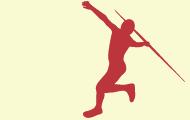
Long Jump: Elexis Gillette
I lost my sight in the second grade due to recurrent retinal detachments. I have been very fortunate to have had a lot of family support, mentors to guide me, and friends at home and at my church. My mother told me that I could do whatever I wanted, but I may have to adapt and do it in a different way.
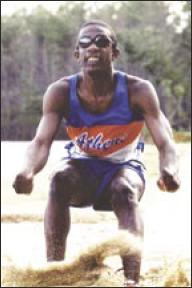 My sophomore year in high school, my track coach, Brian Whitmer, told me about a sports camp in Michigan. This camp was for visually impaired and blind athletes. Coach Whitmer and I went to the camp that summer. The camp allowed each athlete to get a feel for various recreational activities and encouraged us to be involved in sports back in our hometowns. At the end of the sports camp, each athlete participated in certain events for first, second, and third place. Running long jump and standing broad jump were just two of my choices. At first, I didn't want to participate in the running long jump because it frightened me a little. I couldn't imagine myself running full speed down a runway and jumping as far as possible. My coach encouraged me, and surprisingly, I jumped 15 feet and 4 inches. That distance earned me first place in that event. From then on, it has been nothing but jumping. I returned home and began my training for this newly found event.
My sophomore year in high school, my track coach, Brian Whitmer, told me about a sports camp in Michigan. This camp was for visually impaired and blind athletes. Coach Whitmer and I went to the camp that summer. The camp allowed each athlete to get a feel for various recreational activities and encouraged us to be involved in sports back in our hometowns. At the end of the sports camp, each athlete participated in certain events for first, second, and third place. Running long jump and standing broad jump were just two of my choices. At first, I didn't want to participate in the running long jump because it frightened me a little. I couldn't imagine myself running full speed down a runway and jumping as far as possible. My coach encouraged me, and surprisingly, I jumped 15 feet and 4 inches. That distance earned me first place in that event. From then on, it has been nothing but jumping. I returned home and began my training for this newly found event.
When I first started long jumping, people acted as though I couldn't succeed in the event. I had plenty of support from my mother, Coach Whitmer and other coaches, and good friends. When traveling to other schools for high school meets, competitors would not even consider me as competition. I had to overcome those barriers by trying my best and staying motivated. That motivation and hard work paid off because I would go to other schools and jump competitively against many athletes. Also, to overcome those barriers I concentrated only on me, and what I had to achieve. I had nothing to lose. There are still some unbelievers when they see me training and working out, but for now, there aren't many barriers.
My number one goal was making the 2004 Paralympic Track and Field team. With the help of family and friends I accomplished this goal. I competed in the 2004 Paralympic Games in Athens, Greece and won the silver medal. Other goals include running more events in track and field. I would love to expand my events list. Currently, I long jump and run the 100 meter. I would like to run the 200 meter and 400 meter sprints. With more running and endurance practice, I think this can be accomplished. In the future, I would like to break the world's long jump record. It will take much practice, but I have confidence and faith in myself to achieve this.
The first thing you must have is trust. You have to put your safety in another person's hands. It's hard to do; but if you have that trust, it makes everything so much easier for you and the person assisting you. Never give up. Keep your mind on your goal and never turn back. Always climb higher and higher to achieve your goal. Also, don't listen to what anyone says about you. It doesn't matter what everyone else thinks.
Things may not go the way you want in the beginning, but with hard work and practice, you will get better. Believe in yourself and stay motivated. If you do all of these things, you will have no problem succeeding and accomplishing your goals.
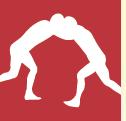
Wrestling
Description
Wrestling is a very natural sport for people who are blind because the two competitors are in physical contact with each other throughout the competition. International wrestling for those with visual impairments is very similar to "sighted" wrestling with some modifications. Wrestling requires upper and lower body muscular strength and endurance as well as speed, power, and agility. The object of wrestling is to "pin" the opponent (both shoulders) to the mat for a one-second count. Blind wrestlers often compete against their sighted peers.
For more information, visit: www.usaba.org.
Modifications/Suggestions
Competitors must maintain contact when in the standing position. This is done by touching fingertips; one hand up and one hand down.
VIGNETTE
Wrestling: Michael Begay
My name is Mike, and my visual impairment is albinism. Elementary school wasn't fun because some of the students picked on me, but middle and high school were enjoyable because I got a chance to experience sports. My mom gave me all the support I needed to participate in sports.
When I started middle school, my cousin introduced me to wrestling. I really took to it, and I continued wrestling through high school.
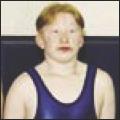 After high school, I attended a community college for one year. Now I attend classes to obtain certification in computer engineering, but my goal is to wrestle at the college level someday.
After high school, I attended a community college for one year. Now I attend classes to obtain certification in computer engineering, but my goal is to wrestle at the college level someday.
I prefer wrestling to other sports because it is more of an independent sport. When competing, it is just me and my competitor on the mat, one-to-one.
My greatest barrier in wrestling was not being able to see the person I was to face. This was resolved by using a tuck-start. That means the wrestlers can't let go of each other. The greatest barrier I face today is finding new wrestling programs in my community.
If you are interested in wrestling, keep in mind that it is hard at first, but your body will soon get the hang of it. Like everything else, it takes practice. You can do whatever you put your mind to.
Outdoor Recreation
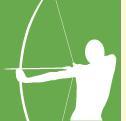
Archery
Description
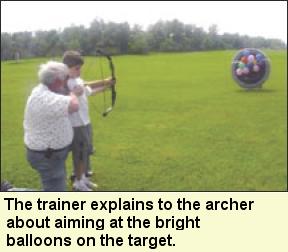 Archery is a skill event that requires using a bow to shoot arrows at a target to score points. The distance of the target varies as well as the scoring categories. The number of arrows shot also varies. Typically, the target has several circles each with a different color representing points. The closer to the center (or bullseye) the higher the point value.
Archery is a skill event that requires using a bow to shoot arrows at a target to score points. The distance of the target varies as well as the scoring categories. The number of arrows shot also varies. Typically, the target has several circles each with a different color representing points. The closer to the center (or bullseye) the higher the point value.
Modifications/Suggestions
- balloons on target
- tactile lining up: 8-foot long, one-inch steel diameter horizontal pole cemented to the ground; adjustable vertical T-pipe mounted into the ground
- electronic pointers: infrared systems used to train military recruits, the bow contains an infrared transmitter/receiver and the target would have a mirror that sends the transmitted signal back to the bow; a laser transmitter that projects a red dot and is used by deer hunters
- sound location device on target
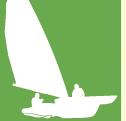
Blind Sailing
Description
Blind sailing consists of two or four people on a boat. If there are four, then two are blind, and two are sighted and serve as guides. The helmsman and one of the crew members are blind. The helmsman steers the boat while the crew trims the sails. The sighted members of the boat serve to assist in verbal guidance and safety. For more information, visit: http://www.blindsailing.org.
Modifications/Suggestions
Verbal instructions - "up three (degrees), down two, hold"
VIGNETTE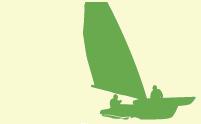
Sailing and Swimming: Matthew Chao
My blindness was caused by retinopathy of prematurity. I grew up in a very supportive family that encouraged me to be independent at an early age. I went to the same summer camps that my friends went to, never attending a camp for the blind.
Through age 19 I was educated at residential schools for the blind. After that, I graduated from Brandeis University. I received my Master of Education and Certificate of Advanced Graduate Studies in Vocational Rehabilitation Counseling Education from Springfield College. After graduate school, I worked for the Massachusetts Rehabilitation Commission for 8 years.
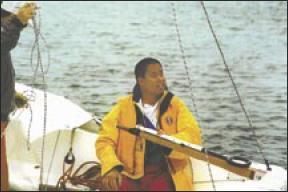 I completed the Hurricane Island Outwardbound School 6 day sea course. The group of 10 participants, half of whom were blind, was featured on the NBC show Sunday Morning Today. The group received help via the Carroll Center for the Blind, as well as a corporation.
I completed the Hurricane Island Outwardbound School 6 day sea course. The group of 10 participants, half of whom were blind, was featured on the NBC show Sunday Morning Today. The group received help via the Carroll Center for the Blind, as well as a corporation.
I currently work for the Massachusetts Department of Corrections where I oversee the production of braille books for school children. We produce these books utilizing computer technology and inmate labor. Yes, I actually work inside a prison; among my friends I joke that I "go to jail every day." It's quite an interesting experience; one left to describe some other time.
I first learned to swim while I attended the Michigan School for the Blind. I enhanced my swimming skills by attending a swim camp at the age of 10. My swim coach didn't cut me any slack, yet was very encouraging and supportive. While I never swam competitively, I've always enjoyed this activity. Currently I swim about 500 yards a day at the local YMCA as part of my exercise program.
As for sailing, I was introduced to it at age 16 while at Perkins School for the Blind. They had an experimental program with Community Boating Inc., a public sailing club in Boston. A few of us were selected to attend courses on sailing for two seasons. After that I didn't sail for 10 years. In 1980, I reentered sailing through the Carroll Center for the Blind's Outdoor Enrichment Program, and have been involved with sailing ever since. In my 24 years of sailing, I have competed in five World Blind Sailing Championships and race against sighted sailors when opportunities permit.
There are not too many barriers in swimming. I just have to let the lifeguards know when to tell me if other swimmers are sharing my lane. It helps to be assertive about your needs, both to other swimmers and the lifeguards. I have no trouble swimming at beaches or pools. If I need help, I ask for it.
As for sailing, the only major barrier I had was that of getting out on the water whenever I desired. In the beginning I would often wait for hours to link up with someone with whom I could go out and sail because you need someone with vision who can tell you how and where to steer. As I became more competitive, the major barrier became that of finding a coach/sighted guide who could help me advance to the next level of competitive sailing, who could teach me how to steer a more precise course on the water and be a better all-around racing sailor. Additionally, being a blind helmsman requires that I have a lot of trust in my sighted guides/crew. So, now I have two barriers at which I'm constantly working to overcome: getting more practice time on the water and getting as high quality coaching as possible. Again, being assertive here is indispensable. If you want something badly enough, you need to persevere. Come to think of it, perseverance carries over into life, such as getting that first or next job. As people who are blind, we need to work harder to get to where we want to go. There are no substitutes or shortcuts for hard work and persistence.
I have future goals in both these sports. First, I see both sports (swimming and sailing) as lifetime activities. In swimming, I pursue this activity to keep in shape physically, especially as I get older, and it becomes harder to keep the pounds off.
As for sailing, my goal is to be the best I can be as a competitive sailor and to compete in as many varied venues as possible. I would like to become more proficient in this sport by acquiring additional knowledge both technically and from an actual skills sets perspective. My main goal is to integrate into, and compete with sighted racing crews as an equal. Possible objectives could include
- participating in TransPac, a bi-annual race from San Francisco to Hawaii,
- getting into offshore cruising and competing in national racing events, and
- promoting sailing for those who are blind or visually impaired.
There are so many life skills you can learn from this sport: competitiveness, communications, physical fitness, orientation and body awareness, and most important, socializing with those who are sighted. It's a mutually beneficial experience.
Be realistic and be persistent. Ask questions when you don't understand certain things. Regarding sailing, make some calls to different sailing clubs and ask if they can give you sailing instruction/lessons. Also, be appreciative of those who are helping you.
Be willing to take risks. Think outside the box. You will not know whether you like something unless you make the effort to reach out. Above all, don't give up.
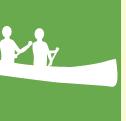
Canoeing
Description
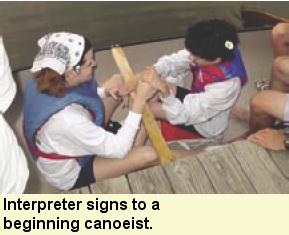 Canoeing is an outdoor activity that usually takes place on a river or at a lake. The participant sits in the canoe and uses oars to propel the canoe in the water. This activity is mostly recreational allowing the participants to enjoy the outdoors while paddling to develop upper body strength and cardiovascular endurance.
Canoeing is an outdoor activity that usually takes place on a river or at a lake. The participant sits in the canoe and uses oars to propel the canoe in the water. This activity is mostly recreational allowing the participants to enjoy the outdoors while paddling to develop upper body strength and cardiovascular endurance.
Modifications/Suggestions
- Verbal directional guidance
- Global Positioning Satellite System (GPS)
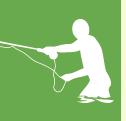
Fishing
Description
Fishing is a relaxing activity that can be done at a river, lake, or ocean. The idea is to catch fish for eating or just for sport (where the fish are returned safely to the water). Minimal equipment is required (fishing pole, bait, or other device to attract fish). Fishing can be done while standing outside or inside the water or in a boat.
Modifications/Suggestions
- Strong fishing lines are less likely to tangle.
- Push barbed ends of hooks into corks when not in use.
VIGNETTE
Fishing: David Dodge
Hello, my name is Dave and I am 14 years old. I have been visually impaired since birth, and I am an avid fisherman.
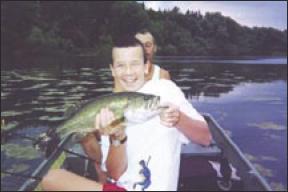 Dad taught me how to fish. When we are on the boat out in the middle of the lake, it is hard to see the lure go into the water. It is important to have a good cast to overcome this. The goal in fishing is to cast far and hard to try and catch as much as possible and to have as much fun as possible. You need to practice casting hard and precisely. There is something called your target zone and that is the place where you are trying to cast. Remember, you are the center of a circle, and you need to cast all around that circle.
Dad taught me how to fish. When we are on the boat out in the middle of the lake, it is hard to see the lure go into the water. It is important to have a good cast to overcome this. The goal in fishing is to cast far and hard to try and catch as much as possible and to have as much fun as possible. You need to practice casting hard and precisely. There is something called your target zone and that is the place where you are trying to cast. Remember, you are the center of a circle, and you need to cast all around that circle.
I prefer artificial bait including frogs, spinner baits, jitter bugs, and other items. The largest fish I ever caught was a 34-inch northern pike. The largest bass I ever caught was 19 inches. I am not sure what its weight was. When I fish with family or friends, I usually just measure the fish by inches.
Fishing does not require vision. I rely on sound and hearing. Most of all, fishing is a lot of fun!
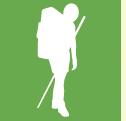
Hiking
Description
Enjoy the outdoors? Hiking may be for you. Hiking can take place at almost any outdoor area. There are a number of trails designed specifically for hiking. Many communities offer hiking clubs for all individuals. Hiking can be slow- or fast-paced depending on the desire of the participant. Different trails offer different levels of difficulty from mildly hilly terrains to small mountains to mountains of elevations over 12,000 feet. Hiking trips can last several hours or several days. Safe hikers travel in groups and have plenty of water and first aid supplies.
Modifications/Suggestions
- sighted guide (with or without a sound device)
- tether or rigid pole
- clear, verbal cueing
- distinct trail markings
- cell phone
- Global Positioning Satellite System (GPS)
Physical Characteristics Needed
(See Appendix A.)
Cardiovascular endurance
Lower leg strength
Where To Develop Skills for Hiking
School
Running, swimming, weight training, cycling, orienteering, survival skills, project adventure, gymnastics
Home
For fitness exercises see Appendix A under cardiovascular endurance and lower leg strength.
Community
Any trail, hiking clubs, community colleges/universities, outdoor courses
| Activity Rating Chart for Hiking | |||||
|---|---|---|---|---|---|
| 1 | 2 | 3 | 4 | 5 | |
| Social | X | ||||
| Exertion | X | X | X | ||
| Inclusiveness | X | ||||
| Participation | X | ||||
VIGNETTE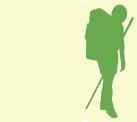
Hiking: Frank Mazza
The cause of my blindness is retinitis pigmentosa. Although my condition was diagnosed at age 18, I had no problems until age 43. I was employed with an investment banking firm as an institutional trader. I am now retired and spend more time hiking and camping.
My love of the outdoors began at an early age. My hiking experiences began when, as a youngster, I wandered into the woods alone, much to the chagrin of my parents, who had to come looking for me. These activities later progressed to hiking and camping trips combined.
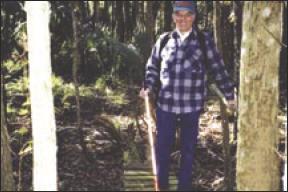 My father introduced me to hiking, camping, and also fishing. At present, I am still actively involved in these three activities.
My father introduced me to hiking, camping, and also fishing. At present, I am still actively involved in these three activities.
The barriers that I faced when I did lose my sight seemed to me, at the time, insurmountable. After overcoming the "why me" syndrome, I began to realize I would not have to give up things that I loved the most. All I had to do was make certain modifications and continue on my way. These modifications would not be possible without the help of my friends at the Alligator Amblers Chapter of the Florida Trail Association.
Before passing along the methods I use, I would like to say that under no circumstances should a blind person attempt to hike alone! The second piece of advice is to maintain oneself in good physical condition and agility.
The method I use in wild hiking is simple. When on the trail, the blind hiker walks behind the sighted hiker holding on to the end of the walking stick. This places both hikers walking in tandem with each hiker holding on to the stick.
My future goal for hiking is to continue hiking with vigor! I want to go hiking with my daughter on the 9 day, 109 mile "Big O" Lake Okeechobee Eco-Adventure hike in central Florida.
The advice I would give a person who is blind or visually impaired, and who would like to pursue hiking is to
- have a positive "I can do" attitude.
- maintain good physical condition.
- implement your own modifications and ideas.
- join a hiking organization in your area.
I may not have my sight, but I still have vision.
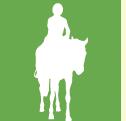
Horseback Riding (Equestrian)
Description
Horseback riding can be done recreationally by simply riding a horse. It can also be done competitively by participating in sanctioned events. There are jumping events and technical events (Dressage). This activity can be quite expensive regardless of whether or not you own your horse. Horseback riding is available in many communities and can be enjoyed recreationally, usually with some moderate fee. A general search on the Internet will provide you with many stories involving visually impaired horseback riders as well as locations of many stables where you can learn to ride.
Modifications/Suggestions
- verbal feedback
- tactual communication for riders with deafblindness
VIGNETTE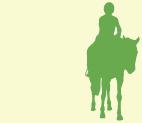
Horseback Riding (Equestrian): Quinn Burch
I have a mitochondrial disorder that causes me to have auditory neuropathy and optic nerve neuropathy.
Being legally blind and post-lingually deaf, I use my voice to express myself and a total communication approach using American Sign Language (ASL) in English word order for receptive communication. Deaf people use ASL as the main communication mode, and it is difficult for me to see. Most hearing people can't sign.
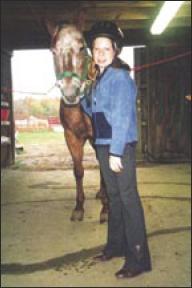 My direct family support is good. My family members who live with me sign, both my parents are involved in my education, and both parents are involved in organizations and support groups that help me learn to be more independent. Outside the direct family, only my cousins in Kentucky, a 13-hour drive, and my uncle in Virginia, a 6-hour drive, sign.
My direct family support is good. My family members who live with me sign, both my parents are involved in my education, and both parents are involved in organizations and support groups that help me learn to be more independent. Outside the direct family, only my cousins in Kentucky, a 13-hour drive, and my uncle in Virginia, a 6-hour drive, sign.
I am in the seventh grade and have made the honor role in a mainstreamed program in the Guilderland School District every semester in middle school. I have a one-to-one interpreter, and all my books and homework are in braille.
I have fun helping a friend in a snack bar at a bowling alley by stacking plates and serving fountain drinks.
I started riding horses on my first birthday when my parents had pony rides at my party. While at a festival, my dad saw a flyer for therapeutic horseback riding and asked if I wanted to try.
The biggest barrier was the means of communication while I rode the horse. Another barrier was for the stable to trust in my ability to ride. These barriers resulted in the first riding stable not letting me ride by myself. I was very frustrated because there was always an aide on my right side, an aide on my left, and an aide holding a lunge line. I became very bored at this riding stable.
At the second stable I had the same barriers, but at this stable I had a little more interaction with the horse. I learned how to brush and saddle the horse, and to pick the horse's hooves. However, I always had one or two aides around me controlling the situation. With some teamwork, we came up with a communication method by tapping my leg a different number of times for each of the riding commands. For example, one tap meant go, two taps meant left, etc. I really liked this stable, but they raised their price so high that my family could not afford to send both my sister and me, and we could not find any funding in our area.
Since that stable, I have been implanted with a Nucleous 24 Cochlear Implant. My family located a stable close to our house that is affordable. My instructor at this stable, Sandy, has great trust in her animals and also in me. I now have the responsibility of getting my horse ready by myself. I usually need assistance with putting on the bridle, but everything else I do by myself with a person from the stables or a parent standing by just in case something happens. Sandy lets me walk and trot without any side walkers and with no lunge line. With the implant, Sandy gives me commands using her voice. I can now canter (run) on the horse, but only on a lunge line. The most amazing thing is that Sandy has taught me to jump fences.
The biggest barrier I face now is to find a stable that will allow me to ride alone. My future goal is to be able to ride on open trails and maybe in some horse shows. I need to learn to keep control of the horse better before I will be ready to ride alone on open trails.
Being blind should not be an issue when pursuing horseback riding. The relationship you develop with the horse is the important part, and that should not be impacted if you are blind or sighted. There are inside arenas so bumping into things should not be an issue, and you could have a coach telling you the commands while you are riding. I would encourage anyone who is blind or deafblind to ride; the bond between the rider and the horse can be refreshing for both parties.
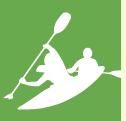
Kayaking
Description
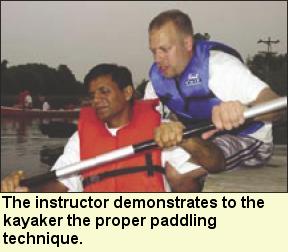 Kayaking is an activity that puts you in a kayak out on a lake, river, or ocean. A kayak is a long, narrow, low-riding boat, similar to a canoe. On some kayaks the top is covered except for the hole(s) for the paddler's body to sit down into the boat. Kayaks are designed for one or two paddlers. The object is to navigate through the water using a paddle. This activity allows you to enjoy beautiful scenery and experience the sounds of nature while getting a cardiovascular, muscular strength, and endurance work out. For more information, visit: http://www.kayaking.com or http://www.seakayaker.org/.
Kayaking is an activity that puts you in a kayak out on a lake, river, or ocean. A kayak is a long, narrow, low-riding boat, similar to a canoe. On some kayaks the top is covered except for the hole(s) for the paddler's body to sit down into the boat. Kayaks are designed for one or two paddlers. The object is to navigate through the water using a paddle. This activity allows you to enjoy beautiful scenery and experience the sounds of nature while getting a cardiovascular, muscular strength, and endurance work out. For more information, visit: http://www.kayaking.com or http://www.seakayaker.org/.
VIGNETTE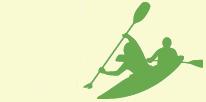
Kayaking/Canoeing: Paul Ponchillia
I lost all of my vision in a hunting accident when I was 30 years old. Before that time, I had been an avid outdoors person and had spent hundreds of hours in a canoe, particularly in the wilderness areas of the northern U.S. and Canada. I have a Ph.D. and am presently a professor and the Chairperson of the Department of Blindness and Low Vision Studies at Western Michigan University. I use a dog guide, which is a great deal of help on hiking and other outdoor trips.
I learned about kayaking by reading about Inuit people and their culture. They invented the Greenland kayak, which is the type I use. Mine is an ocean-going, 22-foot tandem kayak that my wife, Sue, and I get out in every time we can. We have been going to the Arctic on hiking or kayaking trips for more than 20 years.
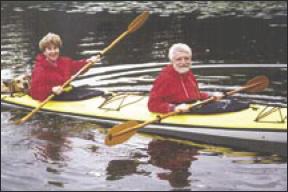 When I started canoeing, the barriers were the usual for people who are blind, that is attitudinal. I joined a canoe club and spent much of my time having to prove to the members that I was a capable paddler, since they initially focused more on my blindness than on my ability to paddle or my knowledge of canoes or kayaks. Ultimately, the question that comes up is, "How in the world can a blind person be out in Lake Michigan or off the Alaskan coast in a kayak?" The obvious answer being: "Paddling has little to do with sight. And nearly all canoeists and many kayakers do their paddling with partners."
When I started canoeing, the barriers were the usual for people who are blind, that is attitudinal. I joined a canoe club and spent much of my time having to prove to the members that I was a capable paddler, since they initially focused more on my blindness than on my ability to paddle or my knowledge of canoes or kayaks. Ultimately, the question that comes up is, "How in the world can a blind person be out in Lake Michigan or off the Alaskan coast in a kayak?" The obvious answer being: "Paddling has little to do with sight. And nearly all canoeists and many kayakers do their paddling with partners."
My wife and I are working to get closer and closer to the North Pole. We plan to paddle with an outfitter in North Greenland, some 400 miles from the Pole next summer. The area is especially attractive to me because of the booming sounds of calving icebergs, the sloshing-slurring sound of icebergs turning bottom side up as they melt in the ocean, and the deep-throated breathing of huge walruses sunning on ice floes. One of my other goals is to paddle across Lake Michigan as a fund-raiser for our local Michigan Sports Education Camp.
If you want to pursue kayaking or canoeing, find a local club and be patient with the questions from the members. Read about the sport and know as much as you can, so you can "talk the talk." If you ask a friend to kayak with you, do a favor in return. If you can, buy a kayak and make it easy for your partner to have a boat available, and do everything you can to alleviate your partner's work load during your kayaking trips. Learn how to be the one to push off and board last, tie up and untie the boat, load and unload the life jackets and spray skirts from the storage compartments, and clean up the gear after the trip.
Another approach to getting started is to find commercial kayak adventure trips offered by outfitters. These trips range in difficulty from paddling small lakes to ocean trips. These guided trips are an excellent way for a novice to learn, since lessons are usually part of the trip cost. It is also possible to paddle a single sea kayak with no sighted assistance. Once in a while, I paddle our canoe around without a sighted partner. I just set up a sound beacon, such as a portable radio, on shore to keep myself oriented. I haven't done it yet, but I plan to use my talking Global Positioning System (GPS) in a kayak this summer.
There aren't many "work arounds" with tandem kayaking. The few that are required are much like the ones used with tandem cycling. That is, getting started and stopping without tipping over. Learning to do this efficiently takes practice and is essential, since most canoe and kayaking tippings occur when pushing off or landing. Learning to use a double-bladed kayak paddle is also a bit of a trick, and beginners should avoid a "feathered" or offset paddle. The easiest way to deal with steering is to use a kayak with a foot-operated rudder instead of trying to do it by paddling. Happy kayaking!
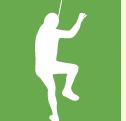
Rock Climbing
Description
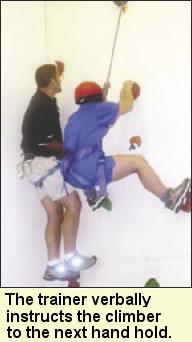 Rock climbing is designed for the outdoor enthusiast. Rock climbing combines physical exertion with determination and self motivation. The goal is for the participant to climb up a rock wall. Rock climbing is an activity that requires training to participate in safely as accidents can occur. Typically, the rock climber is trained in climbing techniques, rope use, and spotting to maximize safety. These climbing techniques can be learned at an indoor rock climbing facility, which many communities have. The cost of participation is usually minimal for ropes and other climbing gear.
Rock climbing is designed for the outdoor enthusiast. Rock climbing combines physical exertion with determination and self motivation. The goal is for the participant to climb up a rock wall. Rock climbing is an activity that requires training to participate in safely as accidents can occur. Typically, the rock climber is trained in climbing techniques, rope use, and spotting to maximize safety. These climbing techniques can be learned at an indoor rock climbing facility, which many communities have. The cost of participation is usually minimal for ropes and other climbing gear.
Modifications/Suggestions
- auditory cue for finding rock/hand holds, cane tapping
- implement clock system--right foot at 12:00 (straight up) or left foot at 9:00 (left)
- auditory signal on ceiling (for indoor climbing)
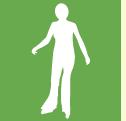
Roller Blading
Description
Roller blading or inline skating is a very popular activity. For roller blading, you basically wear two shoes with wheels on the bottom. Wrist protectors, arm and knee pads, and a helmet are the other pieces of equipment you will need. You can roller blade for fun, recreation, or competitively. There is a governing body called the International Inline Skating Association that holds events and clinics. For more information, visit: http://www.iisa.org/.
Modifications/Suggestions
- sighted guide
- tether
- wall support as guide
- guide wire
- longer cane
VIGNETTE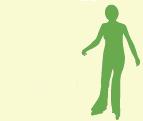
Roller Blading: Stacy Cervenka
I was born with optic nerve hypoplasia and grew up attending my neighborhood public school. I am currently a senior in college, double majoring in French and Italian with minors in sociology and theatre. I currently work part-time at a Christian crisis pregnancy center.
My sisters and I grew up going to the roller rink near our house. We spent many birthdays and Friday and Saturday nights skating to 80s and early-90s techno music. In the mid-90s, the old-school four-wheel roller skates went out of vogue. Everyone was getting inline skates or roller blades, so my sisters and I did as well.
My city has many high quality biking and inline skating paths around its many lakes and alongside some of its busiest streets. When I first moved here, one of my friends, who is a blind orientation and mobility instructor, told me the techniques she used to roller blade safely around the lakes, and I incorporated them into my own style.
I can't say I face any particular physical barriers, only attitudinal ones. Many people are shocked to see someone whizzing around the lake with a long white cane! Some people might consider blind roller blading unsafe, but I believe that this mindset is based on outdated notions about the capabilities of blind people. The thing that helps me overcome the attitudinal barriers I sometimes face in public is to continue getting out and doing it! I also find talking and sharing "war stories" with other roller blading cane users to be of great benefit to me.
Roller blading is such a great lifetime fitness activity. It promotes good physical health, broadens your social opportunities, and is a great stress-reliever. Inline skating is very beneficial for building up cardiovascular endurance and lower-body strength. It's also an excellent way to spend an afternoon with friends. A lot of college students choose to roller blade to and from their destinations and skating alongside your friends around town is a quiet yet effective way of educating the public about the capabilities of blind people. Furthermore, when I choose to skate alone, I always meet tons of interesting people on the bike paths and people often stop to talk to me, which provides me with yet another opportunity to share a positive view of blindness. However, if you're not in the mood for conversation and you just need some alone time, roller blading is an excellent way to relieve stress. Just get away by yourself for awhile and feel that adrenaline rush! I love the sensation of pure speed, power, and wind! As you can see, roller blading is an excellent lifetime fitness activity that I plan on pursuing as long as my fingers will allow me to lace up my skates!
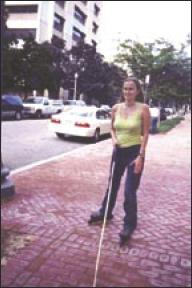 When I first started attending a large university, I thought it would be unsafe to roller blade around such a huge campus. However, as is often the case, I realized that I was underestimating my own abilities and putting arbitrary limits on myself. It was actually a sighted friend that helped me realize this and now I roller blade to classes sometimes.
When I first started attending a large university, I thought it would be unsafe to roller blade around such a huge campus. However, as is often the case, I realized that I was underestimating my own abilities and putting arbitrary limits on myself. It was actually a sighted friend that helped me realize this and now I roller blade to classes sometimes.
If you are interested in roller blading, I recommend that you use a cane that's at least taller than you are. You're higher up off the ground when you're on roller blades and you're also traveling faster. I've found that the hollow fiberglass canes work best since they're so light. Do not use a telescoping cane when roller blading alone. Talk about a recipe for disaster!
If you haven't roller bladed alone much, or you haven't roller bladed alone since you became blind, start slowly and get used to it. Experiment with how long it takes you to stop and how much warning your cane gives you. This is why bike trails are so nice. Your local neighborhood sidewalks would probably be okay, but maybe wait to try them until after you've gotten a little more confident with your braking and turning abilities.
When roller blading alone, using your cane is very practical and safe. However, when roller blading in a group, it's often helpful to have a friend hang onto one side of a short, flexible item, such as a shoestring or small piece of rope and you hang onto the other. No, the goal is not for your friend to pull you along! You're not looking to be dead weight; this will simply help the two of you stay together.
Push yourself and be wary of internalizing ideas on arbitrary limits on what you, as a blind person, can do!

Scuba Diving
Description
SCUBA diving is usually done in the ocean, but divers also explore other bodies of water, including lakes, rivers, and ponds. Snorkeling on the surface (or just below) is a common form of diving, but many people use SCUBA, which stands for self-contained underwater breathing apparatus. SCUBA divers carry a tank of air that allows them to breathe while deep underwater.
Invented in 1943 by Jacques Cousteau, SCUBA diving has become an extremely popular sport with almost one million people each year acquiring certification to recreationally SCUBA dive.
The technology today allows for most people to safely participate in this exciting adventure. In order to SCUBA dive, you need to become certified. Many communities offer certification courses. Once you become certified, you can SCUBA dive throughout the world in many exotic locations. There is also an organization set up specifically for people with disabilities. For more information, visit: http://www.hsascuba.com/.
Physical Characteristics Needed
None
Where To Develop Skills for SCUBA Diving
School
Swimming, water polo, survival skills, surfing, diving
Home
Internet research and studying for SCUBA certification
Community
SCUBA trips
| Activity Rating Chart for Scuba Diving | |||||
|---|---|---|---|---|---|
| 1 | 2 | 3 | 4 | 5 | |
| Social | X | ||||
| Exertion | X | ||||
| Inclusiveness | X | ||||
| Participation | X | ||||
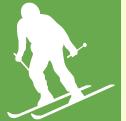
Snow Skiing: Alpine (Downhill) and Nordic (Cross-Country)
Description
Alpine skiing is a winter sport that takes place in mountainous areas that have snowfall. Alpine skiing can be done at resorts designed specifically for skiing. Nordic skiing is also available at mountain resorts designed specifically for that purpose as well as any flat outdoor/wilderness area with snow on the ground. Alpine skiing is offered both recreationally and competitively. For the competitor, the following events are offered: Slalom (a race, with assistance from a guide in blind skiing, where the skier moves as fast as possible down a zig zag course), Giant Slalom (similar to Slalom but with further spaced zig zags, usually done at faster speeds), Super Giant Slalom (similar to Giant Slalom but a much longer course at faster speeds), and Downhill (the fastest of all ski races with few turns). For more information, visit: http://www.ibsa.es/eng/deportes/alpineskiing/presentacion.htm or http://www.absf.org.
Modifications/Suggestions
Alpine
- Use an adapted ski instructor.
- verbal or visual guide (beside or behind)
- clear commands ("Easy right, begin now." "Slow for a stop, slow, slow, ready, stop." Some guides use the clock face for turning degree instead of "easy or hard.")
- B1 competitors must wear dark goggles.
- Wear bright orange pinnies that say "blind skier."
- The bi-ski is a fiberglass shell mounted above two unique skis that give improved stability over the mono-ski. The bi-ski allows seated skiers some versatility to ski with either fixed outriggers (catamaran-type), which increases the skier's ability to make controlled turns, or with short hand-held outriggers. The bi-ski can be used by students with various disabilities.
- tether pole guides
- ski bra (metal clip to hold skis together)
- minimal ski traffic
Nordic
- guide (in front, side-by-side, or in back)
- continuous verbal contact or sound device
- clear commands ("Trees close on left.")
- clear (indented) tracks
- B1 competitors must wear black goggles.
- Caution: Never grab a ski pole to keep a skier from falling. Shoulder joints can be dislocated.
Physical Characteristics Needed
(See Appendix A.)
Cardiovascular endurance
Lower body strength and endurance
Where To Develop Skills for Skiing
School
Snowshoeing, track and field, weight training, ice skating, hiking, gymnastics, body/strength conditioning
Home
See Appendix A for fitness activities under cardiovascular endurance, lower body strength, and endurance.
Community
Resorts, ski clubs, and parks
| Activity Rating Chart for Skiing | |||||
|---|---|---|---|---|---|
| 1 | 2 | 3 | 4 | 5 | |
| Social | X | ||||
| Exertion | X | X | X | ||
| Inclusiveness | X | ||||
| Participation | X | X | X | X | X |
VIGNETTE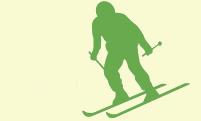
Alpine Skiing: Megan Stanger
Hi, my name is Megan, and I have CHARGE syndrome, a rare congenital disorder and one of the leading causes of deafblindness. My visual impairment is due to bilateral retinal coloboma. I do not have central vision, but I can use my peripheral vision very well. I am 11 years old, and I live in New York with my mom, dad, my 7½-year-old brother Matthew, and my dog, Kasey.
I learned about downhill skiing from my mom and dad. They both love to ski. I learned to ski when I was 3 years old and could barely walk. Before I took lessons, my mom and dad would drag me around on plastic skis and would hold me up. I took my first lesson in Vail, Colorado, with an adaptive instructor named Judy. I barely remember her because I was so little. I've been skiing with Karen, another adaptive instructor from Vail for the past 5 years.
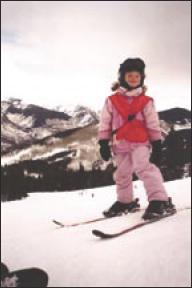 When I was very young, I had poor balance so it was hard to just stand up on skis. My instructor used a harness with me and clipped the tips of my skis together. I fell a lot! I also had a short attention span in my younger years, and they kept me focused by holding a colorful ball with a tail, and I nicknamed it my "buddyball."
When I was very young, I had poor balance so it was hard to just stand up on skis. My instructor used a harness with me and clipped the tips of my skis together. I fell a lot! I also had a short attention span in my younger years, and they kept me focused by holding a colorful ball with a tail, and I nicknamed it my "buddyball."
I no longer use a harness or clips, and I can ski all day with some breaks. I wear a helmet for safety, goggles to protect my eyes, and a bright orange vest that says "Blind Skier" so people don't ski too close to me. I need to ski with an adaptive instructor. Sometimes I follow her, and we play games, and other times she skis backwards in front of me on more challenging hills and tells me when to turn and when to stop. I am also hearing impaired, so she needs to face me so that I can hear her directions. The helmet makes it a bit harder to hear. I love speed and now ski on intermediate slopes (blues). My instructor has to remind me to slow down and turn. I also love the bumps. I like skiing in the woods too, but sometimes hold onto the waist of my instructor so she can guide me through the trees safely. Now that I'm older, I ski on more difficult terrain and have to listen carefully to instructions. I try to stay away from very crowded slopes.
One barrier I face now is being able to get an adaptive instructor who can ski with me. We need to plan way ahead to get someone, so it's hard to just pick up and go skiing for the day closer to home. Especially if that ski mountain doesn't have adaptive instructors. I wish all ski mountains had adaptive instructors.
One day I would like to ski on black diamonds (most difficult) and get to ski more each winter. I would also like to be in the Paralympics in the future because I love downhill skiing.
My advice to anyone who would like to ski is, "Don't be scared--it's fun!" I really, really love it. You need a good instructor and a lot of patience in the beginning because you fall a lot. But it doesn't hurt. Don't let your visual impairment or blindness stop you from skiing. Your guide or instructor can be your eyes. Remember, always ski with people who support you.
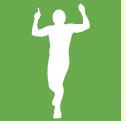
Triathlon
Description
The triathlon is a combination of three events: swimming, bicycling, and running. The distances vary depending on the level of competition. Typically, the swim is a quarter mile, followed by a 10 kilometer bike ride, ending with a 5 kilometer run. Triathlons can be performed individually (with the individual participating in each event) or using team formats where there are three members of the team with each member participating in one event. Triathlon is offered as a community event to all individuals. The ultimate triathlon event is called the "Iron Man," which is a 2.4-mile swim, a 112-mile bike ride, and a marathon run (26.2 miles). For more information, visit: www.active.com.
Modifications/Suggestions
Running
any guide running technique
Bicycling
tandem
Swimming
tether (belt around waist with rope connected to belt around guide's waist)
VIGNETTE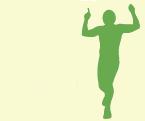
Triathlon: John Boes
The cause of my blindness was glaucoma and retinal detachment during my high school and college years. I attended public schools without special adaptations, as I was still able to use some of my vision at that time. I had strong family support. After high school, I acquired a bachelor's degree in sociology and master's degrees in rehabilitation teaching and in rehabilitation counseling. I have been employed as a teacher and/or counselor at the Michigan Commission for the Blind for over 28 years.
 I began running short races at the age of 34 with friends and partners who then introduced me to longer events, such as 5Ks, 10Ks, 15Ks, half-marathons, marathons, and triathlons. Although I ran in a 10-mile race in Flint, Michigan, with several other blind individuals, I was the only blind athlete in all triathlon competitions. My first triathlon was the Niles Triathlon in Niles, Michigan. My favorite sport of the triathlon is running since I have done it the longest. It seems the most natural for me. Cycling is a recuperative sport in the middle after swimming. I love the speed of cycling. My most difficult sport is swimming since the contact is not there. My partner swims next to me, guiding via verbal clues. But the rush of completing a triathlon is great!
I began running short races at the age of 34 with friends and partners who then introduced me to longer events, such as 5Ks, 10Ks, 15Ks, half-marathons, marathons, and triathlons. Although I ran in a 10-mile race in Flint, Michigan, with several other blind individuals, I was the only blind athlete in all triathlon competitions. My first triathlon was the Niles Triathlon in Niles, Michigan. My favorite sport of the triathlon is running since I have done it the longest. It seems the most natural for me. Cycling is a recuperative sport in the middle after swimming. I love the speed of cycling. My most difficult sport is swimming since the contact is not there. My partner swims next to me, guiding via verbal clues. But the rush of completing a triathlon is great!
The main barrier I faced was a lack of understanding by the organizers of the running events. My partner and I just performed and demonstrated my abilities.
Being a blind person in a road race is a great opportunity to educate the public. I still continue to run, but not competitively, averaging 4 miles per day, either outside or on a treadmill. I don't have much time for swimming these days, so I concentrate on cycling, just for pleasure with my children.
My goal for the future is to continue running to stay healthy, and to ride my bicycle for recreation throughout my life.
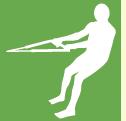
Waterskiing
Description
Waterskiing is a fantastic water event that is offered at many levels. Many people water ski recreationally on the weekends using a personally owned boat. Waterskiing takes place in a lake or river. There are several variations of waterskiing (single ski, wake boarding). The participant is pulled in the water by a boat while holding onto a handle that is attached to a rope connected to the boat. The skill is in staying up on the ski or board and literally "gliding" or skiing on the water. For more information, visit: http://www.planetwaterski.com/wdc4.htm.
Modifications/Suggestions
- skier uses hand signals (thumb down for slower, thumb up for faster, hand slice across neck to stop)
- whistle signals (one short blast tells skier to get behind boat, another blast when it is clear to cross the wake, two blasts when the boat is about to turn, and a long blast to tell the skier to let go of the handle)
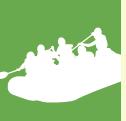
White Water Rafting
Description
White water rafting is for individuals who love outdoor water sports. There are five levels or "classes" of water rafting based on the speed of the river and number of obstacles (rocks). Class 1 is the easiest with typically calm, slow-flowing waters. Class 5 is the most intense, usually reserved for expert rafters. Most often you will participate in a rafting trip with a guide and up to 11 other people in a raft. Each person is trained prior to the trip on safety and paddle techniques. Most communities offer rafting opportunities. For more information, visit: http://www.raftingamerica.com or http://www.etctrips.org.
Social Recreation Activities
Any Team Sport
Any Dual Sport
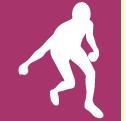
Bocce
Description
Bocce has been around since the days of the Roman Empire. It is played on a hard-surface court with a backstop at each end. Backstops are placed 60 feet apart. Backstops are 12 feet wide with 4-foot sides and at least 4.5 inches high. There is a foul line marked 10 feet from each backstop. Two sizes of balls are used to play bocce. The target ball is called the pallina and is about 2.25 inches in diameter. The team balls are called bocces and are about 4.25 inches in diameter. Four bocces are used for each team and are color-coded by team (different color from the pallina). Teams consist of one to four players on each side. The object of the game is to get your bocces closest to the pallina. The team with the closest number of balls gets one point for each ball closer than their opponent's balls. Bocce is played recreationally in many communities. Similar to bocce, Pétanque or Les Boules (lay-BOOLZ) is a very popular sport in France. Some call it "lawn bowling" in America. People have been playing Les Boules for a very long time. In fact, archaeologists have found drawings on the walls of ancient Egyptian pyramids of men and women lawn bowling! For more information, visit: http://www.usapetanque.org, http://petanque.org, http://www.bocce.org/history.html, http://www.bocciainternational.com (This site explains modifications using chutes and ramps.)
Modifications/Suggestions
- verbal feedback of ball positions (use clock face directions)
- sound location device next to balls
- tapping ball for auditory cue
- verbal cueing for body positioning
- paint balls bright colors
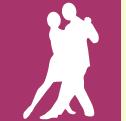
Dancing
Description
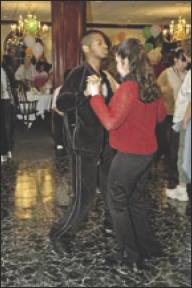 Most forms of dancing are offered for competition and recreational socializing. Ballroom dances include Waltz, Tango, Foxtrot, and Quickstep. Part of ballroom dancing includes Latin dancing (Cha Cha, Samba, Rumba, and Jive). Folk dancing is a traditional dance of the common people of a country or region that is performed to that country's traditional music. Many folk dancing groups perform throughout their communities at festivals. Ballroom dances are considered folk dances. Some other examples of folk dancing are contra dance, Morris dance, clogging, sword dance, traditional square dance, and all other forms of traditional and ethnic dance. Social dancing includes East Coast Swing, West Coast Swing, Lindy Hop, Salsa, and even the Electric Slide. Lastly, social dancing can be any dancing variation that is used at a dance club or other nightclub that is for the purpose of meeting other people and getting a cardiovascular workout. For more information, visit: http://www.usabda.org.
Most forms of dancing are offered for competition and recreational socializing. Ballroom dances include Waltz, Tango, Foxtrot, and Quickstep. Part of ballroom dancing includes Latin dancing (Cha Cha, Samba, Rumba, and Jive). Folk dancing is a traditional dance of the common people of a country or region that is performed to that country's traditional music. Many folk dancing groups perform throughout their communities at festivals. Ballroom dances are considered folk dances. Some other examples of folk dancing are contra dance, Morris dance, clogging, sword dance, traditional square dance, and all other forms of traditional and ethnic dance. Social dancing includes East Coast Swing, West Coast Swing, Lindy Hop, Salsa, and even the Electric Slide. Lastly, social dancing can be any dancing variation that is used at a dance club or other nightclub that is for the purpose of meeting other people and getting a cardiovascular workout. For more information, visit: http://www.usabda.org.
Modifications/Suggestions
- clear, precise descriptions
- braille representation of dance steps
- visual, tactile cues on floor
- one word cues to build dance sequence
Physical Characteristics Needed
(See Appendix A.)
Rhythm
Cardiovascular endurance
Where To Develop Skills for Ballroom, Folk, and Social Dancing
School
Aerobics, martial arts, Jazzercise®, gymnastics
Home
Learning dance steps to music, videos
Community
Dance clubs, nightclubs, camps
| Activity Rating Chart for Dancing | |||||
|---|---|---|---|---|---|
| 1 | 2 | 3 | 4 | 5 | |
| Social | X | ||||
| Exertion | X | X | X | X | |
| Inclusiveness | X | ||||
| Participation | X | X | X | ||
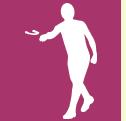
Horseshoes
Description
Horseshoes is a game of skill that requires the players to score points by "pitching" the horseshoe onto the stake (a 14-15-inch long by one-inch round pole) in the opponent's pitching box. The pitcher's box is a 6-foot square area at each end of the court, and is filled with clay, dirt, or sand. The court is 6 feet wide and a minimum of 46 feet long. The pitcher's box has two pitching platforms on each side from which the players throw their shoes onto the opposing stake. On regulation courts, the stakes are set 40 feet apart, but this can be altered to meet backyard dimensions and players' capabilities. It is advisable to use a backboard at least 3 feet behind the stake and one-foot high, extending the width of the pit. The length of play shall be determined prior to beginning play. There are three ways of playing: point limit, shoe limit, or point/shoe limit --whichever comes first. Scoring involves "ringers" (three points) and shoes within 6 inches of the stake (one point). A ringer is when the shoe encircles the stake so that both heels of the shoe are in front of it. For more information, visit: http://www.horseshoepitching.com, http://www.appc1.va.gov/vetevent/gag/rules/adaphorseshoes.cfm, or http://www.midniteringers.org.
Modifications/Suggestions
- verbal feedback of horseshoe positions
- bang on stake for auditory cueing
Physical Characteristics Needed
None
Where To Develop Skills for Horseshoes
School
Bowling, shuffleboard, bocce, goalball
Home
Backyard
Community
Horseshoe pits, clubs
| Activity Rating Chart for Horseshoes | |||||
|---|---|---|---|---|---|
| 1 | 2 | 3 | 4 | 5 | |
| Social | X | ||||
| Exertion | X | ||||
| Inclusiveness | X | ||||
| Participation | X | X | X | ||
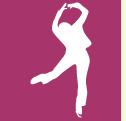
Ice Skating
Description
Similar to roller blading, the participant puts on ice skates (shoes with a metal blade running the length of the shoe) and "skates" on ice. This event usually takes place indoors in an ice skating arena. There are two basic types of skates, hockey skates and figure skates. Skating is a good cardiovascular exercise that also works out the lower body. Many people skate for fun and the challenge of "walking" on ice. Other people figure skate competitively. For more information on figure skating, visit: http://www.usfsa.org or http://www.sabahinc.org/overview/.
Modifications/Suggestions
- walker or chair with curved metal legs
- tether
- sighted guide
- auditory cueing
- wall as guide
Physical Characteristics Needed
(See Appendix A.)
Flexibility
Lower body strength
Balance
Where To Develop Skills for Ice Skating
School
Dance, ballet, yoga, alpine skiing, gymnastics, aerobics
Home
See Appendix A for fitness under flexibility, lower body strength, balance.
Community
Community ice rink
| Activity Rating Chart for Ice Skating | |||||
|---|---|---|---|---|---|
| 1 | 2 | 3 | 4 | 5 | |
| Social | X | X | X | ||
| Exertion | X | X | |||
| Inclusiveness | X | ||||
| Participation | X | X | X | ||
VIGNETTE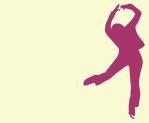
Ice Skating: Jentry Courter
I was born with albinism and have been legally blind since birth. I am 14 years old and live in what I consider to be a typical household, with both parents, a big sister (also with albinism), a dog, lots of friends, and more love than most people experience. My mom says I came out with a very large personality and great enthusiasm for life. When I was little, everything was an adventure. If a moment was not exciting enough, I would find a way to make it a little (or a lot) more dramatic.
With so much energy, I needed to stay busy. I played soccer (very comical), did tap, jazz, ballet, and tried a little piano by age 5. Although I liked all of these activities, none of them kept my interest for very long. I always needed something new to try. Don't tell me that I can't do something because of my lack of vision; I will prove you wrong. You could say I am very competitive.
One Thanksgiving, on a trip to San Antonio, Texas, with my grandparents, I went to an ice rink. I was 5 years old when I took my first step out onto the ice. I did not take to the ice like a duck takes to water, but I loved it. The passion was already rising up. 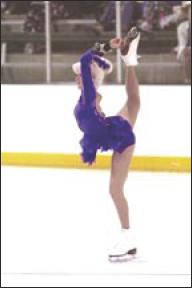 Everyday I would ask my mother to go ice skating. She would explain that the nearest rink was about 5 hours from where we lived, so I would say, "So...when can we go?" About 2 years later a rink was built in a mall just 20 minutes away. I started group lessons the first week the rink opened. I wanted to go every day. Before long I was taking private lessons, and I entered my first competition in Wichita, Kansas. I took first place in the free skate (that's skating to music) and came home with even more fuel for my new love.
Everyday I would ask my mother to go ice skating. She would explain that the nearest rink was about 5 hours from where we lived, so I would say, "So...when can we go?" About 2 years later a rink was built in a mall just 20 minutes away. I started group lessons the first week the rink opened. I wanted to go every day. Before long I was taking private lessons, and I entered my first competition in Wichita, Kansas. I took first place in the free skate (that's skating to music) and came home with even more fuel for my new love.
Seven years have gone by, and I can't imagine life without skating. My mom began home schooling me in the fourth grade so I could skate 3-5 hours a day. I love the freedom that home schooling affords; I can compete anytime and anywhere and still stay caught up with schoolwork.
My long hours and hard work on the ice have been worth it. I have won several gold, silver, and bronze medals; been featured in a couple of newspaper and magazine articles, and done some television interviews. I am ever so grateful for the gift God has given me. I love practicing to Christian music, and my faith gives me the confidence to persevere.
Even though it seems that I have been on the top of my sport most of my career, there have also been some heartbreaking times. I came in dead last in every event in a competition in Arizona and failed my intermediate test three times before finally passing. Skating is not always fair and has its share of difficulties. The greatest obstacle is skating in practice sessions at other rinks with girls who may or may not know about my visual impairment. There are usually 15 to 20 other girls on the ice. This is difficult because of my depth perception; I am never really sure how close they are to me, but somehow I manage. Finding my coach at other rinks can be hard too. Coaches tend to wear dark suits, and it takes me several seconds to figure out where he is standing until I hear his voice.
Few people in the small skating world do not know who I am. "You know Jentry Courter, that white-haired, visually impaired figure skater." Once people get beyond the physical differences and they get to know me for who I am, they respect and like me just like any other figure skater.
For skating there are eight levels of competition: pre-preliminary, preliminary, pre-juvenile, juvenile, intermediate, novice, junior, and senior. Being a senior affords the opportunity to qualify for the Olympics. I have several goals for figure skating. I want to become a senior lady at age 15, to compete in Nationals, the Olympics, and the World Figure Skating Competition. I also want to meet Alexei Yagudin (my favorite figure skater).
I have a passion for anyone with any kind of disability, whether it's ADHD, dyslexia, or any kind of physical handicap. My advice to anyone with or without a disability is to follow your heart, trust in God, and not let anything stand in the way of something you might like to pursue.
Preferred Activities Chart
Okay, now it is time to fill out the Preferred Activities Chart. You should select up to six activities. Use the chart to list each activity you choose. In the column next to the selected activity, you are to write down why you chose that activity and/or why you want to try it. This will help you narrow down your choices later.

 Participants Who Are Deafblind
Participants Who Are Deafblind
In the following chart you may want to add a section on how you believe you will communicate during the activity. This will help you to start thinking about how you will learn a new activity and how you will gain potential social benefits.

Variable Preference Table
(Photocopy as needed or use the CD version.)
| Activity | Why I like this activity and want to try it |
|---|---|
Chapter 4:
Awareness
Knowing what is available in your surroundings and how accessible each activity is gives you valuable information when choosing leisure time activities. This chapter discusses support information, the various opportunities available to you, and where and when you can access them.
Availability
It is extremely important to know what is available when, and where. This information can then be compared to your schedule, location, and transportation opportunities. You can also discover who else may be participating in the same programs and enjoy the activities with friends, neighbors, or family members.
If you are visually impaired or deafblind, finding out about available programs may be a problem. Incidental information such as seeing an activity happening, or reading a posted bulletin, or hearing about a posted bulletin or activity may not come easily. It will be up to you to read your high school newspaper to ensure daily announcements are interpreted, and learn about community events by reading the local paper, listening to the radio, and talking with friends.
Some activities may be available in the community. Religious organizations such as churches, mosques, or synagogues may offer recreational programs in the community. Other community-based recreational sites include YMCAs, private and public recreation facilities, universities, school districts, or local organizations for individuals who are visually impaired. Activities offered by these organizations will vary from region to region and season to season. Examples of what may be offered are volleyball leagues, tae kwan do, judo programs, aerobics, open swim time, swim classes or swim teams, dance classes, yoga, basketball leagues or camps, weekend bike trips, or running clubs. Other specific programs that may offer one sport or activity may be gymnastics clubs, karate clubs, dance programs, or ice skating programs. It is important to reflect back on the Preferences chapter and the Leisure chapter so you know what you are looking for when you start exploring and becoming aware of what is available in your community.
Local schools are another avenue for involvement in sport and physical activity. It is important to remember that there are many after school sports that can easily be accessed by students with visual impairments. Some will have little or no modification necessary, such as swimming, track and field, wrestling, or cross-country running. Some may require modifications to the equipment, a guide, or minor rule modifications such as football, hockey, cross-country skiing, downhill skiing, basketball, or soccer.
Many elementary schools will offer some type of after school program. They may offer a multi-activity program that consists of a variety of activities, or a specific program that is offered to help you develop skills in one area, such as soccer, tennis, or basketball. In middle school there are often sport opportunities that are somewhat competitive. There may be tryouts in which case each participant must try her best to be a contributing member of the team. Middle school programs may include volleyball, lacrosse, track and field, basketball, swimming, or football, just to name a few. In some middle schools, they may offer intramural sports. These are sports programs that are meant to be uncompetitive, and students join them for fun. These programs span the variety mentioned previously in this chapter.
High schools will offer a variety of after school interscholastic sports. This means that they will compete against other high schools in the same area. Most high school teams are competitive and have a tryout period. ALL students have the right to try out and take advantage of the sport teams offered at their school. If you are interested in any after school sport, you should talk to your physical education teacher, coach, or vision teacher.
You should be aware that the potential of being cut from the team is present for every person who tries out (even your sighted peers). This is a natural part of competitive team sports. This does not mean that you are bad at the sport, or a lousy athlete. Being cut means that you may not have been one of the top players that the coach is permitted to keep on the team. You can still play the sport in intramurals, in the community, or at home. In addition, you may want to choose a similar sport to try out for in another season. For example: if you were cut from cross-country in the fall, you can still try out for indoor track in the winter, or track and field in the spring. Remember, after-school interscholastic sports are not the only place to compete in sports.
Another opportunity that is available to each and every student with a visual impairment is sports specifically for individuals who are visually impaired. The national organization that supports these sports is the United States Association of Blind Athletes or the USABA. The USABA offers goalball, athletics (track and field), tandem cycling, swimming, judo, powerlifting, wrestling, 5-a-side football (soccer), tenpin bowling, and snow skiing. These sports are offered at many different levels. You can learn them at a recreational level at sports camps specifically for youth with visual impairments. There are several of these camps throughout the country. Check http://www.usaba.org/Pages/sportscamps/campinfo.html for the USABA's Sport Education Camps Calendar or www.campabilities.org for SUNY Brockport's Camp Abilities. Many elite athletes started at one of these recreational sports camps.
Tim Willis is a famous runner who happens to be blind.
By refusing to allow any excuse or disability to stand in his way, Tim Willis personifies determination, commitment to goals, and self-reliance.
Tim Willis started out running in his local sport organization for athletes with disabilities. He became involved in blind sports in high school and continued to compete in college and beyond. He became so skilled that he acquired sponsorship by BellSouth, a regional phone company. He was then a professional runner! He has competed in several Paralympic Games throughout the world and international competitions. It all started with his involvement in his local sport organization. Only YOU can make this happen!
There are also competitions offered at the regional, national, and international level through the USABA. The International Blind Sports Federation (IBSA) governs the international competitions. When you find a sport you enjoy and train hard, these broader opportunities for competition open up for you.
Access/Process
In order for you to become involved in your preferred activities, there are several variables you must consider to fully participate successfully. Here we will discuss transportation, cost, equipment, adaptations, and communication.
Transportation
Transportation to activities is sometimes the variable that stops many individuals from participating. There are many ways you can access your preferred activity.
1. Walk to the activity, if you are cleared by your mobility instructor, and if the route is close enough and safe enough.
2. Ride a bicycle if there is a comfortable and safe route to the facility.
3. Find another participant who lives near you, and ask to join his car pool.
4. Ask parents, siblings, grandparents, and relatives who may be free at the time you need a ride.
5. Find a bus schedule and determine the best route to get you to your facility in time for the activity.
6. Taxi cabs are safe, timely, and a nice option if you can afford the cost.
7. Many towns have a community-supported transportation service for people with disabilities. You must make reservations a certain amount of time ahead, and it is often time-consuming; but it is a viable option for you if there is one in your area.
Cost
Another variable that must be considered when choosing an activity is cost. There is a cost associated with programs in communities such as YMCAs, health clubs, or community recreation activities. It could be anywhere from $10-$20 for 8 weeks, to $200 for a semester of activities. There may also be a cost for equipment, transportation, and facility rental. If this is the only barrier to involvement, know that there are several ways you can earn funds to cover all or part of the cost of an activity.
1. You may be able to obtain some financial support from your local Commission or Association for the Blind and Visually Impaired. These organizations often have recreation money. If you write a proposal, they may assist you with funding. See your teacher of the visually impaired or mobility instructor for contact information.
2. Local Lions Clubs have a mission to improve the lives of individuals who are blind. If you go to your local club's meeting and present your activity of interest and the cost, it is likely that they may be able to help cover all or part of the cost.
3. Depending on the activity, you may offer to assist with instruction, set-up, or publicity and get a reduced rate on the cost of the program due to your extra hard work. An example of this may be a goalball clinic. It is often hard work to set up the courts for a goalball clinic. If you offer to assist with set-up and perhaps some instruction, there may be a chance of a reduced rate.
4. Find a job, such as babysitting, yard work, or shoveling driveways, to save money for your preferred activity. Some active teens have worked as receptionists, entered data in computers for senior citizen homes, assisted coaching wrestling camps, and worked in banks as back up Spanish interpreters.
Equipment
The equipment necessary for mainstreamed activities is usually easy to obtain. Equipment such as a softball glove, swimsuit, basketball, judo uniform (gui), or jump rope are pretty easy to find. Equipment more specific to sports for individuals who are visually impaired may be more difficult to locate. The following is a list of equipment and where you may obtain it.
Beeping Balls and Bell Balls
A beeping ball is very useful if you want to be included in a sighted game, or if you want to play a game with your siblings and participate fully. There is an equipment company called Sportime that sells a variety of different beeping balls. Sportime's number is 1-800-283-5700. The American Printing House for the Blind also sells sound-emitting balls at www.aph.org.
Beep Baseballs and Bases
You must send payment with order to get balls shipped. Send your order to Denver Beep Ball Group, c/o Roy Trujillo, 2020 W. Pine Ridge Ave., Littleton, CO 80120, (303) 798-6597, Fax (303) 738-9997, beepball@earthlink.net
Blindfolds
- Mindfold, 8043 E. 7th St., Tucson, AZ 85710, (888) 705-3805
- Cleveland Sight Center, Crafts for Sale Dept., 1909 E. 101st St., Cleveland, OH 44106, (216) 791-8118
- Maggie Braddock, maggs51@wideopenwest
Beep Baseball Bases
- Jim Wolfe, P.O. Box 422, 10129 206th Rd., Nortonville, KS 66060-0422, jimwolfe@mycingular.com, (913) 886-2009
- Flaghouse, sales@flaghouse.com
Base Switch Boxes
Kerry Kuck, 1385 S. Harlan, Lakewood, CO 80232, (303) 934-9103, beeplady@webtv.net
Bowling Rails
Rails are available in 12-foot lengths plus 3-foot extensions from the American Blind Bowling Association, 315 N. Main St., Houston, PA 15342, (724) 745-5986
Braille Game Boards
American Printing House for the Blind, 1-800-223-1839, www.aph.org
Goalballs
- Sportime
- United States Association for Blind Athletes (USABA). You can visit www.USABA.org, or call them at 1-719-630-0422.
Showdown Table
IBSA Showdown Subcommittee by phone at (604) 325-8638, by fax (604) 325-1638, or via e-mail at bcbs@express.ca
Tandem Bicycles
Bicycles can be ordered from any bicycle store. They will usually not have them on display, but will have catalogues with a variety of bikes from which to choose. It may also be a possibility to borrow a tandem bike from a local university program, or from a local participant in a bicycle club.
Modifications
Modifications to existing activities can be made. Many activities will be more accessible to you with some type of modification. Modifications may include changing the environment, equipment, and/or rules. It is extremely important that the modifications chosen are comfortable to you, both physically and emotionally. If you choose a modification that does not feel comfortable after it is implemented, you have every right to stop the activity and choose another modification that will work better for you. If your first modification doesn't work, don't get discouraged. It's okay to try and fail and try and fail again. Failure is failing to try at all.
Environment
Environmental modifications may be needed. Often times these modifications are not noticed until they become a problem. It is never too late to modify the environment to increase the success of an individual. In order to know what needs to be modified, you and your coach/parent/peers should look at the environment and decide what needs to be added, changed, or eliminated to increase success in an activity. Environmental modifications include decreasing distractions, increasing visual cues, limiting noise, changing lighting, increasing accessibility of the playing area, etc.
Example: Steve is 13 years old and was recently diagnosed with Usher syndrome. He is adjusting to his change in vision, but often finds certain things annoying or frustrating. He has been best friends with four friends in his neighborhood since he was young. They know the majority of signs and use gestures for communication. Before he was diagnosed with Usher, he played kickball every weekend at his friend's house in the back yard. Steve found it more and more frustrating to kick the faded red ball on the grass and run on the uneven ground to the shirt they laid down for a base. He was even more distracted in the outfield by two birdhouses, a kite stuck in the tree, the neighborhood homes, and the satellite dish in the neighbor's yard. It was hard to distinguish between the ball, the bases, and all the distractions in the background. Steve's friends noticed this and thought maybe they should stop playing kickball, but this made Steve even more frustrated. As a group, they decided how Steve could participate more successfully. They moved their game to a cul-de-sac about three blocks away. The blacktop was smooth, and there were only green trees and one dark house in the background. Their parents bought them a yellow ball and four orange cones. They used chalk to draw a white line from home to first to second and to third base, so Steve could run without confusion. They continued to play kickball and now even play baseball with the same yellow ball. Although Steve was losing more and more of his vision, his friends understood his needs and changed what was necessary to include him as much as possible.
Equipment
Equipment modification is any alteration that would make the participant more successful than using the pre-existing equipment. Individuals who are visually impaired may need equipment adapted for a number of reasons such as assistance in grip, increased auditory awareness, limited range of motion, increased tactile cues, increased visual stimulation, or increased independence.
Example: Joanna is a 15-year-old girl who is visually impaired. She wants to participate on her local soccer team. She needs the ball to be yellow and possess a sound such as bells or a beeper. She benefits when her peers wear yellow pinnies. With these few equipment modifications, Joanna was easily included in her community soccer program.
Joanna also wanted to bike with her peers. She could see well enough to ride in a clear area, but she became nervous and apprehensive when there was any traffic or congestion. Her local Lions Club donated a used tandem bike to her, and now she rides with her friends all over the neighborhood and to the store.
Rules
A rule modification can be anything that deviates from the original or traditional rules of the game. Individuals who are visually impaired may need the rules adapted in order to be successfully included (e.g., hitting from a tee in baseball, kicking a stationary ball in soccer, using a sighted guide or peer tutor in relay races, or having no defenders in soccer).
Example: Sam is a 13-year-old boy in seventh grade. His physical education class is starting a hockey unit. Sam has low vision with cerebral palsy. Sam, along with his physical therapist, mother, and physical education teacher, collectively determined what would make him most successful in this unit. They decided that he should start the unit with minor physical assistance and use a Frisbee® with bells inside instead of a small puck. His class worked on skill development for 2 weeks, and Sam worked successfully with a peer tutor on passing, dribbling, and stopping the Frisbee. When it came time for the game, Sam was allowed 10 seconds to hit the Frisbee; and he used a peer tutor for a guide. In addition, Sam was required to touch the Frisbee before his team could score.

 Communication
Communication
If you are deafblind, another variable to consider during your chosen activity is communication. Several suggestions to ensure safe and adequate communication are mentioned in the Preferences chapter. Here we will discuss how to ensure you have an interpreter, SSP, or intervener when necessary.
- If your chosen sport or activity is offered through your school, an interpreter should be available as it is required by law.
- If it is not a school-based program, you can request that the sponsoring agency provide one. If the agency is government-funded, they must provide one. If the agency is private, they are not required to provide an interpreter and you may have to recruit your own.
- Finding a willing interpreter to assist with communication during your chosen activity maybe difficult.
- Contact a local interpreter training program and ask for the students to volunteer to gain experience.
- Ask a family member or friend with adequate sign skills to join you for the activity.
- Ask an interpreter if they or any interpreter friends would like to join you in that activity. This may work especially if you find someone who really likes the activity.
- Go to the local deaf club or ask a friend who is deaf if they are interested in joining you in the activity and if they would assist with communication.
- Do not give up on an activity due to lack of an interpreter. This is just one more barrier individuals who are deafblind must overcome in order to enjoy physical activity.
- Contact a local interpreter training program and ask for the students to volunteer to gain experience.

The following form is a worksheet that incorporates the concepts of this chapter. When you decide on your most preferred activities, it is important to know the variables associated with involvement so you can break down any barriers preventing your inclusion. If you have trouble with the barriers presented in this chapter, you can seek assistance from your parents, transition manager, vision teacher, physical education teacher, deafblind specialist, your special education teacher, or an O&M Instructor.
You may want to make copies of this chart, so you can make one for each activity in which you want to participate.
Activity Involvement Analysis
(Photocopy as needed or use the CD version.)
| Name: Date: |
| Activity: |
| Level of Involvement: |
| Cost: |
| Transportation: |
| Equipment: |
| Adaptations Necessary: |
| How will you ensure appropriate adaptations? |
| Access to an Interpreter (participants who are deafblind): |
| Other: |
| Comments: |
Chapter 5:
Choices
Now we come to "C" for Choices. So far, you have read a lot about many kinds of sports and recreational activities. You have made a list of possible activities you would like to try, and maybe you have even tried one or more. Possibly, you have done some of these activities before you ever read this book. Just as surely, you have grown accustomed to using adaptations in your daily life to "work around" the problems caused by your visual impairment, such as the activity modifications and the transportation issues described in the Awareness chapter. Maybe, after reading the discussion of adaptations in the Awareness chapter, you went back to the list of activities in the Leisure chapter to think of ways to work around some of the problems found in the physical activities described there. Now, it is time for you to put some thought into making some stronger choices and begin to plan how to actually get involved in activities.
The first two choices to be made are pretty obvious: Do I want to be involved in physical activities at all? And which physical activities suit me best? On the surface, these would seem to be easy to answer. However, in order to answer these questions in the best way possible, we need to know what goes on inside our heads when we make choices.
You have heard teachers or parents say, "She is really motivated," or "He just isn't motivated." Motivation is measured in our willingness or eagerness to do something. For many years, physical educators have tried to motivate us to get involved in physical activity by telling us that it is healthy for us.
Unfortunately, this approach has not worked well, since it has been shown that kids in the U.S. have, as a whole, gotten more obese and less active over the past few years. As it turns out, the "you're going to be healthy if you work out" motivational style has caused us to get involved in physical activities for short periods; but the motivation is not strong enough to keep us involved very long. As a matter of fact, research tells us that the majority of us do not continue our involvement in a physical activity for more than one year (Dishman, 1994). In other words, there has to be a better way to motivate us to take part in a physical activity than to tell us that obesity is bad for our health.
The things that are most important and cause lasting, lifelong participation are those that might be called self-determined. Self-determination theory holds that all humans must have autonomy, competence, and relatedness (Deci & Ryan, 1995). Autonomy is a word that means we must be able to make decisions for ourselves, that we must have freedom to choose. Competence is another word for being skilled, and relatedness means that we have to be a part of some larger group to be social. So, it makes sense that if we choose physical activities that meet these needs, we are likely to stick with them over time.
The scale of motivation goes from "not motivated" on the low side to "intrinsically motivated" on the high side, where intrinsic means from within yourself, or self-motivated. Those things that are at the top of your Preferred Activities Chart are activities that you will do because you enjoy them a lot, not because you gain any outside reward from them. Therefore, we stick to activities that we like to do a lot; and although they may give us a big rush, we do not continue those activities that make others think we are cool, make us thinner, or get our names on the sports pages of newspapers. In summary, the fitness activities or sports we choose must first be those that we just like to do. But also these sports let us feel like we are in control of the situation, that we have some ability to do the activity, and make us feel as though we are part of a group.
Because you and I [Paul Ponchillia] have a visual impairment, we have complications or barriers to self-determination that we must overcome and consider when choosing physical activities. Since you are young and have a visual impairment, the idea of being in control or making decisions for your self is somewhat difficult. It is just a fact of life that many people who know little about blindness or low vision think that the disability (or maybe even your youth) prevents you from being able to make good decisions. It is up to you to prove them wrong, which again is something with which you are accustomed to dealing. Also, physical education teachers or coaches who have not had experience with students with visual impairments may assume you cannot be good at sports. Again, this is something else that you can disprove. A good example of this was demonstrated by Katie, a 14-year-old, who attended one of our sports camps. When she came to camp the first time, she said that her only involvement in her physical education class was sitting on the bench and keeping score for the basketball games the other kids in her class were playing. After taking part in track and field, wrestling, tandem cycling, swim racing, gymnastics, and goalball at her first sports education camp, she said, "When I go back to school, I'm never keeping score again. I'm going to make sure I am included in the class with the other students." When she came back to sports camp the next year, she had been fully included in physical education class, was taking gymnastics lessons, was riding a tandem bike on a regular basis with a friend, and was lifting weights three times a week in her basement. When she went back to school after that first sports camp, she was surprised to find that the physical education teacher really had wanted to help all along, but just needed to know how. Katie was able to describe ways to "work around" the problems related to her lack of vision in the physical activities in the class and participated in a modified form of three-on-three basketball. In short, Katie had learned that self-determination is important and is especially necessary because of her visual impairment.
Autonomy
Now, back to the task of making choices. The physical activities, if they are to work for you, must involve some combination of control, skill building, and relating to others. So, let's look at each one of these three components and how they might help you choose physical activities. Autonomy in the context of physical activities and visual impairment relate to three types of control:
- Control of the play in an activity,
- Control of how easy it is to get to the activity, and
- Control over whether there is an activity that you like that is held in your area.
First, let's look at control over the actual playing of a game or participation in an activity. For example, if you are lifting weights or doing stretching and fitness exercises in your home you have total control of how things go, that is, you need little or no help from people who can see. On the other hand, if you are shooting arrows at an archery target too far away for you to see, you have far less control because you need someone with good vision to tell you where to aim the arrow, whether you actually hit the target, and then help you find the arrows that miss the target altogether. This doesn't mean that you should give up on archery though. If you think back to the discussion of adaptations in the Awareness chapter, there are ways of increasing your level of control, even when it may first appear that the sport requires a lot of help from sighted people. A great example of how this can be done was demonstrated by Charmanique, a13-year-old swimmer at sports camp. She was an outstanding swim racer and swam on a club team in her home area. One of the problems Charmanique and other swim racers with no vision have is knowing when the end wall is coming while swimming fast in a race. It is obviously important to know where the wall is so turns or a sprint to the finish line can be made without crashing head first into the wall. The usual way of alerting swimmers of the upcoming wall is by having a sighted spotter tap them between the shoulders with the end of a tapstick, which is a 4- or 5-foot long pole with a tennis ball attached to the end. Obviously, this method requires a sighted tapper to be present at all races, and worse yet, at all practice times. Since swim racing requires nightly practice that involves lap swims, this meant that Charmanique had to line up a tapper nearly every day. She took control of this situation by working with her father to design a new kind of alert system to replace the tapper and eliminate the need for all the volunteer help. She and her dad got an ordinary yard sprinkler that had an aluminum tube about a foot long with several holes along it that squirted the water in a line. They nailed this sprinkler to a board, hooked it up with a garden hose to a faucet in the swimming pool, and aimed it down at the water so it would squirt her on the back just before she got to the end wall. Having one of these sprinklers at each end of the pool eliminated the need for the tapper altogether, and Charmanique could practice swimming in exactly the same way as the rest of her teammates. So, she ingeniously turned lack of control into very good control of her swim practice sessions.
Now is a good time for you to go back to your Activity Involvement Analysis and think about two things, which of the physical activities listed allows you the greatest amount of control without making adaptations and which allows the least? Review your favorite activities and try to think of ways of adapting them to gain more control. You can find some helpful tips on how to adapt some of the physical activities listed in the Leisure chapter at the website http://www.usaba.org.
Sometimes there is a conflict between how much you like an activity and how much control you have. In some cases, how much you just plain like an activity may be more important to you than control. In other words, you may like an activity well enough to be willing to give up some control just to get to participate. For example, Dalton, another sports camp athlete, was a serious baseball fan and talked about it all the time. He immediately fell in love with beep baseball, even though he knew it took a high level of sighted help. He did not care that he needed a sighted pitcher telling him when to swing and a sighted spotter in the outfield shouting out the area of the field that the ball was headed for when a batter hit it. Another young friend of mine named Bill loves golf as much as Dalton does baseball. He doesn't think twice about needing someone to line up his shots, tell him how far and in what direction his ball goes when he hits it, and tell him which club to use to get the correct distance for his next shot.
The second aspect of control is transportation, which was discussed in the Awareness chapter. Here in the Choices chapter, you will need to consider whether you can have some control over the way you get to activities. In other words, can you get there on your own or do you always need a ride from someone? For example, some activities are within walking distance, others are part of the public school program, and others may require you to get transportation to travel several miles. You can easily control the first two, even though staying after school will require you to get a ride home, this can usually be arranged by parents taking turns. The activities that are further away cause you to depend on someone else for transportation. Again, you can increase your control over the situation by learning to use public transportation as described in the Awareness chapter.
The third way to gain some control over the situation is to get some friends and parents to organize activities that are otherwise not available in your area. This is a really great and doable way to take the situation into your own hands and create accessibility for yourself and maybe for others. Goalball is particularly well suited for "do-it-yourself" programs because sighted kids love the game too. Since everyone wears blindfolds, all players are equal. Stephen, after attending sports camp the first year, did just that and it grew into a statewide program! He got a blind classmate, several of his sighted friends, a goalball, some blindfolds, elbow and kneepads, and permission to use the school gym and held a goalball scrimmage once per week at his high school. At the same time, he talked Matthew, Adrienne, and John, who were visually impaired friends in other parts of Michigan, to do the same. After 2 years, the students, parents, and teachers developed a formal program that now offers an annual set of four statewide goalball tournaments that each attract 80 or more athletes with visual impairments. Now that we have put all this thought into how to control an activity, please don't lose sight of the fact that control is only one of the three parts of self-determination, and we still need to think about the other two before making decisions about activities to try.
Competence
Remember that autonomy is the first aspect of self-determination and that competence (or skills) is the second part. In order to want to be involved in some sport, you must feel that you have or could have some ability to do it. This is probably the most difficult of the three parts of self-determination if you are blind or have low vision.
The usual way kids acquire running, jumping, and throwing skills is through physical education class, playing with older brothers or sisters, or by attending a community activity center, such as the YMCA or YWCA. We also know that students who are blind or have low vision are left out of physical education classes about half the time and probably more than that out of community activity programs. This means that many of you did not receive good physical education and sports skills training.
Therefore, you may not feel as though you are very skilled in sports or other physical activities because you just haven't had enough experience with them. This may result in a vicious cycle in which you do not learn sports skills, such as long jumping, then when the chance comes up to try a jump, you don't, because you lack confidence and are afraid of looking foolish. Consequently, you may never learn about long jumping. It is up to you to break this cycle by either being bold enough to go ahead and try new things, even though you don't feel confident, or figuring out ways to get the skills so you can. I know of two good examples.
Savana's mother called me to ask about sports camps in her area of the country. Savana had demonstrated a lot of interest in running, but her school did not do a good job of including her in physical education class or in track. Savana had enough remaining vision to see the forms of people, but could not do close work, such as reading without her closed-circuit television magnifier.
Unfortunately, there were no camps in her area, so I told her mom about the ways of working around her type of low vision in distance running events, and later wrote Savana describing them. I told her that when practicing lap running she should run on the inside lane of a good running track. Thus, she could focus her remaining vision on the inside edge of the track where the grass line and the concrete curb made an easy line to follow. I also explained how she might compete by keeping her eyes on and following close behind a sighted runner from the opposing team, who ran at about the same speed as her. Then, she could pass this runner as they neared the finish line. Also, I told her to practice this following and passing technique with some of her sighted friends before doing it in a real race. Savana was pretty nervous about approaching her junior high track coach, but she gritted her teeth and tried out for the team anyway. Her relay team made the state finals in the 2-mile relay 4 years later when she was a junior in high school.
I received a similar call from the dad of a totally blind, junior high school student named Taylor, who asked me if sports camps were in their area. Again, just as with Savana's mom, I had to say no. In their case, the nearest camp was about 250 miles away. Taylor was so interested in sports that she kept hounding her parents until they finally agreed to get her to the camp nearest them. Taylor was so successful at the camp she attended that her parents became excited and worked hard to get others in the community interested in raising funds for and holding a camp in their own area. Two years later, they did.
One of the things that motivates us to repeat an activity the second time is how well we do the first time we try it. Knowing this, it might be good to select new activities that you feel you have some skill in or that don't take a lot of skill, rather than picking something extremely difficult as the first sports activity you try. For example, Ashley, who had low vision, wanted to play basketball very much. Instead, we convinced her that it might be best to try something easier. Then she could get her confidence up and maybe try basketball later. Ashley took aerobics and weightlifting classes during her first semester of college physical education. During those classes, she became friends with several other girls who were interested in sports, so they took basketball together during the second semester of physical education. She wasn't great at basketball, but she was comfortable with her friends and confident enough not to be upset or embarrassed about her mediocre basketball performance.
As you pursue your first or second new physical activity, always be aware that you will sometimes run into an adult or fellow student who will believe you are not capable of sports skills and think you are helpless because you have a visual impairment. This complicates things a bit more than if you were not visually impaired. For example, you show up at a sports club that has a rock climbing wall and the owner says, "No way I'm letting you on the wall, you'll fall and break a leg and I'll get sued." Since you don't know anything about rock climbing, it would be natural for you to accept his judgment and leave. However, you need to keep in mind that most kids feel inadequate and lack self-confidence about their athletic skills just like you, even when they have no visual impairment. It's just that they don't have to deal with the additional barriers resulting from negative attitudes about blindness or low vision. You can not buy into this prejudgment about your skill that is based only on prejudicial thinking. Keep your cool, be assertive, talk the owner into letting you climb, and give the rock wall a try. You may discover a lifelong recreational activity, or maybe you will not like it at all, but you can not know without trying. For ideas on how you can educate others, see Unit Two: Be a Self-Advocate.
In summary, don't give up. Find the courage to try or develop the skills somewhere, either by being assertive in your own school or at a YMCA or similar community center, by finding a sports camp location and getting there somehow, or by finding a friend who can show you. Whatever you do, don't accept what you think is a lack of ability as a reason for not participating or you will never get the benefits of this very important part of a well-rounded lifestyle.
Relatedness
The last factor in self-determination is relatedness, or feeling part of a group. In other words, this is the socialization part of physical activity. The first things we think of are, of course, team sports or recreation. Some sports, such as powerlifting or track, pit individual against individual; while others, such as goalball or beep baseball, pit team against team. It is easy to see that when you are a member of a team there is a social aspect, since each member depends on the others in order to win a game. It may be less obvious, but the sports involving a single individual also have a good deal of socialization involved. For example, if you are running on your school track team, you are competing as an individual, but your points are added to a team score. More importantly, the social part of sports such as track goes well beyond scoring. It involves daily practices, locker room interactions, road trips, victory parties, and a "group friendship." This is special to sports and does not exist to the same degree in other social situations.
As discussed in the Awareness chapter, there are social situations in sports that bring you together with other students in your local public school and some that bring you together with young athletes with visual impairments. Let's first cover those in your neighborhood school. As mentioned in the Awareness chapter, there are intramural and interscholastic sports. Intramural sports are those played by teams of players from within your own school. Interscholastic sports involve teams of players from a school that competes against teams from other schools. Intramural activities range from board games, such as chess, to active sports, such as basketball. In any case, the level of competition in intramural activities is less than in interscholastic sports. Intramural activities are mostly for fun and are well suited for those of you who just want to have a good time and meet new friends. In some ways, there is less risk in participating in intramural activities. For those of you who are worried about your skill level, it is a great place to start your first activity. Marquiz is a good example. He was an eighth grader who was blind and was feeling kind of left out of the mainstream activities at school. His teacher talked him into trying the eighth grade Friday night dance club, just so he might meet some friends and learn some dances. He recruited one of his classmates to show him a basic dance step before he went to the club the first time, so he wouldn't feel too weird. He was shaking in his shoes the first night, but soon became a regular at the Friday night dances.
Participating in interscholastic sports is a great way to get your "relatedness" fix. There are some of you who probably want the social interaction, but also want the outside recognition that comes with interscholastic sports participation. Many students who are blind or have low vision are on their school sports teams. The most common team sports that they participate in are track and field, cross-country, swimming, and wrestling. Although, I do know teens who are blind or have low vision who are on high school football, club hockey, basketball, and club judo teams.
One outstanding example of how sports changed the social standing of a student with retinitis pigmentosa is the story of Dominick. Dominick's mom called me about him when he was a high school freshman. Dominick's vision had worsened considerably the previous summer. During eighth grade, he tried hard to hide his visual impairment from his teachers and his classmates. In fact, no one at school knew he had low vision. Later, he told me that he felt ashamed of his visual impairment and would avoid physical activities, dances, and even traveling through the school hallways right after the bell rang. His mother told me that he was a great athlete until his sight loss became too severe for him to see the ball in sports. Knowing that he loved sports, we talked him into coming to a goalball game and later to practice. He took to the game just as his mother predicted. When Dominick was a sophomore, he convinced his high school principal to allow him to present goalball at an assembly. At the assembly, he explained the game to his entire school and told them about his visual impairment. Because of his inner strength and because of his sister's political work in the school, the students went wild for him. He earned a letter in track the next 3 years, and at the age of 19 he was the center on the United States Goalball Team that played in the Paralympics in Athens, Greece.
Robert, a 15-year-old, who was born with no vision, has an incredibly successful social story at school because of sports. When Robert came to one of the sports camps the first time, he had some bad social behaviors. Among the worst was an ugly vocabulary of four-letter words, and he always had his fingers in his eyes. As a result of these behaviors, the camp counselors were always correcting him, and the other athletes avoided him. Before that camp, Robert had been given an excuse from physical education class. He never had to participate, and had never dreamed of being on any kind of sports team. Robert's poor behavior nearly got him sent home from camp in the middle of the week; but the evening before he was to leave, he got his first introduction to wrestling. Robert loved wrestling from the start. His behavior for the remainder of camp was still not great, but he stopped swearing. The next school year Robert went out for the wrestling team at a relatively large city school and made the team. He only won one match that year; but when he returned to sports camp the following year, he had rid himself of the negative behaviors he had the year before. His parents told us that the same was true at his public school and that his involvement in wrestling had made him many friends. Remarkably, he was voted the most outstanding male athlete at that year's camp. As you can see, wrestling had taken him from the least popular to the most popular athlete at the camp. His last 2 years of high school wrestling resulted in win/loss records of about one to one, but his social record was definitely a winning one.

 Participants Who Are Deafblind
Participants Who Are Deafblind
As mentioned in the previous chapter, sports and physical activity are great ways to increase socialization. If you are deafblind, you may not choose goalball or beep baseball as they are sports that rely on hearing. With some careful planning and assertiveness, you can participate in all other sports mentioned and gain unlimited social benefits.

One last example of the role sports can play in changing social roles at school is that of Tiffany. Tiffany was a totally blind14-year-old freshman when I first met her. She told me that school wasn't a lot of fun for her because she really didn't have many friends and that she felt lonely a lot. She was a bit overweight and unsure of herself. Just like Robert, Tiffany fell in love with wrestling. She wanted to wrestle so badly that she tried out for the boys' team in her school. To everyone's surprise, except hers and mine, she made the team. She didn't win a match that first year, but many other things did change for her. The most noticeable was her improved strength and physique. She had worked extremely hard at being in good shape for wrestling, and she looked great as a result. Like Robert, she also became more involved in the social part of school. Later, Tiffany got involved in girls' wrestling and judo through USABA and is doing extremely well in competitions with other young women.
Tiffany's story is a good introduction to the second way you can increase the social aspects of your physical activities, that is, by getting involved in the programs of the USABA. The USABA, which was introduced in the Awareness chapter, is an organization composed of several hundred athletes with visual impairments, most of whom are teenaged students, just like you.
The USABA's biggest goals are to provide sports education to school-aged students with visual impairments and to provide accessible sports activities to students and adults. The best way to get involved in USABA is to become a member. Your membership will get you on the mailing list, which will keep you informed of all the activities that they sponsor. The newsletter is filled with useful information about athletes with visual impairments, USABA programs, schedules and locations of athletic events, and other articles of interest. One great event to get your interest going in sports and in the USABA is the Summer Sports Festival. It is held near the end of the summer and brings many athletes of your age from all over the country. Many clinics and competitions are offered in the USABA sports of track and field, swimming, tandem cycling, wrestling, judo, and goalball. Another fun event is the national championships usually held the third or fourth weekend in October.
No matter what your involvement in USABA is, it will bring you together with a lot of other young people, who are very much like you. In this day of educating most students with visual impairments in their local schools, there are few opportunities for many of you to be with others with vision problems. The USABA is a great place to make friends, share ideas, learn adaptations to physical activities, and compete with athletes in your own vision category.
If we look back through this chapter, we find that the following should be considered in making your final selection of physical activities to try:
- The activities that you just plain like, regardless of how much attention you get for doing them, are the ones that will last.
- You should be able to exert some level of autonomy or control over the activity you choose or over the situation surrounding it.
- Consider your level of skill when choosing an activity and find ways to gain skills you don't have.
- Pick activities that provide "relatedness" or a social aspect.
- The first impression you get from doing the activity should be planned in such a way that it is positive, since first impressions are what make us repeat activities.
- You must not let negative attitudes of your sighted classmates or adults discourage you from participating in physical activities.
Read about the "choices" made by some of the athletes used as examples in this chapter.
- Katie, now in college - spinning, aerobics, tandem cycling, social dancing.
- Charmanique, now in high school - swimming team, weightlifting, social dancing, balance ball, running.
- Dalton, now in high school - beep baseball, recreational swimming, yoga.
- Bill, now in high school - golf, stretching and strengthening exercises at home, hiking, bird song identification.
- Stephen, now in high school - goalball, weightlifting, football.
- Savana, now in high school - track team, gymnastics lessons, aerobics, ballet dancing.
- Taylor, now in high school - nordic skiing, aerobics, recreational swimming, social dancing, chess.
- Ashley, now in college - shooting baskets, aerobics, weightlifting, spinning.
- Marquiz, in high school - social dancing, recreational swimming, goalball.
- Dominick, now in college - goalball, running, weightlifting, powerlifting.
- Robert, now in college - weightlifting, spinning, nordic skiing, hiking.
- Tiffany, now in high school - wrestling team, judo club, USABA girls' wrestling, powerlifting.
Okay, now it's your turn, so make some choices and kick off this exciting part of your active new life!
References
Deci, E.L., & Ryan, R.M. (1995). Human autonomy: The basis for true self-esteem. In M.H. Kernis (Ed.). Efficacy, agency, and self-esteem. New York: Plenum Press.
Dishman, R.K. (1994). Advances in exercise adherence. Champaign, IL: Human Kinetics.
Chapter 6:
Exploration
The purpose of this chapter is to assist you in focusing on the few activities that you will pursue in the near future. In this chapter you will analyze those activities to determine which ones are most enjoyable, accessible, and meet your physical and social needs.
Once you have determined your top three or so activities that you want to pursue, you must explore all your options for that activity. One way of finding out more about an activity is on the Internet. The Internet can give you a variety of information from role models to places to participate in your area to competitive or recreational leagues.
Example: Jacob is 14 years old, and he wanted to find out about fishing. He looked up fishing in Rochester, NY on the Internet. He found that he could fish in several of the Finger Lakes as well as the Erie Canal or even in Lake Ontario. He found out the type of fish found in each body of water, the best type of bait to use for each type of fish, and the best time of the day to fish for each. He even found directions for the best fishing site on each body of water nearest to him! The Internet was a wonderful resource to find out this information on the activity of fishing.
The next method of gathering necessary information relating to your preferred activities is interviews. Interviewing an individual who has participated in your chosen activity will help you gather information relating to level of exertion, best time of year, others who have the same interest, level of competitiveness, and more. In order to find a person with whom to interview you can look on the Internet, ask around, call your local organization related to that activity, or call a state or national office and ask for a local representative. Questions you will ask depend on what you want to find out.

 Participants Who Are Deafblind
Participants Who Are Deafblind
If you use sign, you may try to
- Interview a deaf person.
- Interview over e-mail or Instant Messenger.
- Hire an interpreter.
- Have a family member who signs assist with communication.

Example: Jacob wanted to meet people who liked to fish. He was interested in meeting others who had a visual impairment, so he called the local association for the blind and visually impaired. The operator was not sure who to ask, so she put him through to the recreation coordinator. Ken Jones contacted three people who he knew liked to fish and had them call Jacob. Jacob was thrilled, and he even set up an outing with one of them! This brings us to our next level of exploration, which is observation and participation.
As you are well aware, explanation of an activity is hard enough to understand and envision, and it may be even harder if you have a visual impairment. The best way to understand an activity is to directly observe it and, better yet, experience it for yourself. This way you know the level of exertion, social aspects, equipment needs, possible adaptations, and perhaps any barriers involved.
Observation and experience are very important aspects of exploration. It is a good idea to observe and participate with people you know; however, when trying out something new, you may need to meet with someone you do not know. For safety reasons, do not meet with someone you do not know unless a parent, coach, or teacher is with you. It is also fine to have parental guidance during your activity outing.
Bill Tisol is a retired computer operator who volunteers at the local association for the blind and loves to fish. He is an old friend of Jacob's parents from church. Bill usually fished with his brother and sister-in-law. They preferred to go out early, since early morning and dusk are the best times to catch fish. Jacob really hates to wake up early if he does not have to go to school, so he asked Bill if he could go with them one evening at dusk. Bill laughed but was thrilled to share his passion of fishing with Jacob. The fishing group picked Jacob up and took him to their favorite fishing spot on Lake Ontario. They showed Jacob how to bait the hook, cast, and reel in the line. Casting was hard to coordinate at first, but once he practiced he was good at it! They caught three fish, and one was 6 pounds. Jacob still has to work on getting the fish off the hook as this was hard to do with a thrashing fish. Jacob now knows that he loves fishing, and he also knows the skills he needs to be successful and where to go. All he needs is a ride and perhaps someone to help him get the fish off the hook.
In any chosen activity there are often barriers even for hearing and sighted people. Individuals who are visually impaired may confront barriers that are unique to them. In your chosen activities you must think through the "where, when, how, and who" of the activity and determine if there are any barriers and how you will overcome them. As you read in the Choices chapter, your passion and interest for an activity should override any barrier. Jacob had several barriers to being a regular fisherman: he did not have his own fishing rod, he did not drive, and he still needed help getting the fish off the line. He had saved up his allowance for 3 months and had enough to buy a rod, a tackle box, and some tackle. His mother took him to the store, and the sales manager assisted him in finding what he needed. The next barrier was transportation. Bill Tisol was available at certain times during the week, but Jacob also wanted to go during the weekends. He found that two of his friends from school fished, and one of his friends from Scouts liked it too. Their parents took them on weekends. Jacob found that, with some networking, he could go fishing several times a week. His last issue was resolved after a few more outings with Bill, who taught him the technique of taking the fish off the line. He was all set!
Jacob was successful because he put his mind to it and made it happen for himself. He was tired of saying he was bored and that he wanted to try fishing and having nothing happen. He realized that he had to set a deadline for himself in order to ensure he got what he wanted.
Many individuals become victims and wait for someone else to make things happen for them. They are continually disappointed because the best way to ensure that something you want happens is for YOU to make it happen. Being proactive means not waiting until it is too late for something to happen and ensuring that you get what you want. This is important as individuals who are visually impaired or deafblind often encounter multiple levels of barriers (Lieberman & Stuart, 2002). Nevertheless, barriers must be overcome in order to access communication. Some individuals work well with time lines. If there is an activity that you have wanted to do for a long time, you can set time lines to learn about it. This will help ensure that you will access that activity in the near future.
In order to set up an appropriate time line, you must establish important things that have to happen in order for you to participate in the program or activity. Once you establish these necessary occurrences, you can determine when they should happen so you can begin your activity in a timely manner. For example, Jacob had wanted to fish for 2 years before he did anything about it. He established three things that had to happen before he could fish. He had to
- find people to show him how to fish,
- buy appropriate equipment, and
- learn the fishing techniques.
Jacob became proactive on March 15th, so his time line looked like this:
- March 30th - Find someone to show me how to fish.
- April 15th - Buy appropriate equipment.
- April 30th - Learn the fishing techniques.
Being proactive and making things happen for yourself using a time line will empower you to get what you want out of your physical activity and out of everything in life.
It is now time for you to act on your dreams. Read the following directions and fill out the Activity Exploration Plan. Be honest and be proactive!
Activity: List your top activities in the left most column.
Exploration Method(s): List the methods of exploration that you used to find out about the activity such as use of the Internet, interviews, or observation.
Barriers: List any potential barriers to accessing that activity and suggestions for overcoming the barriers.
Communication: If you are deafblind, include your plan on accessing communication here.
Time Line: Write down the main things that must occur in order for you to participate in your preferred activity and a realistic time line to meet each goal.
| Sample Activity Exploration Action Plan | |||
|---|---|---|---|
| Activity | Exploration Method(s) | Barriers | Time Line |
Ice skating classes |
|
|
|
Activity Exploration Action Plan
(Photocopy as needed or use the CD version.)
| Activity | Exploration Method(s) | Barriers | Time Line |
|---|---|---|---|
Example: Pierre is a 13-year-old student with deafblindness. He was walking through his school and heard loud yells and cheers. He asked his support service provider Alison what the noise was. She responded that people were cheering for judo. He asked what judo was, and she tried to explain it to him. As most people with a visual impairment know explaining judo was not helpful, and Pierre became more curious. He did an Internet search and learned about the history and the point system but still had no idea what it was.
A few days later Pierre was walking down the hall again and heard the same loud yells and cheers. Alison took him into the gym and asked if he could feel the guis and talk to the participants. He just started to learn about the sport when the bell rang. He had to get to math class. Pierre learned from his friend Gerry that there was an after-school program that he could go to and observe the practice. Pierre was happy to do this, yet he had several barriers to making this a reality. He had no interpreter and no ride. Gerry said it was no problem, since he could explain it to him when he got there. He worked on the ride situation and found that his sister had basketball that ended 30 minutes later, and he would not mind waiting to get a ride home with her.
When Alison dropped him off at the practice, he realized that he really had no idea what was happening and he needed to experience judo to understand it. Gerry gave him a gui, but without his interpreter he really did not understand the pushing and pulling. He went home frustrated and confused. The next day he discussed the situation with Alison, and she knew there were funds to provide recreational services for Pierre. She helped him get an after-school interpreter for the remaining 8 weeks of judo.
Once Pierre learned the names of the moves, the point system, and the technique, he loved it! He learned by physical guidance and tactile modeling coupled with the name and sign of the move being taught. He found that he was extremely good at it and worked out to be in better shape and be more successful! His friend Gerry learned the signs used in judo, and Gerry taught several other team members.
When the season was over, Pierre knew he wanted to stay involved. Several of his peers were members of a dojo nearby where they practiced judo all year around. His next goal was to join the dojo and practice all year.
Reference
Lieberman, L. & Stuart, M. (2002). Self-determined recreational and leisure choices of individuals with deaf-blindness. Journal of Visual Impairments and Blindness, 96(10), 724.
Chapter 7:
Skill Development
At this point in your process it is assumed that you have chosen at least one preferred activity to pursue. Whether it is an activity you are familiar with or a new activity, there are skills involved. This chapter will focus on skill development and the process by which you can stay focused and set goals. The following steps are outlined to help you break the process down into accessible parts.
1. Determine all the motor skills necessary for your chosen activity.
2. Identify the ones you feel you have mastered and the ones you need to improve upon.
3. Identify key components of each skill. This is also called a task analysis of a skill. It means breaking a skill down into its component parts. For example, if you chose bowling, and you task analyzed the underhand roll in bowling, it may look like this:
- Three-step approach
- Step with opposite foot
- Extend arm backwards
- Release ball out front
If your chosen skill is related to fitness, you may task analyze skills for running or swimming, and then also make distance or time goals. For example, if you chose running, you may time yourself in the mile. You can take that time and try to improve your time in the mile, or improve your distance traveled in that same amount of time.
When you decide on the type of skills to target your beginning level, it is important to set up a realistic time line.
Example: Jordan is on the Buffalo goalball team. He learned goalball at camp and feels comfortable with a few aspects of the game, but he wants to develop other aspects of the game. His team practices once a week, but they have a tournament in 6 weeks. His coach asked him to work on some skills at home.
Jordan knew the main aspects of goalball are
- the offensive roll,
- the defensive block, and
- the ready position with lateral sliding.
He already felt comfortable with the roll, as he had bowled with his family for a number of years and felt this was the strength of his game. He had to work on his defensive dive and the ready position with the lateral slide. He knew the task analysis for each was as follows:
1. Defensive position
A. Ready position
B. Dive to the side (laying on the floor on side of body with head back)
C. Arms over head (keeping head back)
D. Legs straight about 8 inches apart
2. Ready position
A. Knees bent
B. Hands on knees
C. Slide to right or left depending upon the location of the approaching ball
Jordan practiced his ready position with the sliding at home. He marked off the perimeter of the court in his garage and timed himself sliding right then left then right again. When he felt he could move on, he started his diving defense and body positioning. At first he was slow and apprehensive. Each week he tried to become faster and faster. He practiced his goalball skills each day for 15-30 minutes. He did this until it was second nature. About 2 weeks before his tournament, his coach had him assist his team members because he was so skilled at the defense!
As you can see, it was important for Jordan to stay focused and work on one skill at a time and small aspects of skills at a time. It often helps to establish a time line for yourself to ensure you are making the progress you want within the time frame you want. It is easy to become routine and do the same thing every day and not improve on your skills or fitness.
Jordan also gave us a great example of skill mastery. When he felt comfortable with his goalball skills, he assisted his teammates in improving their skills. Often students with visual impairments are taught to follow others, and it is extremely important for you to know that YOU can assist others and that you have leadership abilities. You do not have to be an expert to display leadership or assist others; but, when you feel comfortable with a sport, skill, fitness activity, or recreational activity, you can help other participants whether they are sighted or visually impaired.
Goal Setting
Motivation
The reality is that some of you may have been teased in your experiences, you may know people that tell you that you can not do things because you are visually impaired, and you may even have to work very hard to find your chosen activity near you. The reality is that individuals with visual impairments have to overcome many barriers to become skilled at physical activities. It is very easy to lose motivation due to these many barriers.
The following are some key components to staying motivated and focused on your goals and not lose sight of what you want.
1. When you start your sport or activity, be sure to sign up for a realistic amount of time. For example, if you never participated in judo before, it may be enough to try a 6 to 8 week program. Then if you like it, you can sign up again; and if you don't, you can stick it out until the end. If you sign up for 12-16 weeks and you do not like it, you may stop prematurely and perceive that you quit when in fact you just stopped because you did not enjoy it. The key is to sign up for a short period at the beginning. If you like it, you can sign up for a program of longer duration.
2. Tell others about your specific goals. Whether it is a parent, coach, sibling, or a friend, once you tell others, the reality of your goals become more real.
3. Develop a network of support people. These can be people on your team, neighbors, siblings, teachers, friends, or others who are interested in your accomplishments.
4. Write down and document your daily improvements. This record of your improvements will help with your ability to see what you can do!
5. Share your accomplishments with others. You can share it in the school newspaper, your PE bulletin board, or your team newsletter. Letting others know about your accomplishments will allow them to share in your goals and then they will share in your high expectations.
6. As mentioned earlier, when you help others with their skill development, you can also help them with goal setting and therefore with their motivation.
7. You must know that even the most famous athletes have ups and downs. The most famous pitchers have had games where they pitched the winning run...for the other team! Do not get discouraged from one or two bad days. Stay focused and keep sight of your goals. Be realistic in your goals. If you continue to get discouraged, you may need to readjust your short term goals to more realistic goals.
8. Use the following worksheet for your goal setting and motivation.
Skill Development Worksheet
(Photocopy as needed or use the CD version.)
| Name: | Skill: |
| Specific Skill Involved: | |
| Current Skill Level: | |
| Goal Skill Level: | |
| Timetable: | |
| Motivational Techniques Used: | |
| Leadership Opportunities (optional): | |
| Other: |
Social Skills
Participation in community-based sport, recreation, and leisure activities can provide you many opportunities to develop friendships. Social skills are critical for establishing and maintaining friendships. Many individuals with visual impairments and blindness lack abilities to develop and maintain relationships due to a variety of reasons. These include negative attitudes of sighted persons toward people with visual impairments, difficulties picking up on social cues, inappropriate body motions, and social communication etiquette deficiencies. You learned about the importance of "relatedness" (feeling like part of a group) in the Choices chapter. Being able to develop lifelong friendships and relationships through sports is one of the most exciting aspects of participation. There are a number of considerations to guide you through this process.
Fear of the Unknown
Research tells us that many sighted persons may choose not to interact with blind people because they may fear, pity, or be misinformed about individuals with visual impairments (Sacks, Wolffe, & Tierney, 1998). Sighted peers may feel uncomfortable with what is unfamiliar to them. They may not know how to include socially a person who is blind because of the various differences and needs of persons with visual impairments. One consideration for you is to help your peers understand your visual impairment. You should try to explain why you are visually impaired and what techniques or strategies your peers can use to help include you socially. This will reduce the fear of the unknown and start the communication going between you and your peers. This sounds great; however, it requires trust and good communication skills.
Trust
In order for most people to share personal information with others, some amount of trust is necessary. Trust means being able to discuss personally vulnerable topics and being sensitive of others' feelings.
Inappropriate Behaviors
Because of previous negative experiences with sighted persons, you may display inappropriate behavior. Your peers may deem this behavior as weird. An example would be Steve who is totally blind and hides behind odd behavior instead of addressing his vision needs. When Steve tried to remember where he left his cane, he would start talking to his cane instead of asking his peers to help him. Once he realized that this behavior was not accepted by his peers, he quickly eliminated it and his social acceptance grew dramatically. You may need your teacher or coach to help you recognize this behavior in order to eliminate it. When positive relationships are established with your peers along with trust, they will be able to help you with these behaviors.
Social Etiquette
There are a number of social etiquette behaviors that should be understood to allow you to properly interact socially among others. This includes paying attention to non-verbal language (body movements) and touching behaviors. Many individuals with visual impairments display stereotypical movements (repetitive, non-functional movements such as rocking, hand flapping, or eye poking). These behaviors are generally considered odd in our society. Further, most people do not feel comfortable with social touching unless they know you quite well. Although many blind persons use touch to establish references of another person's physical features, caution should be taken in using touch with peers that do not know you well or have not been asked if it is okay to touch their face or other body parts (e.g. hand, arm).
Asking for Assistance
It is okay to ask for assistance when needed. Everyone needs help now and then in their lives, whether they have sight or not. Many people will not offer unsolicited assistance. Therefore, it is important that when needed, you ask for specific assistance. This may include asking for visual references, assistance with directions, bathroom location, etc. The key is to open communication lines between you and others that are participating with you in your sport, recreation, or leisure activity. Most people will be very generous with their support if they understand your needs and you are specific and realistic with your requests.
You should set a goal for establishing at least one relationship in your chosen activity. Careful attention should be paid to choosing an appropriate peer or teammate. This person should have a positive attitude toward persons with visual impairments and be willing to support you in your needs. Remember, communication is critical in this process. You should be open with others about your visual impairment and the needs that you have. When people understand what you need and why you need it, they may be more willing and less afraid to help.
Reference
Sacks, S., Wolffe, K., & Tierney, D. (1998). Lifestyles of students with visual impairments: Preliminary studies of social networks. Exceptional Children, 64, 463-478.

Unit Two
Be a Self-Advocate
Chapter 8:
Safety
This chapter is important as some of you may experience teachers, administrators, recreation directors, or sport facilities managers who are fearful about your active participation. They may say you are a liability and your presence will put everyone in danger. You may even have parents who are extremely overprotective and worry about your involvement in anything besides walking or swimming. Please know that you are not alone. This is a common fear and misconception even for individuals who are sighted. Individuals with sight and hearing often get hurt in physical activity without the presence of a person with a visual impairment. In addition, individuals with visual impairments often get hurt just walking down the street or falling in their own homes.
Before embarking on any new athletic activity, check your medical history and speak with your doctor. If your eye condition or any other physical condition requires special attention, you and your coach or activity partner should know in advance so modifications can be considered.
With careful planning and precautions, individuals with visual impairments and deafblindness can participate in almost every physical activity offered to sighted individuals. Some individuals may still be reluctant to allow you to participate, so we have created this self-advocacy section to help you gain the knowledge and skills you need to become a self-advocate. See Appendix E (Safety Precautions) and Appendix F (Locker Room Checklist). Copy materials from the Appendices as needed and share them with any person who may stand in the way of your involvement in physical activity due to safety or fear of the unknown.
Safety during physical activity is not something that should be taken lightly. Each activity should be well-planned and discussed before implementation and participation. With this proactive approach and an open mind, all individuals with visual impairments should be included in all activities.
Chapter 9:
What Is Advocacy?
You are responsible for getting the help you need. You must be able to advocate for yourself. Advocates are persons who know what they want and will stand up for their rights (Lancaster & Mellard). For more information visit: http://das.kucrl.org/iam/studentadv.html.
To gain self-advocacy skills you must develop self-knowledge. Learning about one's self can be exciting, frustrating, and thought provoking. You need to identify strengths and weaknesses, interests, preferences, and learning styles. Learning and understanding the accommodations or adaptations you need will help you ask for necessary accommodations on a job and in post secondary education.
"Self-advocacy is an individual's ability to effectively communicate, convey, negotiate or assert his or her own interests, desires, needs, and rights. It involves making informed decisions and taking responsibility for those decisions."
(Van Reusen & Bos, 1994)
Self Advocate Becoming Empowered (SABE) is the U.S. national self-advocacy organization. It was formed in 1991 and describes itself as an "active organization that is like a family" (Hall).
According to SABE, self-advocacy is about: "...independent groups of people with disabilities working together for justice by helping each other take charge of our lives and fight discrimination. It teaches us how to make decisions and choices that affect our lives so we can be more independent. It teaches us about our rights, but along with learning about our rights, we learn about our responsibilities. The way we learn about advocating for ourselves is by supporting each other and helping each other to gain confidence to speak out for what we believe in" (SABE).
As a verb, self-advocacy is about advocating --lawyering--for yourself; instead of someone else (like an advocate) speaking for you. As a noun, it generally describes the grassroots, civil rights movement of self-advocacy including its associations and groups (Hall).
For a worksheet to help you on the road to self-advocacy, see Appendix C.
Example: Melissa is in the ninth grade and was recently diagnosed with retinitis pigmentosa. This means that she is experiencing night blindness and tunnel vision. At this point she still has 40 degrees of vision but has trouble seeing to the sides during activity. Her high school teachers, Mr. Amesbury for General PE and Mrs. Allen for Adapted PE, were extremely worried about her participation in physical education. Her peers were offered a variety of curriculum options from adventure activities such as kayaking, rock climbing, and mountain biking to recreational activities such as horseshoes, tennis, and golf, to sports such as volleyball, soccer, and ultimate frisbee. The teachers wanted Melissa to stick to only fitness activities for the entire year, such as weightlifting, swimming, and walking, due to fear of injury and liability.
Melissa was extremely disappointed. She is a very social person and loves sports and adventure activities. Most of her good friends signed up for the sports and adventure activities, while a few of the boys she did not know signed up for the fitness activities. She did not understand the sudden fear as she had never been injured in class. In fact, her brother who is sighted broke his arm in gymnastics at the school last year.
Melissa shared this issue with her parents and her representative from the Commission for the Blind, Ms. Beutner. The next week they had a meeting about this. The teachers expressed concern due to her visual impairment. They had never had a student with a significant visual impairment and did not know what to do. Ms. Buetner showed them the safety checklists from this guidebook (Appendix E), and they were relieved.
Her teachers made sure she knew when any equipment in the gymnasium was moved. They made clear markings near the hanging ladder and ropes to ensure safety. Melissa learned better when the instructor stood 8-10 feet away for instruction, so then she could see the entire demonstration in her visual field. The minor modifications of a larger ball with a sound source, 10 seconds before defending, and yellow pinnies enabled Melissa to fully participate in soccer. For the hiking unit, she utilized the sighted guide technique from her best friend Betsy. For volleyball everyone used the modifications of a beach ball, one bounce, five hits a side instead of three, and the allowance of two catches per side. In addition, they were allowed to serve from anywhere on the court. Some of the points went on for 4-5 minutes, and everyone was involved. Melissa was permitted to sign up for what she wanted and was totally included in her ninth grade PE classes.
As Melissa's vision decreases, additional modifications will need to be made. However, with clear communication and a basic checklist, her teachers feel like she will be involved in all activities until she graduates and beyond.
References
Hall, M. (no date). NRC Fact Sheet. (Contract No. H133A990001). Retrieved on February 26, 2004, from the National Resource Center on Supported Living and Choice, Center on Human Policy, School of Education, Syracuse University Web site: http://soeweb.syr.edu/thechp/fs_selfadvocacy.doc
Lancaster, S., & Mellard, D. (2000). Self-Advocacy: Steps you can take to be a successful student (Cooperative Agreement No. H324M980109). Retrieved February 24, 2004 from University of Kansas Center for Research on Learning, Division of Adult Studies Web site: http://das.kucrl.org/iam.html
SABE. (1991). Retrieved on February 26, 2004, from The Research and Training Center on Community Living at the University of Minnesota Web site: http://rtc.umn.edu/self/advocacy.html
Van Reusen, A., & Bos, C. (1994). Facilitating student participation in individualized education programs through motivation strategy instruction. Exceptional Children, 60(5) 466-75.

Appendices
Appendix
A: Fitness Activities to do at Home
Agility
- jumping rope
- jumping jacks
- side-to-side jumping over a line
- short sprint runs (Run to a line 20 yards away, touch the line, run back to start, and do it again as fast as you can.)
- step-ups (Step up and down off a step repetitively.)
Auditory Tracking
- Roll a bell or beeping ball against a wall and follow sound to retrieve it.
- Have a friend or sibling roll you a sound ball and you follow sound.
- Have a friend or sibling put a sound device in a field or backyard and you find it as quickly as possible.
Balance
- Balance on a large therapy ball sitting down.
- Stand on one leg.
- Walk on a curb or balance beam.
- Walk on uneven surfaces.
- hopping activities
- calf raises (going up and down on your tip toes)
Cardiovascular Activities
- jogging in place
- jumping rope
- fitness or aerobic videos
- walking/running on treadmill
- swimming
- bicycling
- jumping jacks
- roller blading
Flexibility Activities
- slow, even stretches (no bouncing)
- Sit, legs straight, and touch your toes.
- side bends
- trunk twist
- quadricep stretches - standing with legs together, grab opposite ankle with opposite hand
- butterfly stretch - sitting with soles of feet together elbows pushed down on knees
- swimming helps with stretching
Lower Body Strength
- standing squats
- bicycling (stationary bike)
- marching in place with high knees
- lunges
- standing calf raises
Power
- jumping to touch as high as you can on a wall (Place a tactile mark on the wall.)
- skipping with high knees
- leaping many times in a row
- running in place with high knees
Rhythm
- dance videos
- moving to heavy bass tones
- skipping
- galloping
- jumping jacks
- jumping rope
Upper Body Strength Activities
- push-ups
- pull-ups
- sit-ups
- modified sit-ups
- chair dips
- free weights-bicep curls, military press, tricep extension
Set goals, be creative, have fun!
Appendix
B: Nutrition
Proper nutrition plays a key role in healthy living as well as successful participation in physical activity. As you have been learning to develop your healthy physical activity habits, it is now time to think about healthy eating habits. In today's society, it is easy to get confused about what is proper nutrition. You cannot turn on the television or open a magazine without someone telling you how to lose weight, eat healthy, etc. There is a lot of misinformation out there. Let the confusion stop here. The first question to ask is how often should I eat? The typical American diet consists of little or no breakfast, small lunch, and large dinner. This is not a healthy way to eat. Each meal has equal importance, and you can not skip meals, especially breakfast. You should plan on eating every 4-5 waking hours. This will help you have energy throughout the day and increase your metabolism (the rate at which you burn calories). Each meal should consist of protein, fats, and carbohydrates. Use the following chart to select a protein, fat, and carbohydrate for each of your meals.
| Proteins | Fats | Carbohydrates |
|---|---|---|
| Best Choices Fish Tofu Soybeans Chicken Turkey Egg whites | Best Choices Fish Nuts Soybean oil *Flaxseed oil *Sunflower oil Safflower oil All-natural peanut butter | Best Choices Vegetables Fruits Oatmeal |
| Good Choices Cheese Yogurt Non-fat cottage cheese Lowfat milk Fresh game Rice milk | Good Choices Olive oil Avocado Peanut oil Almond butter | Good Choices Whole Grain Products:
|
| Poor Choices Pork Beef | Poor Choices Butter Salad dressing Animal fat | Poor Choices Pasta Cereal Bagels Crackers |
*All oils should come "pressed." You need to look on the label. If it doesn't say it, it is not pressed; and the oil was heat extracted, which destroys the good qualities of the fat.
You should eat each meal until you feel "sufficient," not satisfied or full, just sufficient. If you eat a meal and in 4 or 5 hours you are starving, then you probably did not eat enough. If you are still full 4 or 5 hours after eating, you probably ate too much. It may take you time to figure out how much you should be eating or how large your portions should be. Be patient and allow for adjustments. Give this a few weeks to determine how much your body needs based on your physical activity habits. As your physical activity increases, you may experience changes in your eating needs and habits.
Fast Food Thoughts
When on the go, fast food is sometimes the easiest option. Keep the following information in mind when choosing fast food.
McDonald's and Burger King - Avoid "supersizing" your meals. Remember, portion sizes are very important. You should also try to limit Big Macs, Whoppers, and other fried foods (chicken, fish). Salads with chicken and grilled chicken sandwiches are your best options. If you must have french fries, go with a small order. If you order a sandwich, ask for no special sauce (these are usually very high in calories and bad fat).
Taco Bell - There are many healthy options here. Limit the ground beef choices and go with the chicken, beans, or steak. Again, try to avoid excess "special sauces." You can use the mild, medium, or hot sauces instead. Most of the items come with lettuce and tomatoes and sour cream. Try to limit the sour cream and extra cheeses.
Subway/Togo's/Blimpee - Subs can be a very healthy choice for you. Instead of the 12-inch sub, go with a 6-inch on whole grain bread. Tuna, crab, chicken, or turkey is your best option. Avoid extra mayonnaise. The BMT (Subway) and pastrami (Togo's) are very high in calories. If you choose chips, go with the baked variety. Limit sweets, such as cookies.
Boston Market/Kenny Rogers Roasters/KFC (Kentucky Fried Chicken) - When possible, choose grilled, baked, or roasted chicken instead of fried. Limit additional items to one. Choose vegetables over mashed potatoes, breads, and french fries.
Other - Remember, when you go out to eat, you have a choice. Choose baked or fresh before fried or processed. Ask for items the way you want them. You can always substitute.
Sound Bites: Portions Are Gaining on Us
Want to understand America's struggle with weight gain? Nosh on this:
When Hershey's introduced its chocolate bar in 1908, it weighed a fraction more than ½ ounce. Now it comes in sizes ranging from 1½ ounces to 8 ounces.
When Burger King came out with its burger in 1954, it weighed less than 4 ounces. Now it ranges from 4.4 to more than 12 ounces.
And McDonald's? Its original soda size was 7 ounces. Now sodas range from 12 to 42 ounces.
Sarah Fritschner, Wednesday, October 1, 2003, Features, Louisville Courier-Journal
Appendix
C: Self-Advocacy Worksheet
(Photocopy as needed or use the CD version.)
1. Know Yourself and Your Disability
Before you can advocate for yourself, you need to identify your:
- Strengths (the skills you do well right now)
My strengths are:
_________________________________________________________
_________________________________________________________
_________________________________________________________
- Areas to improve (the skills you need to improve that will help you realize success)
The areas I need to improve are:
_________________________________________________________
_________________________________________________________
_________________________________________________________
- Interests (the areas you may want to explore)
My interests are:
_________________________________________________________
_________________________________________________________
_________________________________________________________
- Preferences (the ways you like to learn)
The ways I learn best are:
_________________________________________________________
_________________________________________________________
_________________________________________________________
You also need to know how to talk about your disability in a way that other people will understand. Do you know what your visual/hearing impairment is?
My vision/hearing/other disability is:
_________________________________________________________
_________________________________________________________
_________________________________________________________
Where is your official documentation or paperwork that explains what your vision/hearing/disability is?
_________________________________________________________
_________________________________________________________
_________________________________________________________
The college/school/camp/facility has my documentation so that I can get the accommodations that will help me succeed:
YES NO*
*If no, this should be one of your top priorities.
2. Know Your Rights and Responsibilities
Schools cannot close their doors to you because you have a disability. Your school must provide services that will allow you an equal opportunity to succeed in school.
My responsibilities are:
_________________________________________________________
_________________________________________________________
_________________________________________________________
My rights are:
_________________________________________________________
_________________________________________________________
_________________________________________________________
3. Know Where To Go for Help
A very important part of being successful is the ability to know when you need help or when you don't need help. Writing down the names and phone numbers of the people who will help you, including staff at the sport facility, the park, campus, etc., is a good idea.
The people I can go to for help are:
Name: ___________________________________________________
Phone: ___________________________________________________
Name: ___________________________________________________
Phone: ___________________________________________________
Name: ___________________________________________________
Phone: ___________________________________________________
4. Take Action
Once you know who you are and what you need, you can work on reaching your goals. You should also work on communicating your needs. This means that you should practice talking with your sport instructors. You might practice on a friend or family member. Practice explaining your disability and the accommodations or modifications you will need to help you be successful. Realize that you will not be the first novice athlete to ever talk with an instructor. Talking to an instructor might seem scary now, but as you become more aware of who you are, you will gain more confidence. When you are ready, schedule a meeting with your instructors.
These ideas can make the meeting with your instructors go smoothly:
- Talk with your instructor before class starts.
- Be prepared to discuss your disability.
- Be ready to refer the instructor to USABA, AFB, NFB, if he/she needs more information than you have.
- Be confident! You know yourself better than anyone.
- Thank your instructor for meeting with you.
5. Manage Your Time Wisely
One of the best ways to be successful is to use your time wisely. Planning your time each day will help you to stay on track. Some people like to carry a calendar with them to help organize their day. Other people make "to do" lists and cross off tasks as they are completed. Estimate how long you need to accurately complete your activity. Managing your time might be the most important factor in being successful.
______________________________________________________
______________________________________________________
______________________________________________________
Adapted from: Sean Lancaster and Daryl Mellard, University of Kansas, Center for Research on Learning, Division of Adult Studies. The original document is available on the web for printing at: http://das.kucrl.org/iam.html
Appendix
D: Reasons to Participate
Below is a checklist demonstrating why a person who has a visual impairment should participate in all available physical activities. Photocopy as needed or use the CD version.
| Check | Reason |
|---|---|
| It is the law (PL 93-112 Section 504and PL 105-17 of the Individuals with Disabilities Education Act). | |
| Individuals who have a visual impairment have lower levels of health-related physical fitness and must participate in a variety of activities to improve upon this. | |
| Individuals who have a visual impairment have lower levels of socialization and more isolation. Participation in physical activities improves this. | |
| Participation in physical activities improves the ability of individuals who have a visual impairment to do activities of daily living. | |
| Participation in physical activity improves self-efficacy, perceived athletic and social competence, and self-determination. | |
| Non-participation in physical activities gives a false perception of inability and inadequacy of individuals who have visual impairments. | |
| Non-participation gives a false impression of inability and inadequacy to peers of individuals who have visual impairments. | |
| Participation with high expectations exhibits appropriate perceptions of ability and proficiency to individuals who have visual impairments and to their peers. | |
| Participation with high expectations allows individuals with visual impairments to reach their full potential which is equal to their same-age peers. |
Appendix
E: Safety Precautions
Below is a checklist of safety precautions that may assist individuals with visual impairments. Photocopy as needed or use the CD version.
| Check | Precautions |
|---|---|
| Attend an orientation to the gymnasium or weight room. | |
| Attend an orientation to the equipment options. | |
| Slow the game down by using a balloon or beach ball with sound, or by slowing down participants by using a carpet square or walking. | |
| Change the rules to allow a sighted guide, a sound source on team members, no defenders, or zones in a game situation. | |
| Modify equipment to be brighter, larger, audible, softer, more tactile, or hang a ball from a string. | |
| Modify the environment such as lighting, decreasing noise, decreasing clutter, or decreasing playing space. | |
| Modify instruction by adding a tactile cue, task analyzing, using descriptive verbal instruction, and teaching in the visual field of the participant. | |
| Add warning mats or vary texture near steps, doors, or dangerous equipment. | |
| Make boundaries clear by using bright ribbon/tape, bright cones, raised lines on the floor, or rope. | |
| Bounce a ball for catch instead of throwing the ball to allow preparation time. | |
| Use guide-running techniques for all walking, relays, running, sprinting, and hiking for individuals who are blind. | |
| Take the participant through a new activity before teaching small parts, so they get the idea of the whole. | |
| Communicate expectations thoroughly to allow any discussion about fears and safety needs. |
Taken in part from:
Letcher, K. (2004). Adapted physical education for the blind and visually impaired. Retrieved January 21, 2004, www.obs.org/parent/articles of interest/
Appendix
F: Locker Room Checklist
Below is a safety checklist for individuals with visual impairments in the locker room. Photocopy and distribute this chart as needed.
| Check | Precautions |
|---|---|
| Close all lockers. | |
| Push button padlocks and key padlocks are easier to use than combination locks. | |
| Ensure the floors are not wet. | |
| When cleaning facilities, ensure that all items (eg., chairs, benches, trash receptacles) are returned to their proper location. | |
| Pick up all towels. | |
| Ask patrons not to rearrange locker room items or to replace items to original location when finished using them. | |
| A runner rug that leads to the workout room or pool assists with orientation. | |
| Eliminate any sharp objects from the bathroom, floor, or walls. | |
| Ensure that strangers do not have access to locker room. | |
| Promote independence at all times. |
Appendix
G: Association/Club Letter
A letter can be used to approach your local association for the blind or the Lions Club Foundation about possible recreation funding or sport scholarships. See a sample on the following page.
| Sample Letter |
|---|
| Date |
| Name of Contact Person/Lions Club President Association's/Club's Name Address |
| Dear _____________, |
| My name is __________ and I am writing to ask you about recreation funding. I am ______ years old and am very interested in becoming involved in _______. |
| Involvement in ________ will assist me in improving my fitness level, socialization, my self-esteem, and my ability to obtain employment in the future. I would be happy to write a report on my involvement in ______ or give a presentation to your organization when I complete the program (or season). |
| I am asking for $______ to help with _______, _________, and ____________. If you have any questions please do not hesitate to call me or e-mail me. You can reach me by phone at ____________ or e-mail at _____________________. |
| Thank you very much and I look forward to hearing from you. |
| Sincerely, |
| _________________________ |
Appendix
H: Profiles of Famous Athletes
Athlete: James Mastro, Ph.D.
Sport: Goalball, Judo, Track and Field, and Wrestling
He was a national collegiate champion and member of the United States Team for the World University Games in 1973. He was a bronze medalist in the National Amateur Athletic Union in 1974, 1975, and 1976 and was an alternate for the 1976 U.S. Olympic team in Greco-Roman wrestling (able-bodied). He was a member of the United States Team in the 1976, 1980, 1984, 1988, 1992, 1996, and 2000 Paralympics winning four gold, four silver, and two bronze medals. He was the first person to win medals in four different sports in the Paralympics. In 1985, Dr. Mastro was the first person with a visual impairment to earn a doctoral degree in physical education.
Athlete: Erik Weihenmeyer
Sport: Mountain climbing
He was captain of his high school wrestling team and the first blind person to trek the 50-mile Inca trail to Machu Picchu. He tandem biked with his father for 1,200 miles from Hanoi to Ho Chi Minh City and has climbed the seven highest peaks in the world.
Athlete: Bill Irwin
Sport: Hiking
With his seeing eye dog, Orient, Bill was the only blind person to have completed the 2,168-mile Appalachian Trail from Georgia to Maine.
Athlete: Marla Runyan
Sport: Distance running
She finished fifth in the 2003 Boston Marathon with the fastest American time in the last 10 years of the marathon's history. She finished in eighth place in the 2000 Olympics in the 1,500-meter run. Marla is a 1992 and 1996 Paralympian, winning gold in the pentathlon both times.
Athlete: Tim Willis
Sport: Distance running
He is one of the top-ranked blind distance runners in the world. He holds two world records, as well as four medals from the 1996 Paralympics and a bronze medal from the 2000 Paralympics. Tim was a finalist for the 1996 Sullivan award for top amateur athlete. Tim currently works as an attorney in Atlanta, Georgia.
Athlete: Tricia Zorn
Sport: Swimming
She competed in seven Paralympic Games, winning a total of 55 medals (41 gold), more than any other Paralympian or Olympian in history.

References
Bibliography
Blinde, E.M., & Mcallister, S.G. (1998). Listening to the voices of students with physical disabilities. Journal of Physical Education, Recreation, and Dance, 69(6), 64-68.
Deci, E.L., & Ryan, R.M. (1995). Human autonomy: The basis for true self-esteem. In M.H. Kernis (Ed.). Efficacy, agency, and self-esteem. New York: Plenum Press.
Dishman, R.K. (1994). Advances in exercise adherence. Champaign, IL: Human Kinetics.
Goodwin, D.L. (2001). The meaning of help in PE: Perceptions of students with disabilities. Adapted Physical Activity Quarterly, 18(3), 289-303.
Hall, M. (no date). NRC Fact Sheet. (Contract No. H133A990001). Retrieved on February 26, 2004, from the National Resource Center on Supported Living and Choice, Center on Human Policy, School of Education, Syracuse University Web site: http://soeweb.syr.edu/thechp/fs_selfadvocacy.doc
Kef, S. (1997). The personal networks and social supports of blind and visually impaired adolescents. Journal of Visual Impairment & Blindness, 91(3), 236-245.
Kun, P.K., Vigil, D., & Wilson-Graham, D. (2002, December 10). New study proves physically fit kids perform better academically. Retrieved March 17, 2004, from http://www.actionbasedlearning.com/cgi-bin/article02.pl
Lancaster, S. & Mellard, D. (2000). Self-Advocacy: Steps you can take to be a successful student (Cooperative Agreement No. H324M980109). Retrieved February 24, 2004, from University of Kansas Center for Research on Learning, Division of Adult Studies Web site: http//das.kucrl.org/iam/studentadv.html
Letcher, K. (2004). Adapted physical education for the blind and visually impaired. Retrieved January 21, 2004, www.obs.org/parent/articles of interest/
Lieberman L. & Stuart, M. (2002). Self-determined recreational and leisure choices of individuals with deaf-blindness. Journal of Visual Impairments & Blindness, 96(10), 724.
Lieberman, L.J., & McHugh, B.E. (2001). Health related fitness of children with visual impairments and blindness. Journal of Visual Impairments & Blindness, 95(5), 272-286.
Sacks, S., Wolffe, K., & Tierney, D. (1998). Lifestyles of students with visual impairments: Preliminary studies of social networks. Exceptional Children, 64, 463-478.
SABE. (1991). Retrieved on February 26, 2004, from The Research and Training Center on Community Living at the University of Minnesota Web site: http://rtc.umn.edu/self/advocacy.html
Van Reusen, A., & Bos, C. (1994). Facilitating student participation in individualized education programs through motivation strategy instruction. Exceptional Children, 60(5) 466-75.
Additional Reading
Lieberman, L.J., & Cowart, J.F. (1996). Games for people with sensory impairments. Champaign, IL: Human Kinetics.
Mikelbank, K.J. (2002). The developmental sequencing of catching for individuals with visual impairments. Unpublished master's thesis, University of Wisconsin-La Crosse.
Rickards, P. (2002). Recreation and sport for people who are blind or vision impaired. Brighton, Australia: Vision Australia Foundation.
Runyan, M. (2001). No finish line: My life as I see it. New York: G.P. Putnam's Sons.
Sitkin, J.R. (1996). The impact of NordicTrack Cross Country Ski simulator exercise on dynamic balance of blind and visually impaired persons. Unpublished master's thesis, Central Connecticut State University.
Tepfer, A.T.S. (2004). The socialization of elite blind athlete into sport. Unpublished master's thesis, SUNY Brockport.
Acknowledgements
Graphic Design and Layout:
Educational Research
Graphic Design Services
Illustration:
Jerry Logaris
Photography:
Submitted by participant unless listed below.
Camp Abilities
Nolan Hulsey
J.H. Peterson
Tristan Pierce
Sue Stevenson
Wave Camp